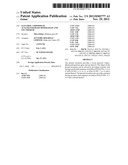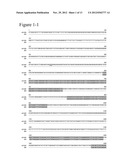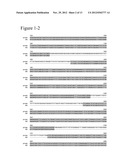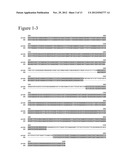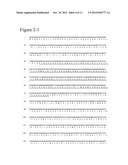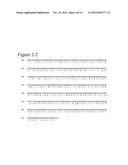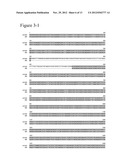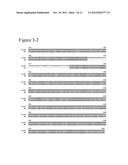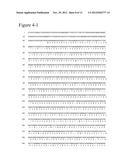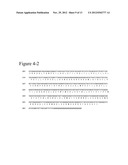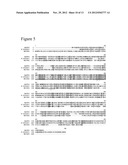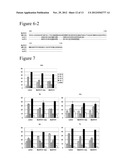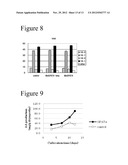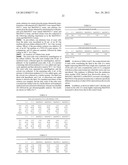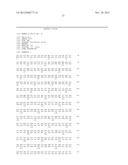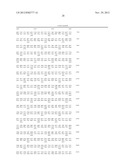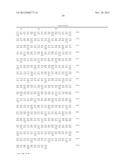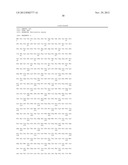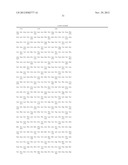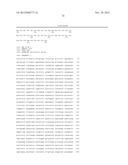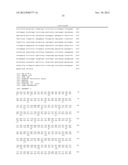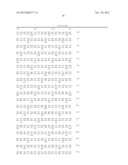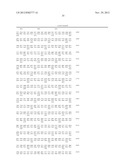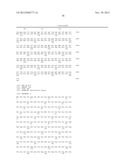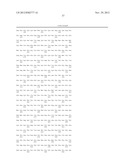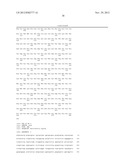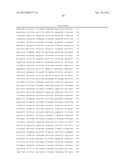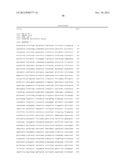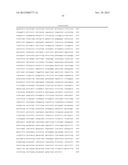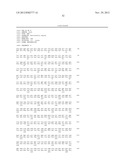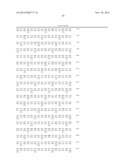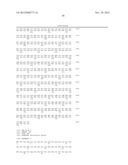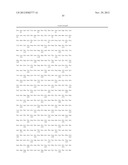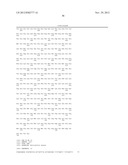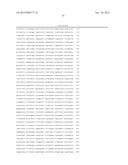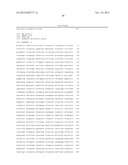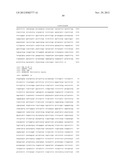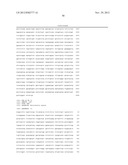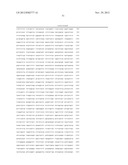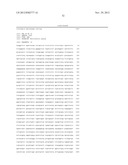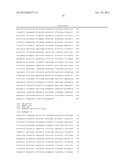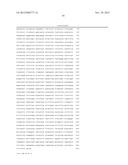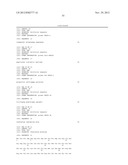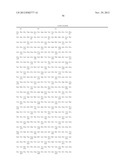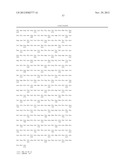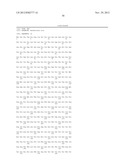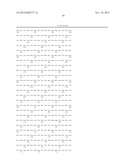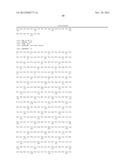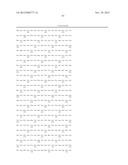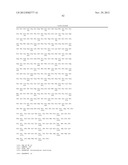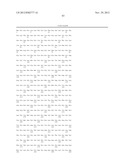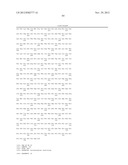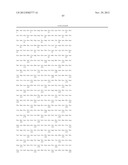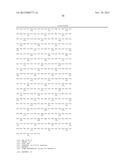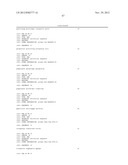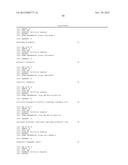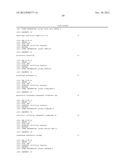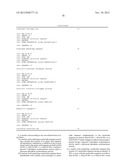Patent application title: GLYCEROL 3-PHOSPHATE ACYLTRANSFERASE HOMOLOGUE AND USE THEREOF
Inventors:
Misa Ochiai (Mishima-Gun, JP)
Assignees:
SUNTORY HOLDINGS LIMITED
IPC8 Class: AA23D902FI
USPC Class:
554 78
Class name: Organic compounds (class 532, subclass 1) fatty compounds having an acid moiety which contains the carbonyl of a carboxylic acid, salt, ester, or amide group bonded directly to one end of an acyclic chain of at least seven (7) uninterrupted carbons, wherein any additional carbonyl in the acid moiety is (1) part of an aldehyde or ketone group, (2) bonded directly to a noncarbon atom which is between the additional carbonyl and the chain, or (3) attached indirectly to the chain via ionic bonding phosphorus containing
Publication date: 2012-11-29
Patent application number: 20120302777
Abstract:
The present invention provides a novel glycerol
3-phosphateacyltransferase gene and use thereof. The object of the
present invention can be solved by providing a nucleic acid having a
nucleotide sequence set forth in SEQ ID NO: 1, 4, or 8, SEQ ID NO: 3, 6,
or 11, or SEQ ID NO: 7 or 12 and a mutant thereof. The present invention
also provides a protein having an amino acid sequence set forth in SEQ ID
NO: 2, 5, or 9 and a mutant thereof.Claims:
1. A nucleic acid according to any one selected from (a) to (g) below:
(a) a nucleic acid comprising a nucleotide sequence encoding a protein
that consists of an amino acid sequence having deletion, substitution, or
addition of one or more amino acids in the amino acid sequence set forth
in SEQ ID NO: 2, SEQ ID NO: 5, or SEQ ID NO: 9 and has a glycerol
3-phosphate acyltransferase activity and/or a glycerone phosphate
acyltransferase activity; (b) a nucleic acid comprising a nucleotide
sequence that is hybridizable with a nucleic acid consisting of a
nucleotide sequence complementary to the nucleotide sequence set forth in
SEQ ID NO: 1, SEQ ID NO: 4, or SEQ ID NO: 8 under stringent conditions
and encodes a protein having a glycerol 3-phosphate acyltransferase
activity and/or a glycerone phosphate acyltransferase activity; (c) a
nucleic acid comprising a nucleotide sequence that consists of a
nucleotide sequence having an identity of 70% or more with the nucleotide
sequence set forth in SEQ ID NO: 1, SEQ ID NO: 4, or SEQ ID NO: 8 and
encodes a protein having a glycerol 3-phosphate acyltransferase activity
and/or a glycerone phosphate acyltransferase activity, (d) a nucleic acid
comprising a nucleotide sequence encoding a protein that consists of an
amino acid sequence having an identity of 70% or more with the amino acid
sequence set forth in SEQ ID NO: 2, SEQ ID NO: 5, or SEQ ID NO: 9 and has
a glycerol 3-phosphate acyltransferase activity and/or a glycerone
phosphate acyltransferase activity; (e) a nucleic acid comprising a
nucleotide sequence that is hybridizable with a nucleic acid consisting
of a nucleotide sequence complementary to a nucleotide sequence encoding
a protein consisting of the amino acid sequence set forth in SEQ ID NO:
2, SEQ ID NO: 5, or SEQ ID NO: 9 under stringent conditions and encodes a
protein having a glycerol 3-phosphate acyltransferase activity and/or a
glycerone phosphate acyltransferase activity; (f) a nucleic acid
comprising a nucleotide sequence that is hybridizable with a nucleic acid
consisting of a nucleotide sequence complementary to the nucleotide
sequence set forth in SEQ ID NO: 7 or SEQ ID NO: 12 under stringent
conditions and includes an exon encoding a protein having a glycerol
3-phosphate acyltransferase activity and/or a glycerone phosphate
acyltransferase activity; and (g) a nucleic acid comprising a nucleotide
sequence that consists of a nucleotide sequence having an identity of 70%
or more with the nucleotide sequence set forth in SEQ ID NO: 7 or SEQ ID
NO: 12 and includes an exon encoding a protein having a glycerol
3-phosphate acyltransferase activity and/or a glycerone phosphate
acyltransferase activity.
2. The nucleic acid according to claim 1, wherein the nucleic acid is any one selected from (a) to (g) below: (a) a nucleic acid comprising a nucleotide sequence encoding a protein that consists of an amino acid sequence having deletion, substitution, or addition of 1 to 80 amino acids in the amino acid sequence set forth in SEQ ID NO: 2, SEQ ID NO: 5, or SEQ ID NO: 9 and has a glycerol 3-phosphate acyltransferase activity and/or a glycerone phosphate acyltransferase activity; (b) a nucleic acid comprising a nucleotide sequence that is hybridizable with a nucleic acid consisting of a nucleotide sequence complementary to the nucleotide sequence set forth in SEQ ID NO: 1, SEQ ID NO: 4, or SEQ ID NO: 8 under conditions of 2.times.SSC at 50.degree. C. and encodes a protein having a glycerol 3-phosphate acyltransferase activity and/or a glycerone phosphate acyltransferase activity, (c) a nucleic acid comprising a nucleotide sequence that consists of a nucleotide sequence having an identity of 90% or more with the nucleotide sequence set forth in SEQ ID NO: 1, SEQ ID NO: 4, or SEQ ID NO: 8 and encodes a protein having a glycerol 3-phosphate acyltransferase activity and/or a glycerone phosphate acyltransferase activity; (d) a nucleic acid comprising a nucleotide sequence encoding a protein that consists of an amino acid sequence having an identity of 90% or more with the amino acid sequence set forth in SEQ ID NO: 2, SEQ ID NO: 5, or SEQ ID NO: 9 and has a glycerol 3-phosphate acyltransferase activity and/or a glycerone phosphate acyltransferase activity; (e) a nucleic acid comprising a nucleotide sequence that is hybridizable with a nucleic acid consisting of a nucleotide sequence complementary to a nucleotide sequence encoding a protein consisting of the amino acid sequence set forth in SEQ ID NO: 2, SEQ ID NO: 5, or SEQ ID NO: 9 under conditions of 2.times.SSC at 50.degree. C. and encodes a protein having a glycerol 3-phosphate acyltransferase activity and/or a glycerone phosphate acyltransferase activity; (f) a nucleic acid comprising a nucleotide sequence that is hybridizable with a nucleic acid consisting of a nucleotide sequence complementary to the nucleotide sequence set forth in SEQ ID NO: 7 or SEQ ID NO: 12 under conditions of 2.times.SSC at 50.degree. C. and includes an exon encoding a protein having a glycerol 3-phosphate acyltransferase activity and/or a glycerone phosphate acyltransferase activity, and (g) a nucleic acid comprising a nucleotide sequence that consists of a nucleotide sequence having an identity of 90% or more with the nucleotide sequence set forth in SEQ ID NO: 7 or SEQ ID NO: 12 and includes an exon encoding a protein having a glycerol 3-phosphate acyltransferase activity and/or a glycerone phosphate acyltransferase activity.
3. A nucleic acid according to any one selected from (a) to (d) below: (a) a nucleic acid comprising the nucleotide sequence set forth in SEQ ID NO: 1, SEQ ID NO: 4, or SEQ ID NO: 8 or a fragment thereof; (b) a nucleic acid comprising a nucleotide sequence encoding a protein consisting of the amino acid sequence set forth in SEQ ID NO: 2, SEQ ID NO: 5, or SEQ ID NO: 9 or a fragment thereof; (c) a nucleic acid comprising the nucleotide sequence set forth in SEQ ID NO: 3, SEQ ID NO: 6, or SEQ ID NO: 11 or a fragment thereof; and (d) a nucleic acid comprising the nucleotide sequence set forth in SEQ ID NO: 7 or SEQ ID NO: 12 or a fragment thereof.
4. A nucleic acid according to any one selected from (a) to (g) below: (a) a nucleic acid comprising a nucleotide sequence encoding a protein that consists of an amino acid sequence having deletion, substitution, or addition of one or more amino acids in the amino acid sequence set forth in SEQ ID NO: 2, SEQ ID NO: 5, or SEQ ID NO: 9 and has any one of the following activities i) to v): i) an activity to develop a fatty acid composition containing palmitic acid at a higher proportion and palmitoleic acid at a lower proportion in yeast expressing the protein compared with those in a fatty acid composition in a host not expressing the protein; ii) an activity to generate higher contents of fatty acids in yeast expressing the protein compared with those in a host not expressing the protein; iii) an activity to generate a higher amount of triacylglycerol (TG) in yeast expressing the protein compared with TG in a host not expressing the protein; iv) an activity to complement glycerol 3-phosphate acyltransferase deficiency (hereinafter, also referred to as "GPAT deficiency") of yeast (S. cerevisiae); and v) an activity to increase production of arachidonic acid in a host transformed with a recombinant vector containing a nucleic acid encoding the protein compared with that in a host not transformed with the vector; (b) a nucleic acid comprising a nucleotide sequence that is hybridizable with a nucleic acid consisting of a nucleotide sequence complementary to the nucleotide sequence set forth in SEQ ID NO: 1, SEQ ID NO: 4, or SEQ ID NO: 8 under stringent conditions and encodes a protein having any one of the following activities i) to v): i) an activity to develop a fatty acid composition containing palmitic acid at a higher proportion and palmitoleic acid at a lower proportion in yeast expressing the protein compared with those in a fatty acid composition in a host not expressing the protein; ii) an activity to generate higher contents of fatty acids in yeast expressing the protein compared with those in a host not expressing the protein; iii) an activity to generate a higher amount of triacylglycerol (TG) in yeast expressing the protein compared with TG in a host not expressing the protein; iv) an activity to complement GPAT deficiency of yeast (S. cerevisiae); and v) an activity to increase production of arachidonic acid in a host transformed with a recombinant vector containing a nucleic acid encoding the protein compared with that in a host not transformed with the vector; (c) a nucleic acid comprising a nucleotide sequence that consists of a nucleotide sequence having an identity of 70% or more with the nucleotide sequence set forth in SEQ ID NO: 1, SEQ ID NO: 4, or SEQ ID NO: 8 and encodes a protein having any one of the following activities i) to v): i) an activity to develop a fatty acid composition containing palmitic acid at a higher proportion and palmitoleic acid at a lower proportion in yeast expressing the protein compared with those in a fatty acid composition in a host not expressing the protein; ii) an activity to generate higher contents of fatty acids in yeast expressing the protein compared with those in a host not expressing the protein; iii) an activity to generate a higher amount of triacylglycerol (TG) in yeast expressing the protein compared with TG in a host not expressing the protein; iv) an activity to complement GPAT deficiency of yeast (S. cerevisiae); and v) an activity to increase production of arachidonic acid in a host transformed with a recombinant vector containing a nucleic acid encoding the protein compared with that in a host not transformed with the vector; (d) a nucleic acid comprising a nucleotide sequence encoding a protein that consists of an amino acid sequence having an identity of 70% or more with the amino acid sequence set forth in SEQ ID NO: 2, SEQ ID NO: 5, or SEQ ID NO: 9 and has any one of the following activities i) to v): i) an activity to develop a fatty acid composition containing palmitic acid at a higher proportion and palmitoleic acid at a lower proportion in yeast expressing the protein compared with those in a fatty acid composition in a host not expressing the protein; ii) an activity to generate higher contents of fatty acids in yeast expressing the protein compared with those in a host not expressing the protein; iii) an activity to generate a higher amount of triacylglycerol (TG) in yeast expressing the protein compared with TG in a host not expressing the protein; iv) an activity to complement GPAT deficiency of yeast (S. cerevisiae); and v) an activity to increase production of arachidonic acid in a host transformed with a recombinant vector containing a nucleic acid encoding the protein compared with that in a host not transformed with the vector; (e) a nucleic acid comprising a nucleotide sequence that is hybridizable with a nucleic acid consisting of a nucleotide sequence complementary to a nucleotide sequence encoding a protein consisting of the amino acid sequence set forth in SEQ ID NO: 2, SEQ ID NO: 5, or SEQ ID NO: 9 under stringent conditions and encodes a protein having any one of the following activities i) to v): i) an activity to develop a fatty acid composition containing palmitic acid at a higher proportion and palmitoleic acid at a lower proportion in yeast expressing the protein compared with those in a fatty acid composition in a host not expressing the protein; ii) an activity to generate higher contents of fatty acids in yeast expressing the protein compared with those in a host not expressing the protein; iii) an activity to generate a higher amount of triacylglycerol (TG) in yeast expressing the protein compared with TG in a host not expressing the protein; iv) an activity to complement GPAT deficiency of yeast (S. cerevisiae); and v) an activity to increase production of arachidonic acid in a host transformed with a recombinant vector containing a nucleic acid encoding the protein compared with that in a host not transformed with the vector; (f) a nucleic acid comprising a nucleotide sequence that is hybridizable with a nucleic acid consisting of a nucleotide sequence complementary to the nucleotide sequence set forth in SEQ ID NO: 7 or SEQ ID NO: 12 under stringent conditions and includes an exon encoding a protein having any one of the following activities i) to v): i) an activity to develop a fatty acid composition containing palmitic acid at a higher proportion and palmitoleic acid at a lower proportion in yeast expressing the protein compared with those in a fatty acid composition in a host not expressing the protein; ii) an activity to generate higher contents of fatty acids in yeast expressing the protein compared with those in a host not expressing the protein; iii) an activity to generate a higher amount of triacylglycerol (TG) in yeast expressing the protein compared with TG in a host not expressing the protein; iv) an activity to complement GPAT deficiency of yeast (S. cerevisiae); and v) an activity to increase production of arachidonic acid in a host transformed with a recombinant vector containing a nucleic acid encoding the protein compared with that in a host not transformed with the vector; and (g) a nucleic acid comprising a nucleotide sequence that consists of a nucleotide sequence having an identity of 70% or more with the nucleotide sequence set forth in SEQ ID NO: 7 or SEQ ID NO: 12 and includes an exon encoding a protein having any one of the following activities i) to v): i) an activity to develop a fatty acid composition containing palmitic acid at a higher proportion and palmitoleic acid at a lower proportion in yeast expressing the protein compared with those in a fatty acid composition in a host not expressing the protein; ii) an activity to generate higher contents of fatty acids in yeast expressing the protein compared with those in a host not expressing the protein; iii) an activity to generate a higher amount of triacylglycerol (TG) in yeast expressing the protein compared with TG in a host not expressing the protein; iv) an activity to complement GPAT deficiency of yeast (S. cerevisiae); and v) an activity to increase production of arachidonic acid in a host transformed with a recombinant vector containing a nucleic acid encoding the protein compared with that in a host not transformed with the vector.
5. The nucleic acid according to claim 4, wherein the nucleic acid is any one selected from (a) to (g) below: (a) a nucleic acid comprising a nucleotide sequence including an exon encoding a protein that consists of an amino acid sequence having deletion, substitution, or addition of 1 to 80 amino acids in the amino acid sequence set forth in SEQ ID NO: 2, SEQ ID NO: 5, or SEQ ID NO: 9 and has any one of the following activities i) to v): i) an activity to develop a fatty acid composition containing palmitic acid at a higher proportion and palmitoleic acid at a lower proportion in yeast expressing the protein compared with those in a fatty acid composition in a host not expressing the protein; ii) an activity to generate higher contents of fatty acids in yeast expressing the protein compared with those in a host not expressing the protein; iii) an activity to generate a higher amount of triacylglycerol (TG) in yeast expressing the protein compared with TG in a host not expressing the protein; iv) an activity to complement GPAT deficiency of yeast (S. cerevisiae); and v) an activity to increase production of arachidonic acid in a host transformed with a recombinant vector containing a nucleic acid encoding the protein compared with that in a host not transformed with the vector; (b) a nucleic acid comprising a nucleotide sequence that is hybridizable with a nucleic acid consisting of a nucleotide sequence complementary to the nucleotide sequence set forth in SEQ ID NO: 1, SEQ ID NO: 4, or SEQ ID NO: 8 under conditions of 2.times.SSC at 50.degree. C. and includes an exon encoding a protein having any one of the following activities i) to v): i) an activity to develop a fatty acid composition containing palmitic acid at a higher proportion and palmitoleic acid at a lower proportion in yeast expressing the protein compared with those in a fatty acid composition in a host not expressing the protein; ii) an activity to generate higher contents of fatty acids in yeast expressing the protein compared with those in a host not expressing the protein; iii) an activity to generate a higher amount of triacylglycerol (TG) in yeast expressing the protein compared with TG in a host not expressing the protein; iv) an activity to complement GPAT deficiency of yeast (S. cerevisiae); and v) an activity to increase production of arachidonic acid in a host transformed with a recombinant vector containing a nucleic acid encoding the protein compared with that in a host not transformed with the vector; (c) a nucleic acid comprising a nucleotide sequence that has an identity of 90% or more with the nucleotide sequence set forth in SEQ ID NO: 1, SEQ ID NO: 4, or SEQ ID NO: 8 and includes an exon encoding a protein having any one of the following activities i) to v): i) an activity to develop a fatty acid composition containing palmitic acid at a higher proportion and palmitoleic acid at a lower proportion in yeast expressing the protein compared with those in a fatty acid composition in a host not expressing the protein; ii) an activity to generate higher contents of fatty acids in yeast expressing the protein compared with those in a host not expressing the protein; iii) an activity to generate a higher amount of triacylglycerol (TG) in yeast expressing the protein compared with TG in a host not expressing the protein; iv) an activity to complement GPAT deficiency of yeast (S. cerevisiae); and v) an activity to increase production of arachidonic acid in a host transformed with a recombinant vector containing a nucleic acid encoding the protein compared with that in a host not transformed with the vector; (d) a nucleic acid comprising a nucleotide sequence that includes an exon encoding a protein that consists of an amino acid sequence having an identity of 90% or more with the amino acid sequence set forth in SEQ ID NO: 2, SEQ ID NO: 5, or SEQ ID NO: 9 and has any one of the following activities i) to v): i) an activity to develop a fatty acid composition containing palmitic acid at a higher proportion and palmitoleic acid at a lower proportion in yeast expressing the protein compared with those in a fatty acid composition in a host not expressing the protein; ii) an activity to generate higher contents of fatty acids in yeast expressing the protein compared with those in a host not expressing the protein; iii) an activity to generate a higher amount of triacylglycerol (TG) in yeast expressing the protein compared with TG in a host not expressing the protein; iv) an activity to complement GPAT deficiency of yeast (S. cerevisiae); and v) an activity to increase production of arachidonic acid in a host transformed with a recombinant vector containing a nucleic acid encoding the protein compared with that in a host not transformed with the vector; (e) a nucleic acid comprising a nucleotide sequence that is hybridizable with a nucleic acid consisting of a nucleotide sequence complementary to a nucleotide sequence encoding a protein that consists of the amino acid sequence set forth in SEQ ID NO: 2, SEQ ID NO: 5, or SEQ ID NO: 9 under conditions of 2.times.SSC at 50.degree. C. and includes an exon encoding a protein having any one of the following activities i) to v): i) an activity to develop a fatty acid composition containing palmitic acid at a higher proportion and palmitoleic acid at a lower proportion in yeast expressing the protein compared with those in a fatty acid composition in a host not expressing the protein; ii) an activity to generate higher contents of fatty acids in yeast expressing the protein compared with those in a host not expressing the protein; iii) an activity to generate a higher amount of triacylglycerol (TG) in yeast expressing the protein compared with TG in a host not expressing the protein; iv) an activity to complement GPAT deficiency of yeast (S. cerevisiae); and v) an activity to increase production of arachidonic acid in a host transformed with a recombinant vector containing a nucleic acid encoding the protein compared with that in a host not transformed with the vector; (f) a nucleic acid comprising a nucleotide sequence that is hybridizable with a nucleic acid comprising a nucleotide sequence complementary to the nucleotide sequence set forth in SEQ ID NO: 7 or SEQ ID NO: 12 under conditions of 2.times.SSC at 50.degree. C. and includes an exon encoding a protein having any one of the following activities i) to v): i) an activity to develop a fatty acid composition containing palmitic acid at a higher proportion and palmitoleic acid at a lower proportion in yeast expressing the protein compared with those in a fatty acid composition in a host not expressing the protein; ii) an activity to generate higher contents of fatty acids in yeast expressing the protein compared with those in a host not expressing the protein; iii) an activity to generate a higher amount of triacylglycerol (TG) in yeast expressing the protein compared with TG in a host not expressing the protein; iv) an activity to complement GPAT deficiency of yeast (S. cerevisiae); and v) an activity to increase production of arachidonic acid in a host transformed with a recombinant vector containing a nucleic acid encoding the protein compared with that in a host not transformed with the vector; and (g) a nucleic acid comprising a nucleotide sequence that consists of a nucleotide sequence having an identity of 90% or more with the nucleotide sequence set forth in SEQ ID NO: 7 or SEQ ID NO: 12 and includes an exon encoding a protein having any one of the following activities i) to v): i) an activity to develop a fatty acid composition containing palmitic acid at a higher proportion and palmitoleic acid at a lower proportion in yeast expressing the protein compared with those in a fatty acid composition in a host not expressing the protein; ii) an activity to generate higher contents of fatty acids in yeast expressing the protein compared with those in a host not expressing the protein; iii) an activity to generate a higher amount of triacylglycerol (TG) in yeast expressing the protein compared with TG in a host not expressing the protein; iv) an activity to complement GPAT deficiency of yeast (S. cerevisiae); and v) an activity to increase production of arachidonic acid in a host transformed with a recombinant vector containing a nucleic acid encoding the protein compared with that in a host not transformed with the vector.
6. A protein selected from (a) and (b) below: (a) a protein consisting of an amino acid sequence having deletion, substitution, or addition of one or more amino acids in the amino acid sequence set forth in SEQ ID NO: 2, SEQ ID NO: 5, or SEQ ID NO: 9 and having a glycerol 3-phosphate acyltransferase activity and/or a glycerone phosphate acyltransferase activity; and (b) a protein consisting of an amino acid sequence having an identity of 70% or more with the amino acid sequence set forth in SEQ ID NO: 2, SEQ ID NO: 5, or SEQ ID NO: 9 and having a glycerol 3-phosphate acyltransferase activity and/or a glycerone phosphate acyltransferase activity.
7. A protein selected from (a) and (b) below: (a) a protein consisting of an amino acid sequence having deletion, substitution, or addition of 1 to 80 amino acids in the amino acid sequence set forth in SEQ ID NO: 2, SEQ ID NO: 5, or SEQ ID NO: 9 and having a glycerol 3-phosphate acyltransferase activity and/or a glycerone phosphate acyltransferase activity; and (b) a protein consisting of an amino acid sequence having an identity of 90% or more with the amino acid sequence set forth in SEQ ID NO: 2, SEQ ID NO: 5, or SEQ ID NO: 9 and having a glycerol 3-phosphate acyltransferase activity and/or a glycerone phosphate acyltransferase activity.
8. A protein selected from (a) and (b) below: (a) a protein consisting of an amino acid sequence having deletion, substitution, or addition of one or more amino acids in the amino acid sequence set forth in SEQ ID NO: 2, SEQ ID NO: 5, or SEQ ID NO: 9 and having any one of the following activities i) to v): i) an activity to develop a fatty acid composition containing palmitic acid at a higher proportion and palmitoleic acid at a lower proportion in yeast expressing the protein compared with those in a fatty acid composition in a host not expressing the protein; ii) an activity to generate higher contents of fatty acids in yeast expressing the protein compared with those in a host not expressing the protein; iii) an activity to generate a higher amount of triacylglycerol (TG) in yeast expressing the protein compared with TG in a host not expressing the protein; iv) an activity to complement GPAT deficiency of yeast (S. cerevisiae); and v) an activity to increase production of arachidonic acid in a host transformed with a recombinant vector containing a nucleic acid encoding the protein compared with that in a host not transformed with the vector; and (b) a protein consisting of an amino acid sequence having an identity of 70% or more with the amino acid sequence set forth in SEQ ID NO: 2, SEQ ID NO: 5, or SEQ ID NO: 9 and having any one of the following activities i) to v): i) an activity to develop a fatty acid composition containing palmitic acid at a higher proportion and palmitoleic acid at a lower proportion in yeast expressing the protein compared with those in a fatty acid composition in a host not expressing the protein; ii) an activity to generate higher contents of fatty acids in yeast expressing the protein compared with those in a host not expressing the protein; iii) an activity to generate a higher amount of triacylglycerol (TG) in yeast expressing the protein compared with TG in a host not expressing the protein; iv) an activity to complement GPAT deficiency of yeast (S. cerevisiae); and v) an activity to increase production of arachidonic acid in a host transformed with a recombinant vector containing a nucleic acid encoding the protein compared with that in a host not transformed with the vector.
9. A protein selected from (a) and (b) below: (a) a protein consisting of an amino acid sequence having deletion, substitution, or addition of 1 to 80 amino acids in the amino acid sequence set forth in SEQ ID NO: 2, SEQ ID NO: 5, or SEQ ID NO: 9 and having any one of the following activities i) to v): i) an activity to develop a fatty acid composition containing palmitic acid at a higher proportion and palmitoleic acid at a lower proportion in yeast expressing the protein compared with those in a fatty acid composition in a host not expressing the protein; ii) an activity to generate higher contents of fatty acids in yeast expressing the protein compared with those in a host not expressing the protein; iii) an activity to generate a higher amount of triacylglycerol (TG) in yeast expressing the protein compared with TG in a host not expressing the protein; iv) an activity to complement GPAT deficiency of yeast (S. cerevisiae); and v) an activity to increase production of arachidonic acid in a host transformed with a recombinant vector containing a nucleic acid encoding the protein compared with that in a host not transformed with the vector; and (b) a protein consisting of an amino acid sequence having an identity of 90% or more with the amino acid sequence set forth in SEQ ID NO: 2, SEQ ID NO: 5, or SEQ ID NO: 9 and having any one of the following activities i) to v): i) an activity to develop a fatty acid composition containing palmitic acid at a higher proportion and palmitoleic acid at a lower proportion in yeast expressing the protein compared with those in a fatty acid composition in a host not expressing the protein; ii) an activity to generate higher contents of fatty acids in yeast expressing the protein compared with those in a host not expressing the protein; iii) an activity to generate a higher amount of triacylglycerol (TG) in yeast expressing the protein compared with TG in a host not expressing the protein; iv) an activity to complement GPAT deficiency of yeast (S. cerevisiae); and v) an activity to increase production of arachidonic acid in a host transformed with a recombinant vector containing a nucleic acid encoding the protein compared with that in a host not transformed with the vector.
10. A protein consisting of the amino acid sequence set forth in SEQ ID NO: 2, SEQ ID NO: 5, or SEQ ID NO: 9.
11. A recombinant vector comprising the nucleic acid according to claim 1.
12. A transformant transformed with the recombinant vector according to claim 11.
13. A fatty acid composition comprising a fatty acid or a lipid obtainable by culturing the transformant according to claim 12.
14. A method of producing a fatty acid composition, comprising collecting a fatty acid or a lipid from a culture obtained by culturing the transformant according to claim 12.
15. A food comprising the fatty acid composition according to claim 13.
Description:
TECHNICAL FIELD
[0001] The present invention relates to a novel acyltransferase gene and use thereof. The acyltransferase gene of the present invention may be a glycerol 3-phosphate acyltransferase (GPAT) gene and/or a glycerone phosphate O-acyltransferase (GNPAT) gene.
BACKGROUND ART
[0002] Fatty acids are important components constituting lipids such as phospholipid and triacylglycerol. Fatty acids having two or more unsaturated bond sites are collectively called polyunsaturated fatty acids (PUFAs). Specifically, for example, arachidonic acid, dihomo-γ-linolenic acid, eicosapentaenoic acid, and docosahexaenoic acid are known, and various bioactivities thereof have been reported (Non-Patent Literature 1). Some of the polyunsaturated fatty acids cannot be synthesized in animal bodies, and such polyunsaturated fatty acids should be ingested from foods as essential fatty acids.
[0003] In animal bodies, the polyunsaturated fatty acids are contained in various organs and tissues. For example, arachidonic acid is isolated from lipids extracted from suprarenal gland and liver of animals. The amounts of these polyunsaturated fatty acids contained in animal organs are, however, small, and the polyunsaturated fatty acids extracted and isolated from animal organs only are insufficient for a large amount of supply thereof. Thus, microbial techniques have been developed for obtaining polyunsaturated fatty acids by culturing various microorganisms. In particular, microorganisms in the genera Mortierella are known to efficiently produce lipids containing polyunsaturated fatty acids such as arachidonic acid. Other attempts have also been made to produce polyunsaturated fatty acids in plants. Polyunsaturated fatty acids are known to constitute reserve lipids such as triacylglycerol and accumulate within microorganism cells or plant seeds.
[0004] Triacylglycerol as a reserve lipid is generated in living bodies as follows: An acyl group is transferred to glycerol 3-phosphate by glycerol 3-phosphate acyltransferase to generate lysophosphatidic acid. Another acyl group is transferred to the lysophosphatidic acid by lysophosphatidic acid acyltransferase to generate phosphatidic acid. The phosphatidic acid is dephosphorylated by phosphatidic acid phosphatase to generate diacylglycerol. A further acyl group is transferred to the diacylglycerol by diacylglycerol acyltransferase to ultimately generate triacylglycerol.
[0005] It is known that in the triacylglycerol biosynthetic pathway or the phospholipid biosynthetic pathway mentioned above, glycerol 3-phosphate acyltransferase (hereinafter, also referred to as "GPAT": EC 2.3.1.15) involves a reaction generating lysophosphatidic acid through acylation of glycerol 3-phosphate.
[0006] Existence of a GPAT gene has been reported in some organisms. As GPAT genes derived from mammals, two types of GPAT genes, i.e., a microsomal type (membrane-bound form) and a mitochondrial type (membrane-bound form), have been cloned (Non-Patent Literature 2). As GPAT genes derived from plants, three types of GPAT genes, i.e., a microsomal type (membrane-bound form), a mitochondrial type (membrane-bound form), and a chloroplast type (free form), have been cloned (Non-Patent Literature 3).
[0007] As GPAT genes derived from fungi, Saccharomyces cerevisiae, two types of GPAT genes, i.e., microsomal type (membrane-bound form) GPT2/GAT1 (YKR067w) and SCT1/GAT2 (YBL011w), have been cloned, and it is known that simultaneous deletion of these types of GPAT genes results in death (Non-Patent Literature 4). It has been shown that GPT2 has an activity showing broad substrate specificity to fatty acids from palmitic acid (16:0) to oleic acid (18:1), whereas SCT1 shows high substrate selectivity to fatty acids having 16 carbon atoms such as palmitic acid (16:0) and palmitoleic acid (16:1) (Non-Patent Literature 4).
[0008] In addition, the GPAT gene has been cloned from various biological species. In particular, GPAT derived from a lipid-producing fungus, the genera Mortierella, is reported as follows.
[0009] Regarding GPAT derived from Mortierella ramanniana, a microsomal type GPAT has been isolated, and it has been shown that this GPAT preferentially uses oleic acid (18:1) as an acyl donor with a selectivity as 5.4 times high as that to palmitic acid (16:0) (Non-Patent Literature 5). Regarding GPAT derived from Mortierella alpina (hereinafter, also referred to as "M. alpina"), it has been reported that a glycerol 3-phosphate acyltransferase activity resides in a microsomal fraction (Non-Patent Literature 6).
[0010] It has been shown that, when GPAT (membrane-bound form) present in microsome of M. alpina is reacted with various acyl-CoAs in vitro, the GPAT uses a broad range of polyunsaturated fatty acids, such as oleic acid (18:1), linoleic acid (18:2), dihomo-γ-linolenic acid (DGLA) (20:3), and arachidonic acid (20:4), as substrates, with maitaining its high activity (Patent Literature 1).
[0011] It has been shown that GPAT cloned from M. alpina (ATCC No. 16266) (hereinafter, referred to as MaGPAT1 (ATCC No. 16266)) was expressed in Yarrowia lipolytica that had been transformed such that eicosapentaenoic acid (EPA) can be biosynthesized, and as a result, a proportion of dihomo-γ-linolenic acid (DGLA) (20:3) increased, whereas a proportion of oleic acid (18:1) decreased, among the total fatty acids. This demonstrated that a polyunsaturated fatty acid having a longer chain and a higher degree of unsaturation was selectively incorporated (Patent Literature 2).
[0012] In recent studies, a GPAT homolog, MaGPAT2, was isolated from M. alpina (strain 1S-4), and it has been reported that the homolog has a substrate specificity different from that of MaGPAT1 (Patent Literature 3). That is, when they are expressed in yeast, MaGPAT1 increases the content of palmitic acid in the lipid produced by the yeast, whereas MaGPAT2 increases the content of oleic acid in the lipid produced by the yeast.
CITATION LIST
Patent Literature
[0013] Patent Literature 1: International Publication No. WO2004/087902 [0014] Patent Literature 2: U.S. Patent Publication No. 2006/0094091 [0015] Patent Literature 3: International Publication No. WO2008/156026
Non-Patent Literature
[0015] [0016] Non-Patent Literature 1: Lipids, 39, 1147-1161, 2004 [0017] Non-Patent Literature 2: Biochimica et Biophysica Acta, 1348, 17-26, 1997 [0018] Non-Patent Literature 3: Biochimica et Biophysica Acta, 1348, 10-16, 1997 [0019] Non-Patent Literature 4: The Journal of Biological Chemistry, 276 (45), 41710-41716, 2001 [0020] Non-Patent Literature 5: The Biochemical Journal, 355, 315-322, 2001 [0021] Non-Patent Literature 6: Biochemical Society Transactions, 28, 707-709, 2000
SUMMARY OF INVENTION
Technical Problem
[0022] When the previously reported GPAT genes are introduced into host cells and are expressed therein, a fatty acid composition produced by the host is restricted by their substrate specificity. Identification of a novel gene that can produce an intended fatty acid composition by introduction or expression in a host cell is required.
[0023] It is an object of the present invention to provide a protein and a nucleic acid that can achieve production of a fat having an intended compositional ratio of fatty acids, can increase the content of an intended fatty acid, or can increase the amount of a reserve lipid, triacylglycerol (TG), through expression or introduction in the host cells.
Solution to Problem
[0024] The present inventor has diligently studied to solve the above-mentioned problems. First, the inventor has analyzed the genome of a lipid-producing fungus, Mortierella alpina, and extracted sequences having a high ddgree of homology with known glycerol 3-phosphate acyltransferase (GPAT) genes from the genome. Further, in order to obtain a full-length of the open reading frame (ORF) encoding GPAT, a full-length cDNA was cloned by screening or PCR of a cDNA library. The present inventor has tried producing a fatty acid composition by introducing the gene into host cells having high proliferative ability, such as yeast, and as a result, the inventor has successfully cloned a gene related to a novel GPAT that has a different substrate specificity and can generate a fatty acid composition different from the fatty acid composition produced by the host cells expressing conventional GPAT, and the present invention has been accomplished. That is, the present invention is as follows.
[0025] (1) A nucleic acid according to any one selected from (a) to (g) below:
[0026] (a) a nucleic acid comprising a nucleotide sequence encoding a protein that consists of an amino acid sequence having deletion, substitution, or addition of one or more amino acids in the amino acid sequence set forth in SEQ ID NO: 2, SEQ ID NO: 5, or SEQ ID NO: 9 and has a glycerol 3-phosphate acyltransferase activity and/or a glycerone phosphate acyltransferase activity;
[0027] (b) a nucleic acid comprising a nucleotide sequence that is hybridizable with a nucleic acid consisting of a nucleotide sequence complementary to the nucleotide sequence set forth in SEQ ID NO: 1, SEQ ID NO: 4, or SEQ ID NO: 8 under stringent conditions and encodes a protein having a glycerol 3-phosphate acyltransferase activity and/or a glycerone phosphate acyltransferase activity;
[0028] (c) a nucleic acid comprising a nucleotide sequence that consists of a nucleotide sequence having an identity of 70% or more with the nucleotide sequence set forth in SEQ ID NO: 1, SEQ ID NO: 4, or SEQ ID NO: 8 and encodes a protein having a glycerol 3-phosphate acyltransferase activity and/or a glycerone phosphate acyltransferase activity;
[0029] (d) a nucleic acid comprising a nucleotide sequence encoding a protein that consists of an amino acid sequence having an identity of 70% or more with the amino acid sequence set forth in SEQ ID NO: 2, SEQ ID NO: 5, or SEQ ID NO: 9 and has a glycerol 3-phosphate acyltransferase activity and/or a glycerone phosphate acyltransferase activity;
[0030] (e) a nucleic acid comprising a nucleotide sequence that is hybridizable with a nucleic acid consisting of a nucleotide sequence complementary to a nucleotide sequence encoding a protein consisting of the amino acid sequence set forth in SEQ ID NO: 2, SEQ ID NO: 5, or SEQ ID NO: 9 under stringent conditions and encodes a protein having a glycerol 3-phosphate acyltransferase activity and/or a glycerone phosphate acyltransferase activity;
[0031] (f) a nucleic acid comprising a nucleotide sequence that is hybridizable with a nucleic acid consisting of a nucleotide sequence complementary to the nucleotide sequence set forth in SEQ ID NO: 7 or SEQ ID NO: 12 under stringent conditions and includes an exon encoding a protein having a glycerol 3-phosphate acyltransferase activity and/or a glycerone phosphate acyltransferase activity; and
[0032] (g) a nucleic acid comprising a nucleotide sequence that consists of a nucleotide sequence having an identity of 70% or more with the nucleotide sequence set forth in SEQ ID NO: 7 or SEQ ID NO: 12 and includes an exon encoding a protein having a glycerol 3-phosphate acyltransferase activity and/or a glycerone phosphate acyltransferase activity.
[0033] (2) The nucleic acid according to aspect (1), wherein the nucleic acid is any one selected from (a) to (g) below:
[0034] (a) a nucleic acid comprising a nucleotide sequence encoding a protein that consists of an amino acid sequence having deletion, substitution, or addition of 1 to 80 amino acids in the amino acid sequence set forth in SEQ ID NO: 2, SEQ ID NO: 5, or SEQ ID NO: 9 and has a glycerol 3-phosphate acyltransferase activity and/or a glycerone phosphate acyltransferase activity;
[0035] (b) a nucleic acid comprising a nucleotide sequence that is hybridizable with a nucleic acid consisting of a nucleotide sequence complementary to the nucleotide sequence set forth in SEQ ID NO: 1, SEQ ID NO: 4, or SEQ ID NO: 8 under conditions of 2×SSC at 50° C. and encodes a protein having a glycerol 3-phosphate acyltransferase activity and/or a glycerone phosphate acyltransferase activity;
[0036] (c) a nucleic acid comprising a nucleotide sequence that consists of a nucleotide sequence having an identity of 90% or more with the nucleotide sequence set forth in SEQ ID NO: 1, SEQ ID NO: 4, or SEQ ID NO: 8 and encodes a protein having a glycerol 3-phosphate acyltransferase activity and/or a glycerone phosphate acyltransferase activity;
[0037] (d) a nucleic acid comprising a nucleotide sequence encoding a protein that consists of an amino acid sequence having an identity of 90% or more with the amino acid sequence set forth in SEQ ID NO: 2, SEQ ID NO: 5, or SEQ ID NO: 9 and has a glycerol 3-phosphate acyltransferase activity and/or a glycerone phosphate acyltransferase activity;
[0038] (e) a nucleic acid comprising a nucleotide sequence that is hybridizable with a nucleic acid consisting of a nucleotide sequence complementary to a nucleotide sequence encoding a protein consisting of the amino acid sequence set forth in SEQ ID NO: 2, SEQ ID NO: 5, or SEQ ID NO: 9 under conditions of 2×SSC at 50° C. and encodes a protein having a glycerol 3-phosphate acyltransferase activity and/or a glycerone phosphate acyltransferase activity;
[0039] (f) a nucleic acid comprising a nucleotide sequence that is hybridizable with a nucleic acid consisting of a nucleotide sequence complementary to the nucleotide sequence set forth in SEQ ID NO: 7 or SEQ ID NO: 12 under conditions of 2×SSC at 50° C. and includes an exon encoding a protein having a glycerol 3-phosphate acyltransferase activity and/or a glycerone phosphate acyltransferase activity; and
[0040] (g) a nucleic acid comprising a nucleotide sequence that consists of a nucleotide sequence having an identity of 90% or more with the nucleotide sequence set forth in SEQ ID NO: 7 or SEQ ID NO: 12 and includes an exon encoding a protein having a glycerol 3-phosphate acyltransferase activity and/or a glycerone phosphate acyltransferase activity.
[0041] (3) A nucleic acid according to any one selected from (a) to (d) below:
[0042] (a) a nucleic acid comprising the nucleotide sequence set forth in SEQ ID NO: 1, SEQ ID NO: 4, or SEQ ID NO: 8 or a fragment thereof;
[0043] (b) a nucleic acid comprising a nucleotide sequence encoding a protein consisting of the amino acid sequence set forth in SEQ ID NO: 2, SEQ ID NO: 5, or SEQ ID NO: 9 or a fragment thereof;
[0044] (c) a nucleic acid comprising the nucleotide sequence set forth in SEQ ID NO: 3, SEQ ID NO: 6, or SEQ ID NO: 11 or a fragment thereof; and
[0045] (d) a nucleic acid comprising the nucleotide sequence set forth in SEQ ID NO: 7 or SEQ ID NO: 12 or a fragment thereof.
[0046] (4) A nucleic acid according to any one selected from (a) to (g) below:
[0047] (a) a nucleic acid comprising a nucleotide sequence encoding a protein that consists of an amino acid sequence having deletion, substitution, or addition of one or more amino acids in the amino acid sequence set forth in SEQ ID NO: 2, SEQ ID NO: 5, or SEQ ID NO: 9 and has any one of the following activities i) to v):
[0048] i) an activity to develop a fatty acid composition containing palmitic acid at a higher proportion and palmitoleic acid at a lower proportion in yeast expressing the protein compared with those in a fatty acid composition in a host not expressing the protein;
[0049] ii) an activity to generate higher contents of fatty acids in yeast expressing the protein compared with those in a host not expressing the protein;
[0050] iii) an activity to generate a higher amount of triacylglycerol (TG) in yeast expressing the protein compared with TG in a host not expressing the protein;
[0051] iv) an activity to complement glycerol 3-phosphate acyltransferase deficiency (hereinafter, also referred to as "GPAT deficiency") of yeast (S. cerevisiae); and
[0052] v) an activity to increase production of arachidonic acid in a host transformed with a recombinant vector containing a nucleic acid encoding the protein compared with that in a host not transformed with the vector;
[0053] (b) a nucleic acid comprising a nucleotide sequence that is hybridizable with a nucleic acid consisting of a nucleotide sequence complementary to the nucleotide sequence set forth in SEQ ID NO: 1, SEQ ID NO: 4, or SEQ ID NO: 8 under stringent conditions and encodes a protein having any one of the following activities i) to v):
[0054] i) an activity to develop a fatty acid composition containing palmitic acid at a higher proportion and palmitoleic acid at a lower proportion in yeast expressing the protein compared with those in a fatty acid composition in a host not expressing the protein;
[0055] ii) an activity to generate higher contents of fatty acids in yeast expressing the protein compared with those in a host not expressing the protein;
[0056] iii) an activity to generate a higher amount of triacylglycerol (TG) in yeast expressing the protein compared with TG in a host not expressing the protein;
[0057] iv) an activity to complement GPAT deficiency of yeast (S. cerevisiae); and
[0058] v) an activity to increase production of arachidonic acid in a host transformed with a recombinant vector containing a nucleic acid encoding the protein compared with that in a host not transformed with the vector;
[0059] (c) a nucleic acid comprising a nucleotide sequence that consists of a nucleotide sequence having an identity of 70% or more with the nucleotide sequence set forth in SEQ ID NO: 1, SEQ ID NO: 4, or SEQ ID NO: 8 and encodes a protein having any one of the following activities i) to v):
[0060] i) an activity to develop a fatty acid composition containing palmitic acid at a higher proportion and palmitoleic acid at a lower proportion in yeast expressing the protein compared with those in a fatty acid composition in a host not expressing the protein;
[0061] ii) an activity to generate higher contents of fatty acids in yeast expressing the protein compared with those in a host not expressing the protein;
[0062] iii) an activity to generate a higher amount of triacylglycerol (TG) in yeast expressing the protein compared with TG in a host not expressing the protein;
[0063] iv) an activity to complement GPAT deficiency of yeast (S. cerevisiae); and
[0064] v) an activity to increase production of arachidonic acid in a host transformed with a recombinant vector containing a nucleic acid encoding the protein compared with that in a host not transformed with the vector;
[0065] (d) a nucleic acid comprising a nucleotide sequence encoding a protein that consists of an amino acid sequence having an identity of 70% or more with the amino acid sequence set forth in SEQ ID NO: 2, SEQ ID NO: 5, or SEQ ID NO: 9 and has any one of the following activities i) to v):
[0066] i) an activity to develop a fatty acid composition containing palmitic acid at a higher proportion and palmitoleic acid at a lower proportion in yeast expressing the protein compared with those in a fatty acid composition in a host not expressing the protein;
[0067] ii) an activity to generate higher contents of fatty acids in yeast expressing the protein compared with those in a host not expressing the protein;
[0068] iii) an activity to generate a higher amount of triacylglycerol (TG) in yeast expressing the protein compared with TG in a host not expressing the protein;
[0069] iv) an activity to complement GPAT deficiency of yeast (S. cerevisiae); and
[0070] v) an activity to increase production of arachidonic acid in a host transformed with a recombinant vector containing a nucleic acid encoding the protein compared with that in a host not transformed with the vector;
[0071] (e) a nucleic acid comprising a nucleotide sequence that is hybridizable with a nucleic acid consisting of a nucleotide sequence complementary to a nucleotide sequence encoding a protein consisting of the amino acid sequence set forth in SEQ ID NO: 2, SEQ ID NO: 5, or SEQ ID NO: 9 under stringent conditions and encodes a protein having any one of the following activities i) to v):
[0072] i) an activity to develop a fatty acid composition containing palmitic acid at a higher proportion and palmitoleic acid at a lower proportion in yeast expressing the protein compared with those in a fatty acid composition in a host not expressing the protein;
[0073] ii) an activity to generate higher contents of fatty acids in yeast expressing the protein compared with those in a host not expressing the protein;
[0074] iii) an activity to generate a higher amount of triacylglycerol (TG) in yeast expressing the protein compared with TG in a host not expressing the protein;
[0075] iv) an activity to complement GPAT deficiency of yeast (S. cerevisiae); and
[0076] v) an activity to increase production of arachidonic acid in a host transformed with a recombinant vector containing a nucleic acid encoding the protein compared with that in a host not transformed with the vector;
[0077] (f) a nucleic acid comprising a nucleotide sequence that is hybridizable with a nucleic acid consisting of a nucleotide sequence complementary to the nucleotide sequence set forth in SEQ ID NO: 7 or SEQ ID NO: 12 under stringent conditions and includes an exon encoding a protein having any one of the following activities i) to v):
[0078] i) an activity to develop a fatty acid composition containing palmitic acid at a higher proportion and palmitoleic acid at a lower proportion in yeast expressing the protein compared with those in a fatty acid composition in a host not expressing the protein;
[0079] ii) an activity to generate higher contents of fatty acids in yeast expressing the protein compared with those in a host not expressing the protein;
[0080] iii) an activity to generate a higher amount of triacylglycerol (TG) in yeast expressing the protein compared with TG in a host not expressing the protein;
[0081] iv) an activity to complement GPAT deficiency of yeast (S. cerevisiae); and
[0082] v) an activity to increase production of arachidonic acid in a host transformed with a recombinant vector containing a nucleic acid encoding the protein compared with that in a host not transformed with the vector; and
[0083] (g) a nucleic acid comprising a nucleotide sequence that consists of a nucleotide sequence having an identity of 70% or more with the nucleotide sequence set forth in SEQ ID NO: 7 or SEQ ID NO: 12 and includes an exon encoding a protein having any one of the following activities i) to v):
[0084] i) an activity to develop a fatty acid composition containing palmitic acid at a higher proportion and palmitoleic acid at a lower proportion in yeast expressing the protein compared with those in a fatty acid composition in a host not expressing the protein;
[0085] ii) an activity to generate higher contents of fatty acids in yeast expressing the protein compared with those in a host not expressing the protein;
[0086] iii) an activity to generate a higher amount of triacylglycerol (TG) in yeast expressing the protein compared with TG in a host not expressing the protein;
[0087] iv) an activity to complement GPAT deficiency of yeast (S. cerevisiae); and
[0088] v) an activity to increase production of arachidonic acid in a host transformed with a recombinant vector containing a nucleic acid encoding the protein compared with that in a host not transformed with the vector.
[0089] (5) The nucleic acid according to aspect (4), wherein the nucleic acid is any one selected from (a) to (g) below:
[0090] (a) a nucleic acid comprising a nucleotide sequence including an exon encoding a protein that consists of an amino acid sequence having deletion, substitution, or addition of 1 to 80 amino acids in the amino acid sequence set forth in SEQ ID NO: 2, SEQ ID NO: 5, or SEQ ID NO: 9 and has any one of the following activities i) to v):
[0091] i) an activity to develop a fatty acid composition containing palmitic acid at a higher proportion and palmitoleic acid at a lower proportion in yeast expressing the protein compared with those in a fatty acid composition in a host not expressing the protein;
[0092] ii) an activity to generate higher contents of fatty acids in yeast expressing the protein compared with those in a host not expressing the protein;
[0093] iii) an activity to generate a higher amount of triacylglycerol (TG) in yeast expressing the protein compared with TG in a host not expressing the protein; iv) an activity to complement GPAT deficiency of yeast (S. cerevisiae); and
[0094] v) an activity to increase production of arachidonic acid in a host transformed with a recombinant vector containing a nucleic acid encoding the protein compared with that in a host not transformed with the vector;
[0095] (b) a nucleic acid comprising a nucleotide sequence that is hybridizable with a nucleic acid consisting of a nucleotide sequence complementary to the nucleotide sequence set forth in SEQ ID NO: 1, SEQ ID NO: 4, or SEQ ID NO: 8 under conditions of 2×SSC at 50° C. and includes an exon encoding a protein having any one of the following activities i) to v):
[0096] i) an activity to develop a fatty acid composition containing palmitic acid at a higher proportion and palmitoleic acid at a lower proportion in yeast expressing the protein compared with those in a fatty acid composition in a host not expressing the protein;
[0097] ii) an activity to generate higher contents of fatty acids in yeast expressing the protein compared with those in a host not expressing the protein;
[0098] iii) an activity to generate a higher amount of triacylglycerol (TG) in yeast expressing the protein compared with TG in a host not expressing the protein;
[0099] iv) an activity to complement GPAT deficiency of yeast (S. cerevisiae); and
[0100] v) an activity to increase production of arachidonic acid in a host transformed with a recombinant vector containing a nucleic acid encoding the protein compared with that in a host not transformed with the vector;
[0101] (c) a nucleic acid comprising a nucleotide sequence that consists of a nucleotide sequence having an identity of 90% or more with the nucleotide sequence set forth in SEQ ID NO: 1, SEQ ID NO: 4, or SEQ ID NO: 8 and includes an exon encoding a protein having any one of the following activities i) to v):
[0102] i) an activity to develop a fatty acid composition containing palmitic acid at a higher proportion and palmitoleic acid at a lower proportion in yeast expressing the protein compared with those in a fatty acid composition in a host not expressing the protein;
[0103] ii) an activity to generate higher contents of fatty acids in yeast expressing the protein compared with those in a host not expressing the protein;
[0104] iii) an activity to generate a higher amount of triacylglycerol (TG) in yeast expressing the protein compared with TG in a host not expressing the protein;
[0105] iv) an activity to complement GPAT deficiency of yeast (S. cerevisiae); and
[0106] v) an activity to increase production of arachidonic acid in a host transformed with a recombinant vector containing a nucleic acid encoding the protein compared with that in a host not transformed with the vector;
[0107] (d) a nucleic acid comprising a nucleotide sequence that includes an exon encoding a protein that consists of an amino acid sequence having an identity of 90% or more with the amino acid sequence set forth in SEQ ID NO: 2, SEQ ID NO: 5, or SEQ ID NO: 9 and has any one of the following activities i) to v):
[0108] i) an activity to develop a fatty acid composition containing palmitic acid at a higher proportion and palmitoleic acid at a lower proportion in yeast expressing the protein compared with those in a fatty acid composition in a host not expressing the protein;
[0109] ii) an activity to generate higher contents of fatty acids in yeast expressing the protein compared with those in a host not expressing the protein;
[0110] iii) an activity to generate a higher amount of triacylglycerol (TG) in yeast expressing the protein compared with TG in a host not expressing the protein;
[0111] iv) an activity to complement GPAT deficiency of yeast (S. cerevisiae); and
[0112] v) an activity to increase production of arachidonic acid in a host transformed with a recombinant vector containing a nucleic acid encoding the protein compared with that in a host not transformed with the vector;
[0113] (e) a nucleic acid comprising a nucleotide sequence that is hybridizable with a nucleic acid consisting of a nucleotide sequence complementary to a nucleotide sequence encoding a protein that consists of the amino acid sequence set forth in SEQ ID NO: 2, SEQ ID NO: 5, or SEQ ID NO: 9 under conditions of 2×SSC at 50° C. and includes an exon encoding a protein having any one of the following activities i) to v):
[0114] i) an activity to develop a fatty acid composition containing palmitic acid at a higher proportion and palmitoleic acid at a lower proportion in yeast expressing the protein compared with those in a fatty acid composition in a host not expressing the protein;
[0115] ii) an activity to generate higher contents of fatty acids in yeast expressing the protein compared with those in a host not expressing the protein;
[0116] iii) an activity to generate a higher amount of triacylglycerol (TG) in yeast expressing the protein compared with TG in a host not expressing the protein;
[0117] iv) an activity to complement GPAT deficiency of yeast (S. cerevisiae); and
[0118] v) an activity to increase production of arachidonic acid in a host transformed with a recombinant vector containing a nucleic acid encoding the protein compared with that in a host not transformed with the vector;
[0119] (f) a nucleic acid comprising a nucleotide sequence that is hybridizable with a nucleic acid comprising a nucleotide sequence complementary to the nucleotide sequence set forth in SEQ ID NO: 7 or SEQ ID NO: 12 under conditions of 2×SSC at 50° C. and includes an exon encoding a protein having any one of the following activities i) to v):
[0120] i) an activity to develop a fatty acid composition containing palmitic acid at a higher proportion and palmitoleic acid at a lower proportion in yeast expressing the protein compared with those in a fatty acid composition in a host not expressing the protein;
[0121] ii) an activity to generate higher contents of fatty acids in yeast expressing the protein compared with those in a host not expressing the protein;
[0122] iii) an activity to generate a higher amount of triacylglycerol (TG) in yeast expressing the protein compared with TG in a host not expressing the protein;
[0123] iv) an activity to complement GPAT deficiency of yeast (S. cerevisiae); and
[0124] v) an activity to increase production of arachidonic acid in a host transformed with a recombinant vector containing a nucleic acid encoding the protein compared with that in a host not transformed with the vector; and
[0125] (g) a nucleic acid comprising a nucleotide sequence that consists of a nucleotide sequence having an identity of 90% or more with the nucleotide sequence set forth in SEQ ID NO: 7 or SEQ ID NO: 12 and includes an exon encoding a protein having any one of the following activities i) to v):
[0126] i) an activity to develop a fatty acid composition containing palmitic acid at a higher proportion and palmitoleic acid at a lower proportion in yeast expressing the protein compared with those in a fatty acid composition in a host not expressing the protein;
[0127] ii) an activity to generate higher contents of fatty acids in yeast expressing the protein compared with those in a host not expressing the protein;
[0128] iii) an activity to generate a higher amount of triacylglycerol (TG) in yeast expressing the protein compared with TG in a host not expressing the protein;
[0129] iv) an activity to complement GPAT deficiency of yeast (S. cerevisiae); and
[0130] v) an activity to increase production of arachidonic acid in a host transformed with a recombinant vector containing a nucleic acid encoding the protein compared with that in a host not transformed with the vector.
[0131] (6) A protein selected from (a) and (b) below:
[0132] (a) a protein consisting of an amino acid sequence having deletion, substitution, or addition of one or more amino acids in the amino acid sequence set forth in SEQ ID NO: 2, SEQ ID NO: 5, or SEQ ID NO: 9 and having a glycerol 3-phosphate acyltransferase activity and/or a glycerone phosphate acyltransferase activity; and
[0133] (b) a protein consisting of an amino acid sequence having an identity of 70% or more with the amino acid sequence set forth in SEQ ID NO: 2, SEQ ID NO: 5, or SEQ ID NO: 9 and having a glycerol 3-phosphate acyltransferase activity and/or a glycerone phosphate acyltransferase activity.
[0134] (7) A protein selected from (a) and (b) below:
[0135] (a) a protein consisting of an amino acid sequence having deletion, substitution, or addition of 1 to 80 amino acids in the amino acid sequence set forth in SEQ ID NO: 2, SEQ ID NO: 5, or SEQ ID NO: 9 and having a glycerol 3-phosphate acyltransferase activity and/or a glycerone phosphate acyltransferase activity; and
[0136] (b) a protein consisting of an amino acid sequence having an identity of 90% or more with the amino acid sequence set forth in SEQ ID NO: 2, SEQ ID NO: 5, or SEQ ID NO: 9 and having a glycerol 3-phosphate acyltransferase activity and/or a glycerone phosphate acyltransferase activity.
[0137] (8) A protein selected from (a) and (b) below:
[0138] (a) a protein consisting of an amino acid sequence having deletion, substitution, or addition of one or more amino acids in the amino acid sequence set forth in SEQ ID NO: 2,
[0139] SEQ ID NO: 5, or SEQ ID NO: 9 and having any one of the following activities i) to v):
[0140] i) an activity to develop a fatty acid composition containing palmitic acid at a higher proportion and palmitoleic acid at a lower proportion in yeast expressing the protein compared with those in a fatty acid composition in a host not expressing the protein;
[0141] ii) an activity to generate higher contents of fatty acids in yeast expressing the protein compared with those in a host not expressing the protein;
[0142] iii) an activity to generate a higher amount of triacylglycerol (TG) in yeast expressing the protein compared with TG in a host not expressing the protein;
[0143] iv) an activity to complement GPAT deficiency of yeast (S. cerevisiae); and
[0144] v) an activity to increase production of arachidonic acid in a host transformed with a recombinant vector containing a nucleic acid encoding the protein compared with that in a host not transformed with the vector; and
[0145] (b) a protein consisting of an amino acid sequence having an identity of 70% or more with the amino acid sequence set forth in SEQ ID NO: 2, SEQ ID NO: 5, or SEQ ID NO: 9 and having any one of the following activities i) to v):
[0146] i) an activity to develop a fatty acid composition containing palmitic acid at a higher proportion and palmitoleic acid at a lower proportion in yeast expressing the protein compared with those in a fatty acid composition in a host not expressing the protein;
[0147] ii) an activity to generate higher contents of fatty acids in yeast expressing the protein compared with those in a host not expressing the protein;
[0148] iii) an activity to generate a higher amount of triacylglycerol (TG) in yeast expressing the protein compared with TG in a host not expressing the protein;
[0149] iv) an activity to complement GPAT deficiency of yeast (S. cerevisiae); and
[0150] v) an activity to increase production of arachidonic acid in a host transformed with a recombinant vector containing a nucleic acid encoding the protein compared with that in a host not transformed with the vector.
[0151] (9) A protein selected from (a) and (b) below:
[0152] (a) a protein consisting of an amino acid sequence having deletion, substitution, or addition of 1 to 80 amino acids in the amino acid sequence set forth in SEQ ID NO: 2, SEQ ID NO: 5, or SEQ ID NO: 9 and having any one of the following activities i) to v):
[0153] i) an activity to develop a fatty acid composition containing palmitic acid at a higher proportion and palmitoleic acid at a lower proportion in yeast expressing the protein compared with those in a fatty acid composition in a host not expressing the protein;
[0154] ii) an activity to generate higher contents of fatty acids in yeast expressing the protein compared with those in a host not expressing the protein;
[0155] iii) an activity to generate a higher amount of triacylglycerol (TG) in yeast expressing the protein compared with TG in a host not expressing the protein;
[0156] iv) an activity to complement GPAT deficiency of yeast (S. cerevisiae); and
[0157] v) an activity to increase production of arachidonic acid in a host transformed with a recombinant vector containing a nucleic acid encoding the protein compared with that in a host not transformed with the vector; and
[0158] (b) a protein consisting of an amino acid sequence having an identity of 90% or more with the amino acid sequence set forth in SEQ ID NO: 2, SEQ ID NO: 5, or SEQ ID NO: 9 and having any one of the following activities i) to v):
[0159] i) an activity to develop a fatty acid composition containing palmitic acid at a higher proportion and palmitoleic acid at a lower proportion in yeast expressing the protein compared with those in a fatty acid composition in a host not expressing the protein;
[0160] ii) an activity to generate higher contents of fatty acids in yeast expressing the protein compared with those in a host not expressing the protein;
[0161] iii) an activity to generate a higher amount of triacylglycerol (TG) in yeast expressing the protein compared with TG in a host not expressing the protein;
[0162] iv) an activity to complement GPAT deficiency of yeast (S. cerevisiae); and
[0163] v) an activity to increase production of arachidonic acid in a host transformed with a recombinant vector containing a nucleic acid encoding the protein compared with that in a host not transformed with the vector.
[0164] (10) A protein consisting of the amino acid sequence set forth in SEQ ID NO: 2, SEQ ID NO: 5, or SEQ ID NO: 9.
[0165] (11) A recombinant vector comprising the nucleic acid according to any one of aspects (1) to (5).
[0166] (12) A transformant transformed with the recombinant vector according to aspect (11).
[0167] (13) A fatty acid composition comprising a fatty acid or a lipid obtainable by culturing the transformant according to aspect (12).
[0168] (14) A method of producing a fatty acid composition, comprising collecting a fatty acid or a lipid from a culture obtained by culturing the transformant according to aspect (12).
[0169] (15) A food comprising the fatty acid composition according to aspect (13).
Advantageous Effects of Invention
[0170] The GPAT of the present invention has substrate specificity different from that of a conventional GPAT and can allow a host to produce fatty acids having a composition different from that of fatty acids produced by a host expressing a conventional GPAT. This can provide lipids having intended characteristics and effects and is therefore useful in application to foods, cosmetics, pharmaceuticals, soap, etc.
[0171] The GPAT of the present invention can enhance the producibility of fatty acids and reserve lipids and thus can enhance the productivity of polyunsaturated fatty acids in microorganisms and plants, and is preferable.
BRIEF DESCRIPTION OF DRAWINGS
[0172] FIG. 1-1 shows a comparison between a genomic sequence (SEQ ID NO: 7) and a CDS sequence (SEQ ID NO: 3) of MaGPAT4 derived from a M. alpina strain 1S-4.
[0173] FIG. 1-2 is a continuation of FIG. 1-1.
[0174] FIG. 1-3 is a continuation of FIG. 1-2.
[0175] FIG. 2-1 shows a CDS sequence (SEQ ID NO: 3) of MaGPAT4 derived from M. alpina strain 1S-4 and an amino acid sequence (SEQ ID NO: 2) deduced therefrom, where the double underline shows a region which is hit as a reagion having a high homology with an acyltransferase (accession No. PF01553) motif of pfam.
[0176] FIG. 2-2 is a continuation of FIG. 2-1.
[0177] FIG. 3-1 shows a comparison between a genomic sequence (SEQ ID NO: 12) and a CDS sequence (SEQ ID NO: 10) of a MaGPAT5 derived from M. alpina strain 1S-4.
[0178] FIG. 3-2 is a continuation of FIG. 3-1.
[0179] FIG. 4-1 shows the cDNA sequence (SEQ ID NO: 11) of MaGPAT5 derived from M. alpina strain 1S-4 and an amino acid sequence (SEQ ID NO: 9) deduced therefrom.
[0180] FIG. 4-2 is a continuation of FIG. 4-1.
[0181] FIG. 5 shows a comparison between a deduced amino acid sequence (SEQ ID NO: 2) of MaGPAT4 derived from M. alpina strain 1S-4, an amino acid sequence (SEQ ID NO: 21; GenBank accession No. XP--001224211) of a presumed protein derived from ascomycete Chaetomium globosum CBS 148.51, and an amino acid sequence (SEQ ID NO: 22; GenBank accession No. BAE78043) of GPAT, plsB protein, derived from E. coli, where the single underline shows a region having a high homology with an acyltransferase (accession No. PF01553) motif of pfam. In particular, a region of a well-conserved GPAT homolog is shown by the double underline, the symbol * indicates an amino acid residue important for acyltransferase activity, and the symbol + indicates an amino acid residue necessary for binding with G3P.
[0182] FIG. 6-1 shows a comparison between a deduced amino acid sequence (SEQ ID NO: 9) of MaGPAT5 derived from M. alpina strain 1S-4, an amino acid sequence (SEQ ID NO: 23; GenBank accession No. XP--759516) of a presumed protein UM03369 derived from basidiomycete Ustilago maydis 521, and amino acid sequences, SCT1 (YBL011W) (SEQ ID NO: 24) and GPT2 (YKR067W) (SEQ ID NO: 25), of GPAT derived from S. cerevisiae, where the double underline shows a region of a well-conserved GPAT homolog, the symbol * indicates an amino acid residue important for acyltransferase activity, and the symbol + indicates an amino acid residue necessary for binding with G3P.
[0183] FIG. 6-2 is a continuation of FIG. 6-1.
[0184] FIG. 7 relates to graphs showing a compositional ratio of fatty acids in lipid fractions when expression was induced with galactose by culturing yeast transformed with a plasmid containing MaGPAT4-long or MaGPAT4 linked to a galactose-inducible promoter in a SG-Trp medium.
[0185] FIG. 8 is a graph showing a composition of total fatty acids when yeast transformed with a plasmid containing MaGPAT4-long or MaGPAT4 linked to a galactose-inducible promoter was cultured in a SC-Tip medium not containing galactose.
[0186] FIG. 9 is a graph showing a time-dependent change in production of arachidonic acid per dry cell weight when GPAT4 was overexpressed in M. alpina.
DESCRIPTION OF EMBODIMENTS
[0187] The present invention relates to a novel acyltransferase gene derived from Mortierella and use thereof. The acyltransferase of the present invention may be an acyltransferase that acylates glycerol 3-phosphate to generate lysophosphatidic acid and/or that transfers an acyl group to a hydroxyl group of glycerone phosphate.
[0188] The acyltransferase of the present invention is an enzyme that catalyzes a transfer reaction of an acyl group to glycerol 3-phosphate and/or glycerone phosphate. The acyl-group receptor for the enzyme of the present invention is usually glycerol 3-phosphate and/or glycerone phosphate, but is not limited thereto.
[0189] Accordingly, the acyltransferase of the present invention may have an activity as a glycerol 3-phosphate acyltransferase (GPAT) and/or a glycerone phosphate O-acyltransferase (GNPAT). In this specification, however, the enzyme of the present invention may also be conveniently referred to as "glycerol 3-phosphate acyltransferase" or "GPAT" regardless of its actual activity.
[0190] Nucleic Acid Encoding Glycerol 3-Phosphate Acyltransferase of the Present Invention
[0191] Examples of glycerol 3-phosphate acyltransferase (GPAT) of the present invention encompass MaGPAT4, MaGPAT4-long, and MaGPAT5. The correspondence between cDNA, CDS, and ORF encoding MaGPAT4, MaGPAT4-long, or MaGPAT5, and a deduced amino acid sequence thereof is summarized in Table 1.
TABLE-US-00001 TABLE 1 MaGPAT4 MaGPAT4-long Corresponding Corresponding region in SEQ ID Corresponding region region in SEQ ID SEQ ID NO NO: 3 in MaGPAT4-long SEQ ID NO NO: 6 CDS SEQ ID NO: 3 ***** Positions 169 to 2646 SEQ ID NO: 6 ***** (cDNA) in SEQ ID NO: 6 ORF SEQ ID NO: 1 Positions 1 to 2475 Positions 169 to 2643 SEQ ID NO: 4 Positions 1 to 2643 in SEQ ID NO: 4 Amino acid SEQ ID NO: 2 ***** Positions 57 to 881 in SEQ ID NO: 5 ***** sequence SEQ ID NO: 5 MaGPAT5 Corresponding SEQ ID NO region in SEQ ID 11 cDNA SEQ ID NO: 11 ***** CDS SEQ ID NO: 10 Positions 225 to 2591 ORF SEQ ID NO: 8 Positions 225 to 2588 Amino acid SEQ ID NO: 9 ***** sequence
[0192] Sequences related to MaGPAT4 of the present invention include SEQ ID NO: 2 showing the amino acid sequence of MaGPAT4; SEQ ID NO: 1 showing the sequence of the ORF region of MaGPAT4; and SEQ ID NO: 3 showing the sequence of the CDS or cDNA of MaGPAT4. Among these sequences, SEQ ID NO: 1 corresponds to the nucleotides 1 to 2475 in the sequence set forth in SEQ ID NO: 3. Sequences related to MaGPAT4-long of the present invention include SEQ ID NO: 5 showing the amino acid sequence of MaGPAT4-long; SEQ ID NO: 4 showing the sequence of the ORF region of MaGPAT4-long; and SEQ ID NO: 6 showing the sequence of the CDS or cDNA region of MaGPAT4-long. Among them, SEQ ID NO: 1 corresponds to the nucleotides 1 to 2475 in the sequence set forth in SEQ ID NO: 3. Among these sequences, SEQ ID NO: 4 corresponds to the nucleotides 1 to 2643 in the sequence set forth in SEQ ID NO: 6. As shown in the table, the amino acid sequence and the nucleotide sequence of MaGPAT4 constitute parts of the amino acid sequence and the nucleotide sequence of MaGPAT4-long, respectively. SEQ ID NO: 7 shows a genomic nucleotide sequence encoding MaGPAT4 and MAGPAT4-long of the present invention. In the case of encoding MaGPAT4, the genomic sequence set forth in SEQ ID NO: 7 is composed of ten exons and nine introns, and the exon regions correspond to the nucleotides 596 to 744, 850 to 924, 1302 to 1396, 1480 to 1726, 1854 to 2279, 2370 to 2632, 2724 to 3299, 3390 to 3471, 3575 to 4024, and 4133 to 4248 in SEQ ID NO: 7. In the case of encoding MaGPAT4-long, the genomic sequence set forth in SEQ ID NO: 7 is composed of ten exons and nine introns, and the exon regions correspond to the nucleotides 428 to 744, 850 to 924, 1302 to 1396, 1480 to 1726, 1854 to 2279, 2370 to 2632, 2724 to 3299, 3390 to 3471, 3575 to 4024, and 4133 to 4248 in SEQ ID NO: 7.
[0193] Sequences related to MaGPAT5 of the present invention include SEQ ID NO: 9 showing the amino acid sequence of MaGPAT5; SEQ ID NO: 8 showing the sequence of the ORF region of MaGPAT5; SEQ ID NO: 10 showing the sequence of the CDS region of MaGPAT5; and SEQ ID NO: 11 showing the sequence of the cDNA for MaGPAT5. Among these sequences, SEQ ID NO: 10 corresponds to the nucleotides 225 to 2591 in the sequence set forth in SEQ ID NO: 11; and SEQ ID NO: 8 corresponds to the nucleotides 225 to 2588 in the sequence set forth in SEQ ID NO: 11 and the nucleotides 1 to 2364 in the sequence set forth in SEQ ID NO: 10. SEQ ID NO: 12 shows a genomic nucleotide sequence encoding MaGPAT5 of the present invention. The genomic sequence set forth in SEQ ID NO: 12 is composed of three exons and two introns, and the exon regions correspond to the nucleotides 1 to 302, 457 to 1676, and 1754 to 2598 in SEQ ID NO: 12.
[0194] The nucleic acids of the present invention encompass single-stranded and double-stranded DNAs and also their complementary RNAs, which may be either naturally occurring or artificially prepared. Examples of DNA include, but not limited to, genomic DNAs, cDNAs corresponding to the genomic DNAs, chemically synthesized DNAs, PCR-amplified DNAs, combinations thereof, and DNA/RNA hybrids.
[0195] Preferred embodiments for the nucleic acids of the present invention include (a) nucleic acids containing the nucleotide sequence set forth in SEQ ID NO: 1, SEQ ID NO: 4, or SEQ ID NO: 8, (b) nucleic acids containing a nucleotide sequence encoding a protein consisting of the amino acid sequence set forth in SEQ ID NO: 2, SEQ ID NO: 5, or SEQ ID NO: 9, (c) nucleic acids containing the nucleotide sequence set forth in SEQ ID NO: 3, SEQ ID NO: 6, or SEQ ID NO: 11, and (d) nucleic acids containing the nucleotide sequence set forth in SEQ ID NO: 7 or SEQ ID NO: 12.
[0196] In order to obtain these nucleotide sequences, nucleotide sequence data of ESTs or genomic DNAs from organisms having GPAT activity may be used to search for a nucleotide sequence encoding a protein having a high identity with known proteins having GPAT activity. Preferred organisms having GPAT activity are lipid-producing fungi including, but not limited to, M. alpina.
[0197] For EST analysis, a cDNA library is first prepared. The cDNA library may be prepared by referring to "Molecular Cloning, A Laboratory Manual 3rd ed." (Cold Spring Harbor Press (2001)). Alternatively, a commercially available cDNA library preparation kit may be used. Examples of a method of preparing a cDNA library suitable for the present invention are as follows. That is, an appropriate strain of M. alpina, a lipid-producing fungus, is inoculated into an appropriate medium and is pre-cultured for an appropriate period. Culture conditions suitable for this pre-culture are, for example, a medium composition of 1.8% glucose and 1% yeast extract, pH 6.0, a culture period of 3 to 4 days, and a culture temperature of 28° C. The pre-cultured product is then subjected to main culture under appropriate conditions. A medium composition suitable for the main culture is, for example, 1.8% glucose, 1% soybean powder, 0.1% olive oil, 0.01% Adekanol, 0.3% KH2PO4, 0.1% Na2SO4, 0.05% CaCl2.2H2O, and 0.05% MgCl2.6H2O, and pH 6.0. Culture conditions suitable for the main culture are, for example, aeration and agitation culture at 300 rpm, 1 vvm, and 26° C. for 8 days. An appropriate amount of glucose may be added during culture. The cultured product is sampled at appropriate time points during the main culture, from which the cells are collected to prepare total RNA. The total RNA may be prepared by any known method such as a guanidine hydrochloride/CsCl method. From the resulting total RNA, poly(A).sup.+ RNA can be purified using a commercially available kit, and a cDNA library can be prepared using a commercially available kit. The nucleotide sequence of any clone from the prepared cDNA library is determined using primers that are designed on a vector to allow determination of the nucleotide sequence of an insert. As a result, ESTs can be obtained. For example, when a ZAP-cDNA GigapackIII Gold Cloning Kit (Stratagene) is used for preparing a cDNA library, directional cloning is possible.
[0198] In analysis of genomic DNA, cells of an organism having GPAT activity are cultured, and genomic DNA is prepared from the cells. The nucleotide sequence of the resulting genomic DNA is determined, and the determined nucleotide sequence is assembled. From the finally obtained supercontig sequence, a sequence encoding an amino acid sequence having a high homology with the amino acid sequence of a known protein having GPAT activity is searched. From the supercontig sequence giving a hit as that encoding such an amino acid sequence, primers are prepared. PCR is performed using the cDNA library as a template, and the resulting DNA fragment is inserted into a plasmid for cloning. PCR is performed using the cloned plasmid as a template and the above-mentioned primers to prepare a probe. The cDNA library is screened using the resulting probe.
[0199] A homology search of deduced amino acid sequences of MaGPAT4 and MaGPAT5 of the present invention was performed with BLASTp program against amino acid sequences registered in GenBank. An amino acid sequence having a high identity with that of MaGPAT4 is an amino acid sequence (GenBank accession No. XP--001224211) of a presumed protein derived from ascomycete Chaetomium globosum CBS148.51, and the identity is 39.3%. The amino acid sequence of MaGPAT4 also has a homology with glycerone phosphate O-acyltransferase (GNPAT; GenBank accession No. AAH00450) derived from human being, and the amino acid identity is 22.6%. In addition, the amino acid identity between MaGPAT4 and plsB protein (GenBank accession No. BAE78043), which is GPAT derived from Escherichia coli (E. coli), is 17.6%. An amino acid sequence having a high identity with that of MaGPAT5 is an amino acid sequence (GenBank accession No. XP--759516) of a presumed protein derived from basidiomycete Ustilago maydis 521, and the identity is 15.4%.
[0200] The present invention also encompasses nucleic acids functionally equivalent to a nucleic acid comprising the nucleotide sequence set forth in SEQ ID NO: 1, SEQ ID NO: 4, or SEQ ID NO: 8 (hereinafter also referred to as "the nucleotide sequence of the present invention") or a nucleotide sequence encoding a protein consisting of the amino acid sequence set forth in SEQ ID NO: 2, SEQ ID NO: 5, or SEQ ID NO: 9 (hereinafter also referred to as "the amino acid sequence of the present invention"). The term "functionally equivalent" refers to that a protein encoded by the nucleotide sequence of the present invention and a protein consisting of the amino acid sequence of the present invention have a glycerol 3-phosphate acyltransferase (GPAT) activity and/or a glycerone phosphate O-acyltransferase (GNPAT) activity. In addition, the term "functionally equivalent" may refer to exsitense of any one of the following activities, in regard of a compositional ratio of fatty acids in a host expressing a protein encoded by a nucleotide sequence of the present invention or a protein consisting of an amino acid sequence of the present invention:
[0201] i) an activity to develop a fatty acid composition containing palmitic acid at a higher proportion and palmitoleic acid at a lower proportion in yeast expressing the protein compared with those in the fatty acid composition of a host not expressing the protein;
[0202] ii) an activity to generate higher contents of fatty acids in yeast expressing the protein compared with those in a host not expressing the protein;
[0203] iii) an activity to generate a higher amount of triacylglycerol (TG) in yeast expressing the protein compared with TG in a host not expressing the protein;
[0204] iv) an activity to complement glycerol 3-phosphate acyltransferase deficiency (GPAT deficiency) of yeast (S. cerevisiae), wherein the DPAT deficiency is due to deficiencies of, preferably, both an SCT1 gene and a GPT2 gene; and/or
[0205] v) an activity to increase production of arachidonic acid in a host transformed with a recombinant vector containing a nucleic acid encoding the protein compared with that in a host not transformed with the vector.
[0206] Such nucleic acids that are functionally equivalent to the nucleic acids of the present invention include nucleic acids comprising nucleotide sequences shown in any one selected from (a) to (g) below. It should be noted that in the descriptions of the nucleotide sequences listed below, the term "the activity of the present invention" refers to "the GPAT activity, the GNPAT activity, or at least one activity selected from the activities i) to v) described above."
[0207] (a) A nucleic acid comprising a nucleotide sequence encoding a protein that consists of an amino acid sequence having deletion, substitution, or addition of one or more amino acids in the amino acid sequence set forth in SEQ ID NO: 2, SEQ ID NO: 5, or SEQ ID NO: 9 and has the activity of the present invention
[0208] Examples of the nucleotide sequence contained in the nucleic acid of the present invention encompass nucleotide sequences encoding a protein that consists of an amino acid sequence having deletion, substitution, or addition of one or more amino acids in the amino acid sequence set forth in SEQ ID NO: 2, SEQ ID NO: 5, or SEQ ID NO: 9 and has the activity of the present invention.
[0209] Specifically, the nucleotide sequence contained in the nucleic acid of the present invention is a nucleotide sequence encoding a protein having the above-described activity of the present invention and consisting of:
[0210] (i) an amino acid sequence having deletion of one or more (preferably one to several (e.g., 1 to 250, 1 to 200, 1 to 150, 1 to 100, 1 to 80, 1 to 75, 1 to 50, 1 to 30, 1 to 25, 1 to 20, or 1 to 15, more preferably 10, 9, 8, 7, 6, 5, 4, 3, 2, or 1)) amino acids in the amino acid sequence set forth in SEQ ID NO: 2, SEQ ID NO: 5, or SEQ ID NO: 9;
[0211] (ii) an amino acid sequence having substitution of one or more (preferably one to several (e.g., 1 to 250, 1 to 200, 1 to 150, 1 to 100, 1 to 80, 1 to 75, 1 to 50, 1 to 30, 1 to 25, 1 to 20, or 1 to 15, more preferably 10, 9, 8, 7, 6, 5, 4, 3, 2, or 1)) amino acids in the amino acid sequence set forth in SEQ ID NO: 2, SEQ ID NO: 5, or SEQ ID NO: 9;
[0212] (iii) an amino acid sequence having addition of one or more (preferably one to several (e.g., 1 to 250, 1 to 200, 1 to 150, 1 to 100, 1 to 80, 1 to 75, 1 to 50, 1 to 30, 1 to 25, 1 to 20, or 1 to 15, more preferably 10, 9, 8, 7, 6, 5, 4, 3, 2, or 1)) amino acids in the amino acid sequence set forth in SEQ ID NO: 2, SEQ ID NO: 5, or SEQ ID NO: 9; or
[0213] (iv) an amino acid sequence in any combination of (i) to (iii) above.
[0214] Among the above, substitution is preferably conservative, which means replacement of a certain amino acid residue by another residue having similar physical and chemical characteristics. It may be any substitution that does not substantially alter the structural characteristics of the original sequence. For example, any substitution is possible as long as the substituted amino acids do not disrupt the helix of the original sequence or do not disrupt any other type of secondary structure characterizing the original sequence.
[0215] Conservative substitution is generally introduced by synthesis with a biological system or chemical peptide synthesis, preferably by chemical peptide synthesis. In such a case, substituents may include an unnatural amino acid residue, a peptidomimetic, or a reversed or inverted form where an unsubstituted region is reversed or inverted in the amino acid sequence.
[0216] Unlimited examples of the mutually substitutable amino acid residues are classified and listed below:
[0217] Group A: leucine, isoleucine, norleucine, valine, norvaline, alanine, 2-aminobutanoic acid, methionine, O-methylserine, t-butylglycine, t-butylalanine, and cyclohexylalanine;
[0218] Group B: aspartic acid, glutamic acid, isoaspartic acid, isoglutamic acid, 2-aminoadipic acid, and 2-aminosuberic acid;
[0219] Group C: asparagine and glutamine;
[0220] Group D: lysine, arginine, ornithine, 2,4-diaminobutanoic acid, and 2,3-diaminopropionic acid;
[0221] Group E: proline, 3-hydroxyproline, and 4-hydroxyproline;
[0222] Group F: serine, threonine, and homoserine; and
[0223] Group G: phenylalanine and tyrosine.
[0224] In non-conservative substitution, a member of one of the above groups may be replaced by a member from another group. In such a case, in order to maintain the biological function of the protein of the present invention, the hydropathic indices of amino acids (hydropathic amino acid indices) (Kyte, et al., J. Mol. Biol., 157: 105-131 (1982)) are preferably considered.
[0225] In the case of non-conservative substitution, amino acid substitutions may be accomplished on the basis of hydrophilicity.
[0226] Note that in either conservative substitution or non-conservative substitution, the amino acid residues corresponding to the 316th, 319th, and 351st amino acids in SEQ ID NO: 2 are desirably glycine, serine, and proline, respectively. In SEQ ID NO: 9, the amino acid residues corresponding to the 430th, 432nd, and 465th amino acids are desirably glycine, serine, and proline, respectively.
[0227] Throughout the specification and drawings, nucleotides, amino acids, and abbreviations thereof are those according to the IUPAC-IUB Commission on Biochemical Nomenclature or those conventionally used in the art, for example, as described in Immunology--A Synthesis (second edition, edited by E. S. Golub and D. R. Gren, Sinauer Associates, Sunderland, Mass. (1991)). Moreover, amino acids which may have optical isomers are intended to represent their L-isomers, unless otherwise specified.
[0228] Stereoisomers such as D-amino acids of the above-mentioned amino acids, unnatural amino acids such as α,α-disubstituted amino acids, N-alkylamino acids, lactic acid, and other unconventional amino acids can be also members constituting the proteins of the present invention.
[0229] Note that in the protein notation used throughout the specification, the left-hand direction is the amino terminal direction and the right-hand direction is the carboxy terminal direction, in accordance with standard usage and convention in the art.
[0230] Similarly, in general, unless otherwise specified, the left-hand end of single-stranded polynucleotide sequences is the 5'-end and the left-hand direction of double-stranded polynucleotide sequences is referred to as the 5'-direction.
[0231] Those skilled in the art can design and prepare appropriate mutants of the proteins described in the specification using techniques known in the art. For example, they can identify a region in a protein molecule which the region is suitable for changing the structure of the protein of the present invention without impairing the biological activity of the protein by targeting a region which appears to be less important for the biological activity of the protein. Those skilled in the art also can identify a residue or region conserved between similar proteins. Those skilled in the art also can introduce conservative amino acid substitution into a region that appears to be important for the biological activity or structure of the protein of the present invention, without impairing the biological activity and without adversely affecting the polypeptide structure of the protein.
[0232] Those skilled in the art can conduct a so-called structure-function study, which identifies residues of a peptide that is similar to a peptide of a protein of the present invention and important for a biological activity or structure of the protein, compares the amino acid residues of these two peptides, and thereby predicts which residue in the protein similar to the protein of the present invention is the amino acid residue corresponding to the important amino acid residue for the biological activity or structure. They also can select a mutant which maintains the biological activity of the protein of the present invention by selecting an amino acid substituent chemically similar to the thus predicted amino acid residue. Further, those skilled in the art can analyze the three-dimensional structure and amino acid sequence of this protein mutant. Furthermore, those skilled in the art can predict an alignment of amino acid residues involved in the three-dimensional structure of the protein based on the analytical results thus obtained. Though amino acid residues predicted to be on the protein surface may be involved in important interaction with other molecules, those skilled in the art would be able to prepare a mutant that causes no change in these amino acid residues predicted to be on the protein surface, on the basis of analytical results as mentioned above. Those skilled in the art can also prepare a mutant having a single amino acid substitution for any of the amino acid residues constituting the protein of the present invention. These mutants may be screened by any known assay to collect information about the individual mutants, which in turn allows evaluation of the usefulness of individual amino acid residues constituting the protein of the present invention by comparison of the case where a mutant having substitution of a specific amino acid residue shows a lower biological activity than that of the protein of the present invention, the case where such a mutant shows no biological activity, or the case where such a mutant produces unsuitable activity that inhibits the biological activity of the protein of the present invention. Moreover, those skilled in the art can readily analyze amino acid substitutions undesirable for mutants of the protein of the present invention based on information collected from such routine experiments alone or in combination with other mutations.
[0233] As described above, a protein consisting of an amino acid sequence having deletion, substitution, or addition of one or more amino acids in the amino acid sequence set forth in SEQ ID NO: 2, SEQ ID NO: 5, or SEQ ID NO: 9 can be prepared according to techniques such as site-directed mutagenesis as described in, for example, "Molecular Cloning, A Laboratory Manual 3rd ed." (Cold Spring Harbor Press (2001)); "Current Protocols in Molecular Biology" (John Wiley & Sons (1987-1997); Kunkel, (1985), Proc. Natl. Acad. Sci. USA, 82: 488-92; or Kunkel, (1988), Method Enzymol., 85: 2763-6). Preparation of a mutant with such a mutation including amino acid deletion, substitution, or addition may be accomplished, for example, by known procedures such as a Kunkel method or a Gapped duplex method using a mutation-introducing kit based on site-directed mutagenesis such as a QuikChange® Site-Directed Mutagenesis Kit (manufactured by Stratagene), a GeneTailor® Site-Directed Mutagenesis System (manufactured by Invitrogen), or a TaKaRa Site-Directed Mutagenesis System (e.g., Mutan-K, Mutan-Super Express Km; manufactured by Takara Bio Inc.).
[0234] Techniques for introducing deletion, substitution, or addition of one or more amino acids in the amino acid sequence of a protein while maintaining its activity include a method of treating a gene with a mutagen and a method selectively cleaving a gene and deleting, substituting, or adding a selected nucleotide and then ligating the gene, in addition to site-directed mutagenesis mentioned above.
[0235] The nucleotide sequence contained in the nucleic acid of the present invention is preferably a nucleotide sequence that encodes a protein consisting of an amino acid sequence having deletion, substitution, or addition of 1 to 80 amino acids in the amino acid sequence set forth in SEQ ID NO: 2, SEQ ID NO: 5, or SEQ ID NO: 9 and having a GPAT activity and/or a GNPAT activity.
[0236] Examples of the nucleotide sequence contained in the nucleic acid of the present invention also preferably encompass nucleotide sequences that encode a protein consisting of an amino acid sequence having deletion, substitution, or addition of 1 to 80 amino acids in the amino acid sequence set forth in SEQ ID NO: 2, SEQ ID NO: 5, or SEQ ID NO: 9 and having the activity of the present invention.
[0237] The number and sites of amino acid mutations or modifications in the protein of the present invention are not limited as long as the activity of the present invention is maintained.
[0238] The activity of the present invention, represented by the GPAT activity of the protein, can be measured by a known method, for example, see Biochem. J., 355, 315-322, 2001.
[0239] For example, the "GPAT activity" of the present invention may be measured as follows: A microsome fraction is prepared from yeast expressing the GPAT of the present invention by, for example, the method described in J. Bacteriology, 173, 2026-2034 (1991) or the like. The microsome fraction is added to a reaction solution containing 0.44 mM glycerol 3-phosphate, 0.36 mM acyl-CoA, 0.5 mM DTT, 1 mg/ml BSA, 2 mM MgCl2, and 50 mM Tris-HCl (pH 7.5), followed by reaction at 28° C. for an appropriate time. The reaction is terminated by addition of a mixture of chloroform and methanol, and lipids are extracted. The resulting lipids are fractionated by thin layer chromatography or the like to measure the amount of generated lysophosphatidic acid.
[0240] The activity of the present invention shown in the i), ii), or v) above may be measured by, for example, determining the proportions or contents of fatty acids in a host cell expressing the protein of the present invention (e.g., yeast, M. alpina). A mixture of chloroform and methanol adjusted to an appropriate ratio is added to lyophilized cells prepared by a method of producing a fatty acid composition of the present invention, and the resulting mixture is stirred and then heated for an appropriate time. The cells are separated by centrifugation to recover the solvent. This procedure is repeated several times. Subsequently, lipids are dried in an appropriate manner and are then dissolved in a solvent such as chloroform to prepare a sample. From an appropriate amount of this sample, the fatty acids of the cells are converted into methyl ester by a hydrochloric acid-methanol method and are extracted with hexane. Hexane is distilled off, followed by gas chromatographic analysis.
[0241] The activity of the present invention shown in the iii) above may be measured by, for example, determining the amount of triacylglycerol (TG) of yeast expressing the protein of the present invention. The lipids are extracted and collected from cells as described above, and the TG fraction is collected by fractionation, for example, through thin layer chromatography (TLC). The fatty acids constituting TG in the collected TG fraction are converted into methyl ester by the hydrochloric acid-methanol method and are extracted with hexane. Hexane is distilled off, followed by gas chromatographic quantitative determination.
[0242] The activity of the present invention shown in the iv) above may be measured by, for example, confirming whether the introduced protein of the present invention can complement the GPAT deficiency of yeast (S. cerevisiae). In yeast, SCT1 and GPT2 are known as genes involved in the GPAT activity, and it is known that simultaneous deficiency in these genes results in death. That is, yeast deficient in both the SCT1 gene and the GPT2 gene usually cannot grow, but can grow in a complementary manner when a gene having a similar function to these genes, i.e., a protein having a GPAT activity, is expressed. Regarding the GPAT of the present invention, the method for confirming complementation for the GPAT deficiency of yeast may be any method that confirms the recovery of the GPAT activity of yeast strain deficient in the SCT1 gene and the GPT2 gene by expressing the GPAT gene of the present invention. For example, as specifically described in Example 8 below, in Δgpt2 homozygous diploid yeast, a heterozygous strain in which only one of alleles of the SCT1 gene is deficient is produced. Subsequently, a strain where one expression cassette of the GPAT gene of the present invention is inserted to the heterozygous strain on a chromosome different from the chromosome on which the SCT1 is present or a strain where a plasmid vector having an expression cassette of the GPAT gene of the present invention is inserted to the heterozygous strain is produced. The resulting strain is applied to a spore-forming medium to form ascospores. The resulting cells are subjected to random spore analysis or tetrad analysis to obtain a haploid strain derived from the spores. The genotype of the thus-prepared haploid yeast is inspected. If it is confirmed that the Δgpt2Δsct1 strain, which inherently cannot grow, can grow only when the expression cassette of the GPAT gene of the present invention is present, the GPAT of the present invention can be determined to be able to complement a GPAT activity in the yeast.
[0243] (b) A nucleic acid comprising a nucleotide sequence that is hybridizable with a nucleic acid consisting of a nucleotide sequence complementary to the nucleotide sequence set forth in SEQ ID NO: 1, SEQ ID NO: 4, or SEQ ID NO: 8 under stringent conditions and that encodes a protein having the activity of the present invention
[0244] Examples of the nucleotide sequence contained in the nucleic acid of the present invention encompass nucleotide sequences that are hybridizable with a nucleic acid consisting of a nucleotide sequence complementary to the nucleotide sequence set forth in SEQ ID NO: 1, SEQ ID NO: 4, or SEQ ID NO: 8 under stringent conditions and encodes a protein having the activity of the present invention.
[0245] Such a nucleotide sequence can be prepared from, for example, a cDNA library or a genomic library by a known hybridization technique such as colony hybridization, plaque hybridization, or Southern blotting using a probe produced from an appropriate fragment by a method known to those skilled in the art.
[0246] Detailed procedure of the hybridization can be referred to "Molecular Cloning, A Laboratory Manual 3rd ed." (Cold Spring Harbor Press (2001), in particular, Sections 6 and 7), "Current Protocols in Molecular Biology" (John Wiley & Sons (1987-1997), in particular, Sections 6.3 and 6.4), and "DNA Cloning 1: Core Techniques, A Practical Approach 2nd ed." (Oxford University (1995), in particular, Section 2.10 for hybridization conditions).
[0247] The strength of hybridization conditions is determined primarily based on hybridization conditions, more preferably based on hybridization conditions and washing conditions. The term "stringent conditions" used throughout the specification is intended to include moderately or highly stringent conditions.
[0248] Specifically, examples of the moderately stringent conditions include hybridization conditions of 1×SSC to 6×SSC at 42° C. to 55° C., more preferably 1×SSC to 3×SSC at 45° C. to 50° C., and most preferably 2×SSC at 50° C. In the case of a hybridization solution containing, for example, about 50% formamide, a hybridization temperature of lower than the temperature mentioned above by 5° C. to 15° C. is employed. Washing conditions are, for example, 0.5×SSC to 6×SSC at 40° C. to 60° C. To the hybridization solution and washing solution, 0.05% to 0.2% SDS, preferably about 0.1% SDS, may be usually added.
[0249] Highly stringent (high stringent) conditions include hybridization and/or washing at higher temperature and/or lower salt concentration, compared to the moderately stringent conditions. Examples of the hybridization conditions include 0.1×SSC to 2×SSC at 55° C. to 65° C., more preferably 0.1×SSC to 1×SSC at 60° C. to 65° C., and most preferably 0.2×SSC at 63° C. Washing conditions are, for example, 0.2×SSC to 2×SSC at 50° C. to 68° C., and more preferably 0.2×SSC at 60° C. to 65° C.
[0250] Examples of the hybridization conditions particularly used in the present invention include, but not limited to, prehybridization in 5×SSC, 1% SDS, 50 mM Tris-HCl (pH 7.5) and 50% formamide at 42° C., overnight incubation at 42° C. in the presence of a probe to form hybrids, and washing in 0.2×SSC, 0.1% SDS at 65° C. for 20 minutes three times.
[0251] It is also possible to use a commercially available hybridization kit not using radioactive substance as a probe. Specifically, for example, a DIG nucleic acid detection kit (Roche Diagnostics) or an ECL direct labeling & detection system (manufactured by Amersham) is used for hybridization.
[0252] Preferred examples of the nucleotide sequence falling within the present invention include nucleotide sequences that are hybridizable with a nucleic acid consisting of a nucleotide sequence complementary to the nucleotide sequence set forth in SEQ ID NO: 1, SEQ ID NO: 4, or SEQ ID NO: 8 under conditions of 2×SSC at 50° C. and encode a protein having a GPAT activity and/or a GNPAT activity.
[0253] (c) A nucleic acid comprising a nucleotide sequence that consists of a nucleotide sequence having an identity of 70% or more with the nucleotide sequence set forth in SEQ ID NO: 1, SEQ ID NO: 4, or SEQ ID NO: 8 and encodes a protein having the activity of the present invention
[0254] Examples of the nucleotide sequence contained in the nucleic acid of the present invention encompass nucleotide sequences that have an identity of at least 70% with the nucleotide sequence set forth in SEQ ID NO: 1, SEQ ID NO: 4, or SEQ ID NO: 8 and encode a protein having the activity of the present invention.
[0255] Preferably, for example, a nucleic acid comprises a nucleotide sequence having an identity of at least 75%, more preferably 80% or more (e.g., 85% or more, more preferably 90% or more, and most preferably 95%, 98%, or 99% or more) with the nucleotide sequence set forth in SEQ ID NO: 1, SEQ ID NO: 4, or SEQ ID NO: 8 and encoding a protein having the activity of the present invention.
[0256] The percent identity between two nucleotide sequences can be determined by visual inspection and mathematical calculation, but is preferably determined by comparing sequence information of two nucleic acids using a computer program. As computer programs for sequence comparison, for example, the BLASTN program (Altschul et al., (1990), J. Mol. Biol., 215: 403-10) version 2.2.7, available via the National Library of Medicine website: http://wvvw.ncbi.nlm.nih.gov/blast/bl2seq/bls.html or the WU-BLAST 2.0 algorithm can be used. Standard default parameter settings for WU-BLAST 2.0 are described at the following Internet site: http://blast.wustl.edu.
[0257] (d) A nucleic acid comprising a nucleotide sequence encoding an amino acid sequence having an identity of 70% or more with the amino acid sequence set forth in SEQ ID NO: 2, SEQ ID NO: 5, or SEQ ID NO: 9 and encoding a protein having the activity of the present invention
[0258] Examples of the nucleotide sequence contained in the nucleic acid of the present invention encompass nucleotide sequences encoding an amino acid sequence having an identity of 70% or more with the amino acid sequence set forth in SEQ ID NO: 2, SEQ ID NO: 5, or SEQ ID NO: 9 and encoding a protein having the activity of the present invention. The protein encoded by the nucleic acid of the present invention may be any protein having an identity with the amino acid sequence of MaGPAT4, MaGPAT4-long, or MaGPAT5 as long as the protein is functionally equivalent to the protein having the activity of the present invention.
[0259] Specific examples of the protein include amino acid sequences having an identity of 75% or more, preferably 80% or more, more preferably 85% or more, and most preferably 90% or more (e.g., 95% or more, furthermore 98% or more) with the amino acid sequence set forth in SEQ ID NO: 2, SEQ ID NO: 5, or SEQ ID NO: 9.
[0260] The nucleotide sequence contained in the nucleic acid of the present invention is preferably a nucleotide sequence encoding an amino acid sequence having an identity of 90% or more with the amino acid sequence set forth in SEQ ID NO: 2, SEQ ID NO: 5, or SEQ ID NO: 9 and encoding a protein having the activity of the present invention. More preferably, a nucleotide sequence encoding an amino acid sequence having an identity of 95% or more with the amino acid sequence set forth in SEQ ID NO: 2, SEQ ID NO: 5, or SEQ ID NO: 9 and encoding a protein having the activity of the present invention.
[0261] The percent identity between two amino acid sequences can be determined by visual inspection and mathematical calculation or can be determined using a computer program. Examples of such a computer program include BLAST, FASTA (Altschul et al., J. Mol. Biol., 215: 403-410, (1990)) and ClustalW. In particular, various conditions (parameters) for an identity search with the BLAST program are described by Altschul et al. (Nucl. Acids. Res., 25, pp. 3389-3402, 1997) and publicly available via the website of the National Center for Biotechnology Information (NCBI) of USA or the DNA Data Bank of Japan (DDBJ) (BLAST Manual, Altschul et al., NCB/NLM/NIH Bethesda, Md. 20894; Altschul et al.). It is also possible to use a program such as genetic information processing software GENETYX Ver. 7 (Genetyx Corporation), DINASIS Pro (Hitachisoft), or Vector NTI (Infomax) for determination of the percent identity.
[0262] A specific alignment scheme for aligning a plurality of amino acid sequences can show matching of sequences also in a specific short region and can therefore detect a region having a very high sequence identity in such a short region even if the full-length sequences have no significant relationship therebetween. In addition, the BLAST algorithm can use the BLOSUM62 amino acid scoring matrix, and the following selection parameters can be used: (A) inclusion of filters to mask a segment of a query sequence having low compositional complexity (as determined by the SEG program of Wootton and Federhen (Computers and Chemistry, 1993); also see Wootton and Federhen, 1996, "Analysis of compositionally biased regions in sequence databases", Methods Enzymol., 266: 554-71) or to mask segments consisting of short-periodicity internal repeats (as determined by the XNU program of Clayerie and States (Computers and Chemistry, 1993), and (B) a statistical significance threshold for reporting matches against database sequences, or the expected probability of matches being found merely by chance, according to the statistical model of E-score (Karlin and Altschul, 1990); if the statistical significance ascribed to a match is greater than this E-score threshold, the match will not be reported.
[0263] (e) A nucleic acid comprising a nucleotide sequence that is hybridizable with a nucleic acid consisting of a nucleotide sequence complementary to a nucleotide sequence encoding a protein consisting of the amino acid sequence set forth in SEQ ID NO: 2, SEQ ID NO: 5, or SEQ ID NO: 9 under stringent conditions and encodes a protein having an activity of the present invention
[0264] Examples of the nucleotide sequence contained in the nucleic acid of the present invention encompass nucleotide sequences that are hybridizable with a nucleic acid consisting of a nucleotide sequence complementary to a nucleotide sequence encoding a protein consisting of the amino acid sequence set forth in SEQ ID NO: 2, SEQ ID NO: 5, or SEQ ID NO: 9 under stringent conditions and encode a protein having an activity of the present invention.
[0265] The protein consisting of the amino acid sequence set forth in SEQ ID NO: 2, SEQ ID NO: 5, or SEQ ID NO: 9 and the hybridization conditions are as described above. Examples of the nucleotide sequence contained in the nucleic acid of the present invention include nucleotide sequences that are hybridizable with a nucleic acid consisting of a nucleotide sequence complementary to a nucleotide sequence encoding a protein consisting of the amino acid sequence set forth in SEQ ID NO: 2, SEQ ID NO: 5, or SEQ ID NO: 9 under stringent conditions and encode a protein having the activity of the present invention.
[0266] (f) A nucleic acid comprising a nucleotide sequence that is hybridizable with a nucleic acid consisting of a nucleotide sequence complementary to the nucleotide sequence set forth in SEQ ID NO: 7 or SEQ ID NO: 12 under stringent conditions and includes an exon encoding a protein having the activity of the present invention
[0267] The nucleotide sequences set forth in SEQ ID NO: 7 and SEQ ID NO: 12 are the genomic DNA sequences encoding MaGPAT4 (and MaGPAT4-long) and MaGPAT5, respectively, of the present invention.
[0268] Examples of the nucleotide sequence contained in the nucleic acid of the present invention encompass nucleotide sequences that are hybridizable with a nucleic acid consisting of a nucleotide sequence complementary to the nucleotide sequence set forth in SEQ ID NO: 7 or SEQ ID NO: 12 under stringent conditions and include an exon encoding a protein having the activity of the present invention.
[0269] Such a nucleotide sequence can be prepared by a method known to those skilled in the art from, for example, a genomic library by a known hybridization technique such as colony hybridization, plaque hybridization, or Southern blotting using a probe produced using an appropriate fragment. The hybridization conditions are as described above.
[0270] (g) A nucleic acid comprising a nucleotide sequence that consists of a nucleotide sequence having an identity of 70% or more with the nucleotide sequence set forth in SEQ ID NO: 7 or SEQ ID NO: 12 and includes an exon encoding a protein having the activity of the present invention
[0271] Examples of the nucleotide sequence contained in the nucleic acid of the present invention encompass nucleotide sequences that have an identity of at least 70% with the nucleotide sequence set forth in SEQ ID NO: 7 or SEQ ID NO: 12 and encode a protein having the activity of the present invention. Preferred examples of the nucleotide sequence include those having an identity of at least 75%, more preferably 80% or more (e.g., 85% or more, more preferably 90% or more, and most preferably 95%, 98%, or 99% or more) with the nucleotide sequence set forth in SEQ ID NO: 7 or SEQ ID NO: 12 and having an exon encoding a protein having the activity of the present invention. The percent identity between two nucleotide sequences can be determined as described above.
[0272] The genomic DNA sequence set forth in SEQ ID NO: 7 is composed of ten exons and nine introns. In SEQ ID NO: 7, the exon regions correspond to nucleotides 428 to 744 or 596 to 744, 850 to 924, 1302 to 1396, 1480 to 1726, 1854 to 2279, 2370 to 2632, 2724 to 3299, 3390 to 3471, 3575 to 4024, and 4133 to 4248. The genomic DNA sequence set forth in SEQ ID NO: 12 is composed of three exons and two introns. In SEQ ID NO: 12, the exon regions correspond to nucleotides 1 to 302, 457 to 1676, and 1754 to 2598.
[0273] In another embodiment, examples of the nucleotide sequence contained in the nucleic acid of the present invention include nucleotide sequences including intron regions having a nucleotide sequence identity of 100% with the genomic DNA sequence set forth in SEQ ID NO: 7 or SEQ ID NO: 12 and exon regions having a nucleotide sequence identity of at least 70% or more, more preferably. 75% or more, and more preferably 80% or more (e.g., 85% or more, more preferably 90% or more, and most preferably 95%, 98%, or 99% or more) with the sequence set forth in SEQ ID NO: 7 or SEQ ID NO: 12, wherein the exon encodes a protein having the activity of the present invention.
[0274] In another embodiment, examples of the nucleotide sequence contained in the nucleic acid of the present invention include nucleotide sequences including exon regions having a nucleotide sequence identity of 100% with the genomic DNA sequence set forth in SEQ ID NO: 7 or SEQ ID NO: 12 and intron regions having a nucleotide sequence identity of at least 70% or more, more preferably 75% or more, and more preferably 80% or more (e.g., 85% or more, more preferably 90% or more, and most preferably 95%, 98%, or 99% or more) with the sequence set forth in SEQ ID NO: 7 or SEQ ID NO: 12, wherein the intron regions can be eliminated by splicing, and thereby the exon regions are ligated to encode a protein having the activity of the present invention.
[0275] In another embodiment, examples of the nucleotide sequence contained in the nucleic acid of the present invention include nucleotide sequences including intron regions having a nucleotide sequence identity of at least 70% or more, more preferably 75% or more, and more preferably 80% or more (e.g., 85% or more, more preferably 90% or more, and most preferably 95%, 98%, or 99% or more) with the genomic DNA sequence set forth in SEQ ID NO: 7 or SEQ ID NO: 12 and exon regions having a nucleotide sequence identity of at least 70% or more, more preferably 75% or more, and more preferably 80% or more (e.g., 85% or more, more preferably 90% or more, and most preferably 95% or more, 98% or more, or 99% or more) with the sequence set forth in SEQ ID NO: 7 or SEQ ID NO: 12, wherein the intron regions can be eliminated by splicing, and thereby the exon regions are ligated to encode a protein having the activity of the present invention.
[0276] The percent identity between two nucleotide sequences can be determined by the method described above.
[0277] Examples of the nucleic acid of the present invention encompass nucleic acids each consisting of a nucleotide sequence having deletion, substitution, or addition of one or more nucleotides in the nucleotide sequence set forth in SEQ ID NO: 1, SEQ ID NO: 4, or SEQ ID NO: 8 and encoding a protein having the activity of the present invention. More specifically, a usable nucleic acid includes any one of the following nucleotide sequences:
[0278] (i) a nucleotide sequence having deletion of one or more (preferably one to several (e.g., 1 to 720, 1 to 600, 1 to 500, 1 to 400, 1 to 300, 1 to 250, 1 to 200, 1 to 150, 1 to 100, 1 to 50, 1 to 30, 1 to 25, 1 to 20, or 1 to 15, more preferably, 10, 9, 8, 7, 6, 5, 4, 3, 2, or 1)) nucleotides in the nucleotide sequence set forth in SEQ ID NO: 1, SEQ ID NO: 4, or SEQ ID NO: 8;
[0279] (ii) a nucleotide sequence having substitution of one or more (preferably one to several (e.g., 1 to 720, 1 to 600, 1 to 500, 1 to 400, 1 to 300, 1 to 250, 1 to 200, 1 to 150, 1 to 100, 1 to 50, 1 to 30, 1 to 25, 1 to 20, or 1 to 15, more preferably, 10, 9, 8, 7, 6, 5, 4, 3, 2, or 1)) nucleotides in the nucleotide sequence set forth in SEQ ID NO: 1, SEQ ID NO: 4, or SEQ ID NO: 8;
[0280] (iii) a nucleotide sequence having addition of one or more (preferably one to several (e.g., 1 to 720, 1 to 600, 1 to 500, 1 to 400, 1 to 300, 1 to 250, 1 to 200, 1 to 150, 1 to 100, 1 to 50, 1 to 30, 1 to 25, 1 to 20, or 1 to 15, more preferably, 10, 9, 8, 7, 6, 5, 4, 3, 2, or 1)) nucleotides in the nucleotide sequence set forth in SEQ ID NO: 1, SEQ ID NO: 4, or SEQ ID NO: 8; and
[0281] (iv) a nucleotide sequence with any combination of (i) to (iii) above,
wherein the nucleotide sequence encodes a protein having the activity of the present invention.
[0282] A preferred embodiment of the nucleic acid of the present invention also encompasses nucleic acids comprising a fragment of a nucleotide sequence shown in any one of (a) to (d) below:
[0283] (a) the nucleotide sequence set forth in SEQ ID NO: 1, SEQ ID NO: 4, or SEQ ID NO: 8;
[0284] (b) a nucleotide sequence encoding a protein consisting of the amino acid sequence set forth in SEQ ID NO: 2, SEQ ID NO: 5, or SEQ ID NO: 9;
[0285] (c) the nucleotide sequence set forth in SEQ ID NO: 3, SEQ ID NO: 6, or SEQ ID NO: 11; and
[0286] (d) the nucleotide sequence set forth in SEQ ID NO: 7 or SEQ ID NO: 12.
[0287] (A) the nucleotide sequence set forth in SEQ ID NO: 1, SEQ ID NO: 4, or SEQ ID NO: 8, (b) the nucleotide sequence encoding a protein consisting of the amino acid sequence set forth in SEQ ID NO: 2, SEQ ID NO: 5, or SEQ ID NO: 9, and (c) the nucleotide sequence set forth in SEQ ID NO: 3, SEQ ID NO: 6, or SEQ ID NO: 11 are as shown in Table 1. The nucleotide sequence set forth in SEQ ID NO: 7 or SEQ ID NO: 12 is also as described above. The fragments of these sequences include ORF, CDS, a biologically active region, a region used as a primer as described later, or a region which may serve as a probe contained in these nucleotide sequences, and may be either naturally occurring or artificially prepared.
[0288] Examples of the nucleic acid of the present invention encompass the following nucleic acids.
[0289] (1) Nucleic acids shown in any one of (a) to (g) below:
[0290] (a) nucleic acids comprising a nucleotide sequence encoding a protein consisting of an amino acid sequence having deletion, substitution, or addition of one or more amino acids in the amino acid sequence set forth in SEQ ID NO: 2, SEQ ID NO: 5, or SEQ ID NO: 9;
[0291] (b) nucleic acids hybridizable with a nucleic acid consisting of a nucleotide sequence complementary to the nucleotide sequence set forth in SEQ ID NO: 1, SEQ ID NO: 4, or SEQ ID NO: 8 under stringent conditions;
[0292] (c) nucleic acids comprising a nucleotide sequence having an identity of 70% or more with the nucleotide sequence set forth in SEQ ID NO: 1, SEQ ID NO: 4, or SEQ ID NO: 8;
[0293] (d) nucleic acids comprising a nucleotide sequence encoding a protein consisting of an amino acid sequence having an identity of 70% or more with the amino acid sequence set forth in SEQ ID NO: 2, SEQ ID NO: 5, or SEQ ID NO: 9;
[0294] (e) nucleic acids hybridizable with a nucleic acid consisting of a nucleotide sequence complementary to a nucleotide sequence encoding a protein consisting of the amino acid sequence set forth in SEQ ID NO: 2, SEQ ID NO: 5, or SEQ ID NO: 9 under stringent conditions;
[0295] (f) nucleic acids hybridizable with a nucleic acid consisting of a nucleotide sequence complementary to the nucleotide sequence set forth in SEQ ID NO: 7 or SEQ ID NO: 12 under stringent conditions; and
[0296] (g) nucleic acids comprising a nucleotide sequence having an identity of 70% or more with the nucleotide sequence set forth in SEQ ID NO: 7 or SEQ ID NO: 12.
[0297] (2) Nucleic acids described in (1) above, shown in any one of (a) to (g) below:
[0298] (a) nucleic acids comprising a nucleotide sequence encoding a protein consisting of an amino acid sequence having deletion, substitution, or addition of 1 to 80 amino acids in the amino acid sequence set forth in SEQ ID NO: 2, SEQ ID NO: 5, or SEQ ID NO: 9;
[0299] (b) nucleic acids hybridizable with a nucleic acid consisting of a nucleotide sequence complementary to the nucleotide sequence set forth in SEQ ID NO: 1, SEQ ID NO: 4, or SEQ ID NO: 8 under conditions of 2×SSC at 50° C.;
[0300] (c) nucleic acids comprising a nucleotide sequence having an identity of 90% or more with the nucleotide sequence set forth in SEQ ID NO: 1, SEQ ID NO: 4, or SEQ ID NO: 8;
[0301] (d) nucleic acids comprising a nucleotide sequence encoding a protein consisting of an amino acid sequence having an identity of 90% or more with the amino acid sequence set forth in SEQ ID NO: 2, SEQ ID NO: 5, or SEQ ID NO: 9;
[0302] (e) nucleic acids hybridizable with a nucleic acid consisting of a nucleotide sequence complementary to a nucleotide sequence encoding a protein consisting of the amino acid sequence set forth in SEQ ID NO: 2, SEQ ID NO: 5, or SEQ ID NO: 9 under conditions of 2×SSC at 50° C.;
[0303] (f) nucleic acids hybridizable with a nucleic acid consisting of a nucleotide sequence complementary to the nucleotide sequence set forth in SEQ ID NO: 7 or SEQ ID NO: 12 under conditions of 2×SSC at 50° C.; and
[0304] (g) nucleic acids comprising a nucleotide sequence having an identity of 90% or more with the nucleotide sequence set forth in SEQ ID NO: 7 or SEQ ID NO: 12.
[0305] Glycerol 3-phosphate acyltransferase of the Present Invention
[0306] Examples of the protein of the present invention encompass a protein consisting of the amino acid sequence set forth in SEQ ID NO: 2, SEQ ID NO: 5, or SEQ ID NO: 9 and proteins functionally equivalent to such a protein. These proteins may be either naturally occurring or artificially prepared. The protein consisting of the amino acid sequence set forth in SEQ ID NO: 2, SEQ ID NO: 5, or SEQ ID NO: 9 is as described above. The "proteins functionally equivalent" refers to proteins having "the activity of the present invention" described in the "Nucleic acid encoding glycerol 3-phosphate acyltransferase of the present invention" above.
[0307] In the present invention, examples of the proteins functionally equivalent to a protein consisting of the amino acid sequence set forth in SEQ ID NO: 2, SEQ ID NO: 5, or SEQ ID NO: 9 include proteins according to any one of (a) and (b) below:
[0308] (a) a protein consisting of an amino acid sequence having deletion, substitution, or addition of one or more amino acids in the amino acid sequence set forth in SEQ ID NO: 2, SEQ ID NO: 5, or SEQ ID NO: 9 and having the activity of the present invention; and
[0309] (b) a protein consisting of an amino acid sequence having an identity of 70% or more with the amino acid sequence set forth in SEQ ID NO: 2, SEQ ID NO: 5, or SEQ ID NO: 9 and having the activity of the present invention.
[0310] In the above, the amino acid sequence having deletion, substitution, or addition of one or more amino acids in the amino acid sequence set forth in SEQ ID NO: 2, SEQ ID NO: 5, or SEQ ID NO: 9 or the amino acid sequence having an identity of 70% or more with the amino acid sequence set forth in SEQ ID NO: 2, SEQ ID NO: 5, or SEQ ID NO: 9 are as described in the "Nucleic acid encoding glycerol 3-phosphate acyltransferase of the present invention" above. The "protein having the activity of the present invention" encompasses mutants of proteins encoded by a nucleic acid comprising the nucleotide sequence set forth in SEQ ID NO: 1, SEQ ID NO: 4, or SEQ ID NO: 8; mutated proteins by many types of modification such as deletion, substitution, and addition of one or more amino acids in the amino acid sequence set forth in SEQ ID NO: 2, SEQ ID NO: 5, or SEQ ID NO: 9; modified proteins having, for example, modified amino acid side chains; and fused proteins with other proteins, where these proteins have the GPAT activity, the GNPAT activity, and/or the activity i) or the activity ii) described in the "Nucleic acid encoding glycerol 3-phosphate acyltransferase of the present invention" above.
[0311] The protein of the present invention may be artificially prepared. In such a case, the protein can be produced by chemical synthesis such as a Fmoc method (fluorenylmethyloxycarbonyl method) or a tBoc method (t-butyloxycarbonyl method). In addition, peptide synthesizers available from Advanced ChemTech, Perkin Elmer, Pharmacia, Protein Technology Instrument, Synthecell-Vega, PerSeptive, Shimadzu Corporation, or other manufacturers may be used for chemical synthesis.
[0312] Examples of the protein of the present invention further encompass the following proteins.
[0313] (1) Proteins according to any one of (a) and (b) below:
[0314] (a) proteins consisting of an amino acid sequence having deletion, substitution, or addition of one or more amino acids in the amino acid sequence set forth in SEQ ID NO: 2, SEQ ID NO: 5, or SEQ ID NO: 9; and
[0315] (b) proteins consisting of an amino acid sequence having an identity of 70% or more with the amino acid sequence set forth in SEQ ID NO: 2, SEQ ID NO: 5, or SEQ ID NO: 9.
[0316] (2) Proteins described in (1) above, shown in any one of (a) and (b) below:
[0317] (a) proteins consisting of an amino acid sequence having deletion, substitution, or addition of 1 to 80 amino acids in the amino acid sequence set forth in SEQ ID NO: 2, SEQ ID NO: 5, or SEQ ID NO: 9; and
[0318] (b) proteins consisting of an amino acid sequence having an identity of 90% or more with the amino acid sequence set forth in SEQ ID NO: 2, SEQ ID NO: 5, or SEQ ID NO: 9.
[0319] Cloning of Nucleic Acid of the Present Invention
[0320] The GPAT nucleic acid of the present invention can be cloned by, for example, screening from a cDNA library using an appropriate probe. The cloning can be performed by PCR amplification using appropriate primers and subsequent ligation to an appropriate vector. The cloned nucleic acid may be further subcloned into another vector.
[0321] Commercially available plasmid vectors, such as pBlue-Script® SK(+) (Stratagene), pGEM-T (Promega), pAmp (TM: Gibco-BRL), p-Direct (Clontech), or pCR2.1-TOPO (Invitrogen), can be used. In PCR amplification, a primer may be any region of, e.g., the nucleotide sequence set forth in SEQ ID NO: 3, 6, or 11. For example, primers described in Examples shown below can be used. Then, PCR is performed using cDNA prepared from M. alpina cells with the primers above, DNA polymerase, and any other substance. Although this procedure can be readily performed by those skilled in the art according to, e.g., "Molecular Cloning, A Laboratory Manual 3rd ed." (Cold Spring Harbor Press (2001)), PCR conditions in the present invention may be, for example, as follows:
[0322] Denaturation temperature: 90° C. to 95° C.,
[0323] Annealing temperature: 40° C. to 60° C.,
[0324] Elongation temperature: 60° C. to 75° C., and
[0325] Number of cycles: 10 or more cycles.
[0326] The resulting PCR product can be purified by a known method, for example, using a kit such as GENECLEAN kit (Funakoshi Co., Ltd.), QIAquick PCR purification (QIAGEN), or ExoSAP-IT (GE Healthcare Bio-Sciences); a DEAE-cellulose filter; or a dialysis tube. In the case of using an agarose gel, the PCR product is subjected to agarose gel electrophoresis, and nucleotide sequence fragments are cut out from the agarose gel and are purified, for example, with a GENECLEAN kit (Funakoshi Co., Ltd.) or a QIAquick Gel extraction kit (QIAGEN) or by a freeze-squeeze method.
[0327] The nucleotide sequence of the cloned nucleic acid can be determined with a nucleotide sequencer.
[0328] Vector Construction for GPAT Expression and Preparation of Transformant
[0329] The present invention also provides a recombinant vector containing a nucleic acid encoding the GPAT of the present invention. The present invention further provides a transformant transformed with such a recombinant vector.
[0330] The recombinant vector and transformant can be prepared as follows: A plasmid having a nucleic acid encoding the GPAT of the present invention is digested with a restriction enzyme. Examples of the restriction enzyme include, but not limited to, EcoRI, KpnI, BamHI, and SalI. The end may be blunted with T4 polymerase. A digested DNA fragment is purified by agarose gel electrophoresis. This DNA fragment is incorporated into an expression vector by a known method in order to prepare a vector for GPAT expression. This expression vector is introduced into a host to prepare a transformant, which is provided for expression of a desired protein.
[0331] In this case, the expression vector and the host may be any types that allow expression of a desired protein. Examples of the host include fungi, bacteria, plants, animals, and cells thereof. Examples of fungi include filamentous fungi such as lipid-producing M. alpina and yeast strains such as Saccharomyces cerevisiae. Examples of bacteria include Escherichia coli and Bacillus subtilis. Examples of plants include oil plants such as rapeseed, soybean, cotton, safflower, and flax.
[0332] As lipid-producing microorganisms, for example, strains described in MYCOTAXON, Vol. XLIV, NO. 2, pp. 257-265 (1992) can be used, and specific examples thereof include microorganisms belonging to the genus Mortierella such as microorganisms belonging to subgenus Mortierella, e.g., Mortierella elongata IFO8570, Mortierella exigua IFO8571, Mortierella hygrophila IFO5941, Mortierella alpina IFO8568, ATCC16266, ATCC32221, ATCC42430, CBS219.35, CBS224.37, CBS250.53, CBS343.66, CBS527.72, CBS528.72, CBS529.72, CBS608.70, and CBS754.68; and microorganisms belonging to subgenus Micromucor, e.g., Mortierella isabellina CBS194.28, IFO6336, IFO7824, IFO7873, IFO7874, IFO8286, IFO8308, IFO7884, Mortierella nana IFO8190, Mortierella ramanniana IFO5426, IFO8186, CBS112.08, CBS212.72, IFO7825, IFO8184, WO8185, IFO8287, and Mortierella vinacea CBS236.82. In particular, Mortierella alpina is preferred.
[0333] When a fungus is used as a host, the nucleic acid of the present invention is preferably self-replicable in the host or preferably has a structure insertable onto the fungal chromosome. Preferably, the nucleic acid also includes a promoter and a terminator. When M. alpina is used as a host, for example, pD4, pDuraSC, or pDura5 can be used as the expression vector. Any promoter that allows expression in the host can be used, and examples thereof include promoters derived from M. alpina, such as histonH4.1 gene promoter, GAPDH (glyceraldehyde 3-phosphate dehydrogenase) gene promoter, and TEF (translation elongation factor) gene promoter.
[0334] Examples of the method introducing a recombinant vector into filamentous fungi such as M. alpina include electroporation, a spheroplast method, a particle delivery method, and direct microinjection of DNA into nuclei. In the case of using an auxotrophic host strain, the transformed strain can be obtained by selecting a strain that grows on a selective medium lacking a certain nutrient(s). Alternatively, in transformation of using a drug resistant-marker gene, a colony of drug-resistant cells can be obtained by culturing the host cells in a selective medium containing the drug.
[0335] When yeast is used as a host, for example, pYE22m can be used as the expression vector. Alternatively, commercially available yeast expression vectors such as pYES (Invitrogen) or pESC (Stratagene) may be used. Examples of the host suitable for the present invention include, but not limited to, Saccharomyces cerevisiae strain EH13-15 (trp1, MATa). The promoter that can be used is, for example, a promoter derived from yeast, such as GAPDH promoter, gall promoter, or gal10 promoter.
[0336] Examples of the method introducing a recombinant vector into yeast include a lithium acetate method, electroporation, a spheroplast method, dextran-mediated transfection, calcium phosphate precipitation, polybrene-mediated transfection, protoplast fusion, encapsulation of polynucleotide(s) in liposomes, and direct microinjection of DNA into nuclei.
[0337] When a bacterium such as E. coli is used as a host, for example, pGEX or pUC18 available from Pharmacia can be used as the expression vector. The promoter that can be used includes those derived from, for example, E. coli or phage, such as trp promoter, lac promoter, PL promoter, and PR promoter. Examples of the method of introducing a recombinant vector into bacteria include electroporation and calcium chloride methods.
[0338] Method of Preparing Fatty Acid Composition of the Present Invention
[0339] The present invention provides a method of preparing a fatty acid composition from the transformant described above, i.e., a method of preparing a fatty acid composition from a cultured product obtained by culturing the transformant. The fatty acid composition contains an assembly of one or more fatty acids therein. The fatty acids may be free fatty acids or may be present in the form of lipids containing fatty acids, such as triglyceride or phospholipid. Specifically, the fatty acid composition of the present invention can be prepared by the following method. Alternatively, the fatty acid composition can also be prepared by any other known method.
[0340] The medium used for culturing an organism expressing GPAT may be any culture solution (medium) that has an appropriate pH and osmotic pressure and contains biomaterials such as nutrients necessary for growth of each host, trace elements, serum, and antibiotics. For example, in the case of expressing GPAT by transforming yeast, unlimited examples of the medium include SC-Trp medium, YPD medium, and YPD5 medium. The composition of a specific medium, for example, SC-Trp medium, is as follows: One liter of the medium includes 6.7 g of yeast nitrogen base w/o amino acids (DIFCO), 20 g of glucose, and 1.3 g of amino acid powder (a mixture of 1.25 g of adenine sulfate, 0.6 g of arginine, 3 g of aspartic acid, 3 g of glutamic acid, 0.6 g of histidine, 1.8 g of leucine, 0.9 g of lysine, 0.6 g of methionine, 1.5 g of phenylalanine, 11.25 g of serine, 0.9 g of tyrosine, 4.5 g of valine, 6 g of threonine, and 0.6 g of uracil).
[0341] Any culture conditions which are suitable for host growth and adequate for stably maintaining the generated enzyme may be employed. Specifically, individual conditions including anaerobic degree, culture period, temperature, humidity, and static culture or shake culture can be adjusted. Culture may be accomplished under the same conditions (one-step culture) or by so-called two-step or three-step culture using two or more different culture conditions. For large-scale culture, two- or more-step culture is preferred because of its high culture efficiency.
[0342] In two-step culture using yeast as the host, the fatty acid composition of the present invention can be prepared as follows: As pre-culture, a colony of a transformant is inoculated in, for example, the SC-Trp medium and shake-cultured at 30° C. for 2 days. Subsequently, as main culture, 500 μL of the pre-culture solution is added to 10 mL of YPD5 (2% yeast extract, 1% polypeptone, and 5% glucose) medium, followed by shake culture at 30° C. for 2 days.
[0343] Fatty Acid Composition of the Present Invention
[0344] The present invention also provides a fatty acid composition as an assembly of one or more fatty acids in cells expressing the GPAT of the present invention, preferably, a fatty acid composition obtained by culturing a transformant expressing the GPAT of the present invention. The fatty acids may be free fatty acids or may be present in the form of lipids containing fatty acids, such as triglyceride or phospholipid.
[0345] The fatty acids contained in the fatty acid composition of the present invention are linear or branched monocarboxylic acids of long-chain carbohydrates, and examples thereof include, but not limited to, myristic acid (tetradecanoic acid) (14:0), myristoleic acid (tetradecenoic acid) (14:1), palmitic acid (hexadecanoic acid) (16:0), palmitoleic acid (9-hexadecenoic acid) (16:1), stearic acid (octadecanoic acid) (18:0), oleic acid (cis-9-octadecenoic acid) (18:1(9)), vaccenic acid (11-octadecenoic acid) (18:1(11)), linolic acid (cis,cis-9,12 octadecadienoic acid) (18:2(9,12)), α-linolenic acid (9,12,15-octadecatrienoic acid) (18:3(9,12,15)), γ-linolenic acid (6,9,12-octadecatrienoic acid) (18:3(6,9,12)), stearidonic acid (6,9,12,15-octadecatetraenoic acid) (18:4(6,9,12,15)), arachidic acid (icosanoic acid) (20:0), (8,11-icosadienoic acid) (20:2(8,11)), mead acid (5,8,11-icosatrienoic acid) (20:3(5,8,11)), dihomo γ-linolenic acid (8,11,14-icosatrienoic acid) (20:3(8,11,14)), arachidonic acid (5,8,11,14-icosatetraenoic acid) (20:4(5,8,11,14)), eicosatetraenoic acid (8,11,14,17-icosatetraenoic acid) (20:4(8,11,14,17)), eicosapentaenoic acid (5,8,11,14,17-icosapentaenoic acid) (20:5(5,8,11,14,17)), behenic acid (docosanoic acid) (22:0), (7,10,13,16-docosatetraenoic acid) (22:4(7,10,13,16)), (7,10,13,16,19-docosapentaenoic acid) (22:5(7,10,13,16,19)), (4,7,10,13,16-docosapentaenoic acid) (22:5(4,7,10,13,16)), (4,7,10,13,16,19-docosahexaenoic acid) (22:6(4,7,10,13,16,19)), lignoceric acid (tetradocosanoic acid) (24:0), nervonic acid (cis-15-tetradocosanoic acid) (24:1), and cerotic acid (hexadocosanoic acid) (26:0). Note that the substance names are common names defined by the IUPAC Biochemical Nomenclature, and their systematic names are given in parentheses along with numerics denoting the number of carbons and the positions of double bonds.
[0346] The fatty acid composition of the present invention may be composed of any number and any type of fatty acids, as long as it is a combination of one or more fatty acids selected from the fatty acids mentioned above.
[0347] The proportions of fatty acids in the fatty acid composition of the present invention can be determined by the method of determining the compositional ratio or the contents of fatty acids described in the "Nucleic acid encoding glycerol 3-phosphate acyltransferase of the present invention" in the specification.
[0348] Food or Other Products Comprising Fatty Acid Composition of the Present Invention
[0349] The present invention also provides a food product comprising the fatty acid composition described above. The fatty acid composition of the present invention can be used for, for example, production of food products containing fats and oils and production of industrial raw materials (for example, raw materials for cosmetics, pharmaceuticals (e.g., external applications for the skin), and soaps), in usual methods. Cosmetics (cosmetic compositions) or pharmaceuticals (pharmaceutical compositions) may be formulated into any dosage form including, but not limited to, solutions, pastes, gels, solids, and powders. Examples of the forms of food products include pharmaceutical formulations such as capsules; natural liquid diets, semi-digested nutritious diets, and elemental nutritious diets where the fatty acid composition of the present invention is blended with proteins, sugars, fats, trace elements, vitamins, emulsifiers, and flavorings; and processed forms such as drinkable preparations and enteral nutrients.
[0350] Moreover, examples of the food product of the present invention include, but not limited to, nutritional supplements, health food, functional food, children's food, modified milk for infants, modified milk for premature infant, and geriatric food. Throughout the specification, the term "food" is used as a collective term for edible materials in the form of a solid, a fluid, a liquid, or a mixture thereof.
[0351] The term "nutritional supplements" refers to food products enriched with specific nutritional ingredients. The term "health food" refers to food products that are healthful or good for health and encompasses nutritional supplements, natural food, and diet food. The term "functional food" refers to food products for supplying nutritional ingredients that assist body control functions and is synonymous with food for specified health use. The term "children's food" refers to food products given to children up to about 6 years old. The term "geriatric food" refers to food products treated to facilitate digestion and absorption thereof, compared to untreated food. The term "modified milk for infants" refers to modified milk given to children up to about one year old. The term "modified milk for premature infants" refers to modified milk given to premature infants until about 6 months after birth.
[0352] Examples of these food products include natural food (treated with fats and oils) such as meat, fish, and nuts; food supplemented with fats and oils during preparation, such as Chinese foods, Chinese noodles, and soups; food products prepared using fats and oils as heating media, such as tempura (deep-fried fish and vegetables), deep-fried food, fried tofu, Chinese fried rice, doughnuts, and Japanese fried dough cookies (karinto)); fat- and oil-based food or processed food supplemented with fats and oils during processing, such as butter, margarine, mayonnaise, dressing, chocolate, instant noodles, caramel, biscuits, cookies, cake, and ice cream; and food sprayed or coated with fats and oils upon finishing, such as rice crackers, hard biscuits, and sweet bean paste bread. However, the food products of the present invention are not limited to food containing fats and oils, and other examples thereof include agricultural food products such as bakery products, noodles, cooked rice, sweets (e.g., candies, chewing gums, gummies, tablets, Japanese sweets), tofu, and processed products thereof; fermented food products such as refined sake, medicinal liquor, seasoning liquor (mirin), vinegar, soy sauce, and miso; livestock food products such as yogurt, ham, bacon, and sausage; seafood products such as fish paste (kamaboko), deep-fried fish paste (ageten), and fish cake (hanpen); and fruit drinks, soft drinks, sports drinks, alcoholic beverages, and tea.
[0353] Method for Strain Evaluation and Selection Using GPAT-Encoding Nucleic Acid or GPAT Protein of the Present Invention
[0354] The present invention also provides a method of evaluating or selecting a lipid-producing fungus using the GPAT-encoding nucleic acid or GPAT protein of the present invention. Details are given below.
[0355] (1) Method for Evaluation
[0356] One embodiment of the present invention is a method of evaluating a lipid-producing fungus using the GPAT-encoding nucleic acid or GPAT protein of the present invention. In the method for evaluation of the present invention, for example, a lipid-producing fungus strain as a test strain is evaluated for the activity of the present invention using primers or probes designed based on the nucleotide sequence of the present invention. Such evaluation can be performed by known procedures, for example, described in International Publication No. WO01/040514 and JP-A-8-205900. The method for evaluation will be briefly described below.
[0357] The first step is preparation of a genome of a test strain. The genome can be prepared by any known method such as a Hereford method or a potassium acetate method (see, e.g., Methods in Yeast Genetics, Cold Spring Harbor Laboratory Press, p. 130 (1990)).
[0358] Primers or probes are designed based on the nucleotide sequence of the present invention, preferably the sequence set forth in SEQ ID NO: 1, SEQ ID NO: 4, or SEQ ID NO: 8. These primers or probes may be any regions of the nucleotide sequence of the present invention and may be designed by a known procedure. The number of nucleotides in a polynucleotide used as a primer is generally 10 or more, preferably 15 to 25. The number of nucleotides appropriate for a region to be flanked by primers is generally 300 to 2000.
[0359] The primers or probes prepared above are used to examine whether the genome of a test strain contains a sequence specific to the nucleotide sequence of the present invention or not. The sequence specific to the nucleotide sequence of the present invention can be detected by a known procedure. For example, a polynucleotide containing a part or all of the sequence specific to the nucleotide sequence of the present invention or a polynucleotide containing a nucleotide sequence complementary to the nucleotide sequence is used as one primer, and a polynucleotide containing a part or all of a sequence located upstream or downstream of this sequence or a polynucleotide containing a nucleotide sequence complementary to the nucleotide sequence is used as the other primer, and a nucleic acid from the test strain is amplified by PCR or other techniques. Further, for example, the presence or absence of an amplification product and the molecular weight of an amplification product can be measured.
[0360] PCR conditions suitable for the method of the present invention are not particularly limited and may be, for example, as follows:
[0361] Denaturation temperature: 90° C. to 95° C.
[0362] Annealing temperature: 40° C. to 60° C.
[0363] Elongation temperature: 60° C. to 75° C.
[0364] Number of cycles: 10 or more cycles.
The resulting reaction products can be separated by electrophoresis on an agarose gel or any other process to determine the molecular weight of the amplification product. The test strain can be predicted or evaluated for the activity of the present invention by confirming whether the molecular weight of the amplification product is enough for covering a nucleic acid molecule corresponding to a region specific to the nucleotide sequence of the present invention. Furthermore, the activity of the present invention can be predicted or evaluated with higher accuracy by analyzing the nucleotide sequence of the amplification product by the method described above. The method of evaluating the activity of the present invention is as described above.
[0365] Alternatively, in the evaluation according to the present invention, a test strain can be evaluated for the activity of the present invention by culturing the test strain and measuring the expression level of GPAT encoded by the nucleotide sequence of the present invention, e.g., the sequence set forth in SEQ ID NO: 1 or SEQ ID NO: 6. The expression level of GPAT can be measured by culturing a test strain under appropriate conditions and quantifying mRNA or protein for GPAT. The mRNA or protein can be quantified by a known procedure. For example, mRNA can be quantified by Northern hybridization or quantitative RT-PCR, and protein can be quantified by Western blotting (Current Protocols in Molecular Biology, John Wiley & Sons, 1994-2003).
[0366] (2) Method for Selection
[0367] Another embodiment of the present invention is a method of selecting a lipid-producing fungus using the GPAT-encoding nucleic acid or GPAT protein of the present invention. In the selection according to the present invention, a strain having a desired activity can be selected by culturing a test strain, measuring the expression level of GPAT encoded by the nucleotide sequence of the present invention, e.g., the sequence set forth in SEQ ID NO: 1, SEQ ID NO: 4, or SEQ ID NO: 8, and selecting a strain of a desired expression level. Alternatively, a desired strain can be selected by establishing a standard strain, culturing the standard strain and a test strain separately, measuring the expression level of each strain, and comparing the expression level of the standard strain with that of the test strain. Specifically, for example, a standard strain and test strains are cultured under appropriate conditions, and the expression level of each strain is measured. A strain exhibiting a desired activity can be selected by selecting a test strain showing higher or lower expression than the standard strain does. The desired activity can be determined by, for example, measuring the expression level of GPAT and the composition of fatty acids produced by GPAT, as described above.
[0368] In the selection according to the present invention, a test strain having a desired activity can also be selected by culturing test strains and selecting a strain having high or low activity of the present invention. A desired activity can be determined by, for example, measuring the expression level of GPAT and the composition of fatty acids produced by GPAT, as described above.
[0369] Examples of the test strain and the standard strain include, but not limited to, strains transformed with the vector of the present invention, strains modified to suppress expression of the nucleic acid of the present invention, mutagenized strains, and naturally mutated strains. The activity of the present invention can be measured by, for example, the method described in the "Nucleic acid encoding glycerol 3-phosphate acyltransferase of the present invention" in the specification. Examples of the mutagenesis include, but not limited to, physical methods such as irradiation with ultraviolet light or radiation; and chemical methods by treatment with a chemical such as EMS (ethylmethane sulfonate) or N-methyl-N-nitrosoguanidine (see, e.g., Yasuji Oshima ed., Biochemistry Experiments vol. 39, Experimental Protocols for Yeast Molecular Genetics, pp. 67-75, Japan Scientific Societies Press).
[0370] Examples of the strain used as the standard strain of the present invention or the test strain include, but not limited to, the lipid-producing fungus and yeast described above. Specifically, the standard strain and the test strain may be any combination of strains belonging to different genera or species, and one or more test strains may be simultaneously used.
[0371] The present invention will now be described in more detail by the following examples, which are not intended to limit the scope of the invention.
EXAMPLES
Example 1
Genomic Analysis of Mortierella alpina
[0372] M. alpina strain 1S-4 was inoculated into 100 mL of a GY2:1 medium (2% glucose, 1% yeast extract, pH 6.0) and was shake-cultured at 28° C. for 2 days. The cells were collected by filtration and genomic DNA was prepared by using DNeasy (QIAGEN).
[0373] The nucleotide sequence of the genomic DNA was determined with a Roche 454 GS FLX Standard. On this occasion, the nucleotide of a fragment library was sequenced in two runs, and the nucleotide of a mate pair library was sequenced in three runs. The resulting nucleotide sequences were assembled to obtain 300 supercontigs.
Example 2
Synthesis of cDNA and Construction of cDNA Library
[0374] M. alpina strain 1S-4 was inoculated into 4 mL of a medium (2% glucose, 1% yeast extract, pH 6.0) and was cultured at 28° C. for 4 days. The cells were collected by filtration, and RNA was extracted with an RNeasy plant kit (QIAGEN). Complemetary DNA was synthesized using a SuperScript First-Strand system for RT-PCR (Invitrogen). In addition, from the total RNA, poly(A).sup.+ RNA was purified using an Oligotex-dT30<Super>mRNA
[0375] Purification Kit (Takara Bio Inc.). A cDNA library was constructed with a ZAP-cDNA Gigapack III Gold Cloning Kit (Stratagene).
Example 3
Search for GPAT Homolog
[0376] The amino acid sequence (GenBank Accession No. BAE78043) of plsB, GPAT derived from Escherichia coli (E. coli), was subjected to tblastn search for M. alpina strain 1S-4 genomic nucleotide sequences. As a result, a supercontig including the sequence set forth in SEQ ID NO: 7 gave a hit. The amino acid sequence of GPAT derived from yeast (S. cerevisiae), SCT1 (YBL011W) or GPT2 (YKR067W), was subjected to tblastn search for M. alpina strain 1S-4 genomic nucleotide sequences. As a result, supercontigs including the sequence set forth in SEQ ID NO: 12, SEQ ID NO: 13, SEQ ID NO: 14, or SEQ ID NO: 15 gave hits.
[0377] SEQ ID NO: 13 was the genomic sequence of MaGPAT1, and SEQ ID NO: 15 was the genomic sequence of MaGPAT2 (WO2008/156026). SEQ ID NO: 14 was the genomic sequence of MaGPAT3, which has been separately identified before by the present inventors (unpublished at the time of filing of the present application).
[0378] The genes relating to SEQ ID NO: 7 and SEQ ID NO: 12 were believed to be novel. The gene relating to SEQ ID NO: 7 was named MaGPAT4, and the gene relating to SEQ ID NO: 12 was named MaGPAT5.
Example 4
Cloning of MaGPAT4 and MaGPAT5
[0379] (1) Cloning of cDNA of MaGPAT4
[0380] In order to clone cDNA of MaGPAT4, the following primer was prepared.
[0381] A nucleotide sequence of a supercontig comprising the sequence set forth in SEQ ID NO: 4 was subjected to BLAST analysis and was compared with a known GPAT homolog. The result suggested that TAA at the 4246 to 4248 positions in the sequence set forth in SEQ ID NO: 4 was the stop codon. The start codon was difficult to be presumed from comparison with known homologs. Accordingly, cloning of the 5'-end of cDNA was attempted by a 5'-RACE method. That is, the cDNA on the 5' side upstream than the following primer: Primer GPAT4-S: 5'-CAAGGATGTTGTTGATGAGGAAGGCGAAG-3' (SEQ ID NO: 16) was cloned using the primer as a 5' gene specific primer and a Gene Racer Kit (Invitrogen). As a result, a sequence comprising the nucleotide sequence at the 93 to 595 positions of SEQ ID NO: 3 was obtained. This sequence, however, did not contain a sequence to be assumed as a start codon, and comparison with other GPAT homologs also suggested that the obtained sequence did not contain the start codon of MaGPAT4. Accordingly, genomic sequences, the sequence set forth in SEQ ID NO: 7 and the sequence at the 93 to 595 positions of SEQ ID NO: 3, were compared with each other, and the 5' upstream region where the both sequences coincide with each other was investigated in detail. As a result, ATG capable of serving as a start codon was found at two positions, the 596 to 598 and the 428 to 430, at downstream than the stop codon first appearing on the frame probably encoding MaGPAT4 on the genomic sequence. In order to clone CDS of MaGPAT4, the following primers were prepared using the ATG at the 596 to 598 positions as a start codon:
TABLE-US-00002 Primer SacI-GPAT4-1: (SEQ ID NO: 17) 5'-GAGCTCATGCCCATCGTTCCAGCTCAGC-3', and Primer Sal-GPAT4-2: (SEQ ID NO: 18) 5'-GTCGACTTATAATTTCGGGGCGCCATCGC-3'.
[0382] PCR was performed with ExTaq (Takara Bio Inc.) using the cDNA as a template and a combination of primer SacI-GPAT4-1 and primer Sal-GPAT4-2 at 94° C. for 2 min and then 30 cycles of (94° C. for 1 min, 55° C. for 1 min, and 72° C. for 1 min). The amplified DNA fragment of about 2.5 kbp was cloned with a TOPO-TA cloning Kit (Invitrogen). A nucleotide sequence of the insert region was determined, and a plasmid having a nucleotide sequence set forth in SEQ ID NO: 3 was named pCR-MaGPAT4. A nucleotide sequence of a CDS encoding MaGPAT4 is shown in SEQ ID NO: 3, a nucleotide sequence of the ORF is shown in SEQ ID NO: 1, and an amino acid sequence of MaGPAT4 deduced from these nucleotide sequences is shown in SEQ ID NO: 2.
[0383] The sequence in the case of using the ATG at the 428 to 430 positions as a start codon was defined as MaGPAT4-long. A nucleotide sequence of a CDS encoding MaGPAT4-long is shown in SEQ ID NO: 6, a nucleotide sequence of the ORF is shown in SEQ ID NO: 4, and an amino acid sequence of MaGPAT4-long deduced from these nucleotide sequences is shown in SEQ ID NO: 5.
[0384] (2) Cloning of cDNA of MaGPAT5
[0385] In order to clone cDNA of MaGPAT5, the following primers were prepared:
TABLE-US-00003 Primer GPAT5-1F: (SEQ ID NO: 19) 5'-TTCCCTGAAGGCGTATCGAGCGACGATT-3', and Primer GPAT5-3R: (SEQ ID NO: 20) 5'-CAAATGTTGACAGCAGCCAGAACG-3'.
[0386] PCR was performed with ExTaq (Takara Bio Inc.) using the thus-constructed library as a template and a combination of primer GPAT5-1F and primer GPAT5-3R at 94° C. for 2 min and then 30 cycles of (94° C. for 1 min, 55° C. for 1 min, and 72° C. for 1 min). The resulting DNA fragment of about 0.9 kbp was cloned with a TOPO-TA cloning Kit (Invitrogen). A nucleotide sequence of the insert region was determined, and a plasmid having a nucleotide sequence of the 1503 to 2385 positions of SEQ ID NO: 8 was named pCR-MaGPAT5-P.
[0387] Subsequently, probes was produced by PCR using these plasmids as templates and the primers in the above. In the reaction, ExTaq (Takara Bio Inc., Japan) was used, except that a PCR labeling mix (Roche Diagnostics) was used instead of the attached dNTP mix for labeling DNA to be amplified with digoxigenin (DIG) to prepare MaGPAT5 probes. The cDNA library was screened with these probes.
[0388] Hybridization conditions were set as follows:
[0389] Buffer: 5×SSC, 1% SDS, 50 mM Tris-HCl (pH 7.5), 50% formamide,
[0390] Temperature: 42° C. (overnight), and
[0391] Washing conditions: 0.2×SSC, in 0.1% SDS solution (65° C.) for 20 min (three times).
[0392] A DIG nucleic acid detection kit (Roche Diagnostics) was used for detection. Plasmids were cut out by in vivo excision from phage clones obtained by screening to obtain each plasmid DNA. A plasmid having the longest insert among the plasmids obtained by screening with the MaGPAT5 probe included the nucleotide sequence set forth in SEQ ID NO: 11 and was named plasmid pB-MaGPAT5. The nucleotide sequence set forth in SEQ ID NO: 11 was searched for ORF. As a result, a CDS having a start codon at the 225 to 227 positions of SEQ ID NO: 11 and a stop codon at the 2589 to 2591 positions of SEQ ID NO: 11 were found. The result of blastp search of an amino acid sequence deduced by this sequence and other information suggested that this CDS encodes MaGPAT5. The CDS of a gene encoding MaGPAT5 is shown in SEQ ID NO: 10, the ORF is shown in SEQ ID NO: 8, and an amino acid sequence of MaGPAT5 deduced from these nucleotide sequences is shown in SEQ ID NO: 9.
[0393] (3) Sequence Analysis
[0394] The genomic sequence (SEQ ID NO: 7) and the CDS sequence (SEQ ID NO: 3) of the MaGPAT4 gene were compared with each other. The result suggested that the genomic sequence of this gene is composed of ten exons and nine introns and encodes a protein consisting of 825 amino acid residues (FIGS. 1 and 2). Comparison between the genomic sequence (SEQ ID NO: 12) and the CDS sequence (SEQ ID NO: 10) of the MaGPAT5 gene suggested that the genomic sequence of this gene is composed of three exons and two introns and encodes a protein consisting of 788 amino acid residues (FIGS. 3 and 4).
[0395] MaGPAT4 and MaGPAT5 were compared with a known GPAT homolog derived from Mortierella alpina. Tables 2 and 3 show CDS sequences and identity of amino acid sequences deduced from the CDS sequences.
TABLE-US-00004 TABLE 2 Identity (%) of CDS with GPAT homolog derived from Mortierella MaGPAT1 MaGPAT2 MaGPAT3 MaGPAT4 MaGPAT5 MaGPAT1 -- 42.4 73.2 44.9 44.5 MaGPAT2 -- 38.7 39.9 39.0 MaGPAT3 -- 45.1 45.5 MaGPAT4 -- 44.0 MaGPAT5 --
TABLE-US-00005 TABLE 3 Identity (%) of amino acid sequence with GPAT homolog derived from Mortierella MaGPAT1 MaGPAT2 MaGPAT3 MaGPAT4 MaGPAT5 MaGPAT1 -- 16.0 83.7 13.1 18.7 MaGPAT2 -- 14.4 13.8 11.6 MaGPAT3 -- 13.5 18.0 MaGPAT4 -- 11.3 MaGPAT5 --
[0396] The deduced amino acid sequence (SEQ ID NO: 2) of MaGPAT4 was subjected to homology analysis against amino acid sequences registered in GenBank nr with BLASTp. The amino acid sequence showing the lowest E-value against this sequence, i.e., having the highest identity was the amino acid sequence (GenBank Accession No. XP--001224211) of a deduced protein derived from ascomycete Chaetomium globosum CBS148.51, and the identity thereof was 39.3%. The amino acid sequence also had a homology with glycerone phosphate O-acyltransferase (GNPAT) derived from an animal, and the identity with human GNPAT (GenBank Accession No. AAH00450) was 22.6%. The identity of the amino acid sequence (GenBank accession No. BAE78043) with the GPAT derived from Escherichia coli (E. coli), plsB protein, was 17.6%. FIG. 5 shows alignment of MaGPAT4 with these amino acid sequences.
[0397] Similarly, the deduced amino acid sequence (SEQ ID NO: 9) of MaGPAT5 was subjected to homology analysis against amino acid sequences registered in GenBank nr with BLASTp. The amino acid sequence showing the lowest E-value against this sequence, i.e., having the highest identity was the amino acid sequence (GenBank accession No. XP--759516) of a deduced protein UM03369 derived from ascomycete Ustilago maydis 521, and the identity thereof was 15.4%. FIG. 6 shows alignment of MaGPAT5 with these amino acid sequences.
[0398] Both MaGPAT4 and MaGPAT5 conserved the region that is conserved in acyltransferase, in particular, conserved the glycine residue (G) and the proline residue (P) indicated by the symbol *, which are considered to be important for the acyltransferase activity. Furthermore, the serine residue (S) indicated by the symbol +, which is considered to be important for binding with G3P, was also conserved (FIGS. 5 and 6).
Example 5
Functional Analysis of MaGPAT4
[0399] (1) Construction of vector expressing MaGPAT4 in yeast
[0400] A DNA fragment prepared by digesting yeast expression vector pYE22m (Biosci. Biotech. Biochem., 59, 1221-1228, 1995) with restriction enzymes EcoRI and SalI and a DNA fragment of about 2.1 kbp prepared by digesting plasmid pCR-MaGPAT4 with restriction enzymes EcoRI and SalI were linked each other by using ligation high (TOYOBO) to construct plasmid pYE-MaGPAT4.
[0401] Separately, expression vectors expressing MaGPAT1, MaGPAT2, or MaGPAT3 in yeast were constructed for comparison. The vectors expressing MaGPAT1 and MaGPAT2 in yeast were constructed as described in WO2008/156026, and named pYE-MaGPAT1 and pYE-MaGPAT2, respectively. The vector expressing MaGPAT3 in yeast was prepared as follows. A tblastn search was performed against M. alpina strain 1S-4 genomic nucleotide sequences prepared as in Example 1 using the amino acid sequence of MaGPAT1 (ATCC No. 16266) as a query. As a result, a gene having a homology with MaGPAT1 was identified and was named MaGPAT3 (unpublished at the time of filing of the present application). The following primers:
TABLE-US-00006 Eco-MaGPAT3-F: (SEQ ID NO: 26) 5'-GAATTCATGGGTCTCCAGATCTATGACTTCGTCTC-3', and Sal-MaGPAT3-R: (SEQ ID NO: 27) 5'-GTCGACTTATGCCTCCTTAGACTTGACTGCATCC-3'
were prepared. PCR was performed with KOD-Plus- (TOYOBO) using the cDNA described in Example 2 as a template and these primers. As a result, a DNA fragment of about 2.2 kbp was amplified. The fragment was cloned with a Zero Blunt TOPO PCR cloning kit (Invitrogen), and the resulting plasmid was named pCR-MaGPAT3. Plasmid pCR-MaGPAT3 was digested with restriction enzymes EcoRI and SalI to prepare a DNA fragment of about 2.3 kbp, and this DNA fragment was inserted into the EcoRI and San sites of expression vector pYE22m for yeast to prepare plasmid pYE-MaGPAT3.
[0402] (2) Preparation of Transformant
[0403] Yeast S. cerevisiae strain EH13-15 (trp1, MATa) (Appl. Microbiol. Biotechnol., 30, 515-520, 1989) was transformed by a lithium acetate method using plasmid pYE22m, pYE-MaGPAT4, pYE-MaGPAT1, pYE-MaGPAT2, or pYE-MaGPAT3. Transformants that grew on SC-Trp (containing, per liter, 6.7 g of yeast nitrogen base w/o amino acids (DIFCO), 20 g of glucose, and 1.3 g of amino acid powder (a mixture of 1.25 g of adenine sulfate, 0.6 g of arginine, 3 g of aspartic acid, 3 g of glutamic acid, 0.6 g of histidine, 1.8 g of leucine, 0.9 g of lysine, 0.6 g of methionine, 1.5 g of phenylalanine, 11.25 g of serine, 0.9 g of tyrosine, 4.5 g of valine, 6 g of threonine, and 0.6 g of uracil)) agar medium (2% agar) were selected.
[0404] (3) Culture of Yeast
[0405] Arbitrary two strains from the strains obtained by transformation with plasmid pYE22m were named C-1 strain and C-2 strain, and arbitrary two strains from the strains obtained by transformation with plasmid pYE-MaGPAT4 were named MaGPAT4-1 strain and MaGPAT4-2 strain. These strains were subjected to the following culturing experiment. For comparison, arbitrary two strains from the strains obtained by transformation with plasmid pYE-MaGPAT1 were named MaGPAT1-1 strain and MaGPAT1-2 strain, arbitrary two strains from the strains obtained by transformation with plasmid pYE-MaGPAT2 were named MaGPAT2-1 strain and MaGPAT2-2 strain, and arbitrary two strains from the strains obtained by transformation with plasmid pYE-MaGPAT3 were named MaGPAT3-1 strain and MaGPAT3-2 strain, and these strains were also subjected to the following culturing experiment as in the MaGPAT4-1 strain and MaGPAT4-2 strain.
[0406] As pre-culture, one platinum loop of yeast cells from the plate were inoculated in 10 mL of an SC-Trp medium and were shake-cultured at 30° C. for 1 day. In main culture, 500 μL of the pre-culture solution was added to 10 mL of an SC-Tip medium or a YPD (2% yeast extract, 1% polypeptone, and 2% glucose) medium, followed by shake culture at 30° C. for 2 days.
[0407] (4) Analysis of Cellular Fatty Acids
[0408] The yeast cells were collected by centrifugation of the culture solution. The cells were washed with 10 mL of sterilized water, collected again by centrifugation, and lyophilized. To the lyophilized yeast cells, 4 mL of a mixture containing chloroform:methanol (2:1) was added and vigorously agitated, and then allowed to stand at 70° C. for 1 hour. The yeast cells were separated by centrifugation, and the solvent was collected. To the remaining cells, 4 mL of the mixture of chloroform:methanol (2:1) was added again, and the solvent was collected in a similar manner. The lipid was dried with Speedback, and 2 mL of chloroform was added thereto to dissolve the lipid. Two hundred microliters of this solution was sampled, and the fatty acids of the cells were converted into methyl ester by a hydrochloric acid-methanol method and were extracted with hexane. Hexane was distilled off, followed by gas chromatographic analysis. The results are shown in Tables 4 to 7.
TABLE-US-00007 TABLE 4 Fatty acid composition (%) in cells (Medium: YPD) C-1 C-2 MaGPAT4-1 MaGPAT4-2 MaGPAT2-1 MaGPAT2-2 16:0 4.91 4.69 14.13 12.24 3.57 3.82 16:1 41.52 40.66 24.42 29.42 38.02 34.34 18:0 4.17 4.29 6.02 5.88 4.98 4.62 18:1 45.77 46.10 51.53 49.16 49.63 52.63 Others 3.63 4.26 3.91 3.31 3.81 4.59 C-1 C-2 MaGPAT1-1 MaGPAT1-2 MaGPAT3-1 MaGPAT3-2 16:0 4.40 4.37 5.04 4.88 6.41 6.23 16:1 40.07 39.83 39.03 38.48 38.15 38.15 18:0 3.99 3.85 4.32 4.42 4.75 4.84 18:1 48.73 49.05 48.96 49.68 47.99 48.29 Others 2.80 2.89 2.65 2.54 2.70 2.49
TABLE-US-00008 TABLE 5 Fatty acid composition (%) in cells (Medium: SD-Trp) C-1 C-2 MaGPAT4-1 MaGPAT4-2 MaGPAT2-1 MaGPAT2-2 16:0 7.22 7.51 19.94 21.97 7.19 7.08 16:1 36.71 36.49 16.18 17.41 32.66 33.02 18:0 5.87 5.98 11.66 7.03 6.41 6.67 18:1 45.90 46.17 47.86 48.43 49.25 49.15 Others 4.29 3.85 4.35 5.17 4.48 4.09
TABLE-US-00009 TABLE 6 Fatty acid content (%) in cells C-1 C-2 MaGPAT4-1 MaGPAT4-2 MaGPAT2-1 MaGPAT2-2 2.89 2.89 5.32 5.73 2.95 4.30 (Medium: YPD)
TABLE-US-00010 TABLE 7 Fatty acid content (%) in cells C-1 C-2 MaGPAT4-1 MaGPAT4-2 MaGPAT2-1 MaGPAT2-2 5.36 4.86 9.04 11.63 5.93 5.89 (Medium: SD-Trp)
[0409] As shown in Tables 4 and 5, the compositional ratio of fatty acids constituting the lipid in the cells of a strain highly expressing MaGPAT4 has a high ratio of palmitic acid (16:0) and a low ratio of palmitoleic acid (16:1), compared with those of the control strain into which the vector only was introduced. This tendency is different from the tendencies when another GPAT derived from Mortierella alpina, i.e., MaGPAT1, MaGPAT2, or MaGPAT3, was used. Accordingly, MaGPAT4 of the present invention has a substrate specificity different from those of other GPATs derived from Mortierella alpina.
[0410] In addition, as shown in Tables 6 and 7, the fatty acid content in the cells of a strain highly expressing MaGPAT4 increased to about twice that in the control strain.
Example 6
Functional Analysis of MaGPAT4-Long and MaGPAT4
[0411] (1) Construction of Galactose-Inducible Expression Vector
[0412] In order to induce expression of MaGPAT4-long or MaGPAT4 with galactose, a plasmid containing a galactose-inducible promoter was constructed as follows. PCR was performed with ExTaq (Takara Bio Inc.) using the cDNA prepared in Example 2 as a template and a combination of primer Not-MaGPAT4-F1 and primer Bam-MaGPAT4-R or a combination of primer Not-MaGPAT4-F2 and primer Bam-MaGPAT4-R at 94° C. for 2 min and then 30 cycles of (94° C. for 1 min, 55° C. for 1 min, and 72° C. for 1 min). The amplified DNA fragments of about 2.7 kbp and about 2.5 kbp were cloned with a TOPO-TA cloning Kit (Invitrogen) and were confirmed to have the CDS sequence of GPAT4-long set forth in SEQ ID NO: 6 and the CDS sequence of GPAT4 set forth in SEQ ID NO: 3, respectively, and named plasmid pCR-MaGPAT4-long-1 and plasmid pCR-MaGPAT4-1, respectively. The DNA fragment of about 6.5 kbp obtained by digestion of vector pESC-TRP (Stratagene) with restriction enzymes NotI and BglII was linked to a DNA fragment of about 2.7 kbp or 2.5 kbp obtained by digestion of plasmid pCR-MaGPAT4-long-1 or plasmid pCR-MaGPAT4-1 with restriction enzymes NotI and BamHI using ligation high (TOYOBO) to prepare plasmid pESC-T-MaGPAT4-long or plasmid pESC-T-MaGPAT4.
TABLE-US-00011 Primer Not-MaGPAT4-F1: (SEQ ID NO: 28) 5'-GCGGCCGCATGACAACCGGCGACAGTACCG-3' Primer Not-MaGPAT4-F2: (SEQ ID NO: 29) 5'-GCGGCCGCATGCCCATCGTTCCAGCTCAG-3' Primer Bam-MaGPAT4-R: (SEQ ID NO: 30) 5'-GGATCCTTATAATTTCGGGGCGCCATCG-3'
[0413] (2) Preparation of Transformant
[0414] Yeast S. cerevisiae strain EH13-15 was transformed by a lithium acetate method using pESC-TRP, pESC-T-MaGPAT4-long, or pESC-T-MaGPAT4. Transformants that grew on an SC-Trp agar medium were selected.
[0415] (3) Culture of Yeast
[0416] Arbitrary four strains from the transformants obtained by transformation with each plasmid were each inoculated in 10 mL of an SD-Trp liquid medium and were shake-cultured at 30° C. for 1 day, as pre-culture. In main culture, each of 1 mL of the pre-culture solution was inoculated in 10 mL of an SG-Trp (containing, per liter, 6.7 g of yeast nitrogen base w/o amino acids (DIFCO), 20 g of glucose, and 1.3 g of amino acid powder (a mixture of 1.25 g of adenine sulfate, 0.6 g of arginine, 3 g of aspartic acid, 3 g of glutamic acid, 0.6 g of histidine, 1.8 g of leucine, 0.9 g of lysine, 0.6 g of methionine, 1.5 g of phenylalanine, 11.25 g of serine, 0.9 g of tyrosine, 4.5 g of valine, 6 g of threonine, and 0.6 g of uracil)) liquid medium in duplicate, followed by shake culture at 30° C. for 2 days to induce expression of MaGPAT4-long or MaGPAT4.
[0417] (4) Analysis of Fatty Acids
[0418] The yeast cells were collected by centrifugation of the culture solution. The cells were washed with 10 mL of sterilized water, collected again by centrifugation, and lyophilized. The fatty acids in the cells of one line of each strain were converted into methyl ester by a hydrochloric acid-methanol method and were subjected to gas chromatographic analysis of the total fatty acids contained in the cells (Table 8).
[0419] Lipids in the cells of another line of each strain were extracted as follows. That is, 1 mL of a mixture containing chloroform:methanol (2:1) and glass beads were added to the cells, and the cells were disrupted with a bead beater. Thereafter, centrifugation was conducted and the supernatant was collected. Further one milliliter of the mixture of chloroform:methanol (2:1) was added to the remaining cells, and the supernatant was similarly collected. This procedure was repeated, and lipids were extracted with 4 mL of the mixture of chloroform:methanol (2:1) in total. The solvent was distilled off with Speedback, and the residue was dissolved in a small amount of chloroform. The lipids were fractionated on a silica gel 60 plate (Merck) by thin layer chromatography using hexane:diethyl ether:acetic acid=70:30:1 as the eluent. The lipids were visualized by spraying a primulin solution and then irradiated with UV light. The triacylglycerol (TG) fraction, free-fatty acid (FFA) fraction, diacylglycerol (DG) fraction, and phospholipid (PL) fraction were scraped from the plate and were respectively put in tubes. The fatty acids were converted into methyl esters by a hydrochloric acid-methanol method and were subjected to gas chromatographic analysis of the fatty acids (Table 9, FIG. 7).
[0420] The results of analysis of each gene-introduced strain are shown below. The strain introduced with a vector, pESC-TRP, was used as a control.
TABLE-US-00012 TABLE 8 Total amount of fatty acids in cells (SG-Trp culture) Control MaGPAT4-long MaGPAT4 147.12 ± 6.18 254.58 ± 6.16 290.08 ± 19.67 Average ± SD
TABLE-US-00013 TABLE 9 Amount of fatty acids in lipid fraction (SG-Trp culture) Control MaGPAT4-long MaGPAT4 FFA 5.12 ± 1.26 8.53 ± 1.37 13.98 ± 2.80 TG 43.18 ± 2.76 122.55 ± 4.40 149.74 ± 16.81 DG 4.75 ± 0.38 10.78 ± 0.28 22.08 ± 5.15 PL 87.09 ± 2.49 96.03 ± 2.88 103.88 ± 8.02 Average ± SD
[0421] The total amounts of fatty acids in the strain expressing MaGPAT4-long and in the strain expressing MaGPAT4 increased by 1.7-fold and 2.0-fold, respectively, compared with that in the control (Table 8).
[0422] The amounts of PL in the strain expressing MaGPAT4-long and in the strain expressing MaGPAT4 were respectively 1.1-fold and 1.2-fold that in the control. Thus, these strains showed almost no difference to the control. In contrast, the amounts of TG in the strain expressing MaGPAT4-long and in the strain expressing MaGPAT4 notably increased to be 2.8-fold and 3.5-fold, respectively, that in the control. That is, expression of MaGPAT4-long or MaGPAT4 could activate biosynthesis of fatty acids and enhance the productivity of a reserve lipid, TG. In addition, the amounts of DG and FFA in the strain expressing MaGPAT4-long and in the strain expressing MaGPAT4 increased compared with those in the control (Table 9).
[0423] The proportions of fatty acids in each lipid fraction are shown in FIG. 7. In the FFA fraction, the proportions of fatty acids in the strain expressing MaGPAT4-long and in the strain expressing MaGPAT4 did almost not differ from those in the control, whereas, in the other fractions, there were tendency of an increase in saturated fatty acids and a decrease in unsaturated fatty acids in the strain expressing MaGPAT4-long and in the strain expressing MaGPAT4. In particular, 16:0 (palmitic acid) increased, and 16:1 (palmitoleic acid) decreased.
[0424] Furthermore, the main culture was performed using an SC-Trp liquid medium instead of the SG-Trp liquid medium. Since the SC-Trp liquid medium does not contain galactose, expression of MaGPAT4-long or MaGPAT4 introduced by transformation is not induced in the main culture using this medium. In the experiment using the SC-Trp liquid medium, no differences were observed in both the amount and proportions of the total fatty acids of the cells between the control and the strain introduced with MaGPAT4-long or MaGPAT4 (Table 10, FIG. 8). This also suggested that expression of MaGPAT4-long or MaGPAT4 was induced by galactose, resulting in an increase of the fatty acids in the cells in the SG-Trp medium.
TABLE-US-00014 TABLE 10 Total amount of fatty acids in cells (SC-Trp culture) Control GPAT4-long GPAT4 mg/L broth 153.26 ± 3.05 150.98 ± 6.48 156.35 ± 8.06
Example 7
Complementary Experiment of Yeast S. cerevisiae Δsct1 and Δgpt2
[0425] In yeast S. cerevisiae, SCT1 and GPT2 are known as genes involved in the GPAT activity, and simultaneous deficiency in these genes is known to result in death. In order to confirm whether the products of MaGPAT4 and MaGPAT4-long derived from Mortierella alpina have the GPAT activity, a complementary experiment of Δsct1 and Δgpt2 was performed. Table 11 summarizes the genotypes of strains produced as below.
TABLE-US-00015 TABLE 11 Strain YSC1021-663938 diploid Δgpt2:KanMX/Δgpt2:KanMX, ura3/ura3, leu2/leu2, MET15/met15, LYS2/lys2 GP-1 diploid Δgpt2:KanMX/Δgpt2:KanMX, SCT1/ Δsct1:LEU2, ura3/ura3, leu2/leu2, MET15/ met15, LYS2/lys2
[0426] (1) Production of GP-1 Strain
[0427] The SCT1 gene of Δgpt2 homozygous diploid yeast (catalog No. YSC1021-663938) of a yeast knock out strain collection (Open Biosystems) was disrupted as follows. DNA was extracted from S. cerevisiae strain S288C cells using Dr. GenTLE (from yeast) (TaKaRa Bio Inc.). A fragment of the SCT1 gene was amplified by PCR with KOD-Plus-(TOYOBO) using the resulting DNA as a template, primer Xba1-Des-SCT1-F: 5'-TCTAGAATGCCTGCACCAAAACTCAC-3' (SEQ ID NO: 31) and primer Xba1-Des-SCT1-R: 5'-TCTAGACCACAAGGTGATCAGGAAGA-3' (SEQ ID NO: 32). The amplified DNA fragment of about 1.3 kbp was cloned using a Zero Blunt TOPO PCR cloning kit (Invitrogen), and the resulting plasmid was named pCR-SCT1P. Subsequently, a DNA fragment of about 2.2 kbp containing CDS of the LEU2 gene obtained by digestion of plasmid YEp13 with restriction enzymes SalI and XhoI was linked to a DNA fragment of about 4.4 kbp obtained by digestion of plasmid pCR-SCT1P with San using ligation high (TOYOBO) to prepare a plasmid, pCR-Δsct1:LEU2, where the LEU2 gene was inserted in reverse orientation with respect to the SCT1 gene. This was digested with a restriction enzyme XbaI, and the Δgpt2 homozygous diploid yeast was transformed by a lithium acetate method. A transformant that grew on SD-Leu (containing, per liter, 6.7 g of yeast nitrogen base w/o amino acids (DIFCO), 20 g of glucose, and 1.3 g of amino acid powder (a mixture of 1.25 g of adenine sulfate, 0.6 g of arginine, 3 g of aspartic acid, 3 g of glutamic acid, 0.6 g of histidine, 0.9 g of lysine, 0.6 g of methionine, 1.5 g of phenylalanine, 11.25 g of serine, 0.9 g of tyrosine, 4.5 g of valine, 6 g of threonine, 1.2 g of tryptophan, and 0.6 g of uracil)) agar medium (2% agar) was selected. DNA was extracted from the resulting transformant cells by the method described above. PCR was performed using a combination (a) primer SCT1outORF-F: 5'-AGTGTAGGAAGCCCGGAATT-3' (SEQ ID NO: 33) and primer SCT1inORF-R: 5'-GCGTAGATCCAACAGACTAC-3' (SEQ ID NO: 34) (0.5 kbp) or a combination (b) primer SCT1outORF-F and primer LEU21n ORF-F: 5'-TTGCCTCTTCCAAGAGCACA-3' (SEQ ID NO: 35) (1.2 kbp) to confirm the genotype, i.e., to confirm to be SCT1/Δsct1:LEU2, and the strain was named GP-1 strain.
[0428] (2) Construction of Galactose-Inducible Expression Vector Using URA3 as a Marker
[0429] A DNA fragment of about 6.6 kbp obtained by digestion of vector pESC-URA (Stratagene) with restriction enzymes NotI and BglII was linked to a DNA fragment of about 2.7 kbp or 2.5 kbp obtained by digestion of plasmid pCR-MaGPAT4-long-1 or plasmid pCR-MaGPAT4-1 with restriction enzymes NotI and BamHI using ligation high (TOYOBO) to prepare plasmid pESC-U-MaGPAT4-long and plasmid pESC-U-MaGPAT4.
[0430] (3) Preparation of Transformant
[0431] Yeast GP-1 strain was transformed by a lithium acetate method using pESC-URA, pESC-U-MaGPAT4-long, or pESC-U-MaGPAT4. Transformants that grew on an SC-Ura (containing, per liter, 6.7 g of yeast nitrogen base w/o amino acids (DIFCO), 20 g of glucose, and 1.3 g of amino acid powder (a mixture of 1.25 g of adenine sulfate, 0.6 g of arginine, 3 g of aspartic acid, 3 g of glutamic acid, 0.6 g of histidine, 0.9 g of lysine, 0.6 g of methionine, 1.5 g of phenylalanine, 11.25 g of serine, 0.9 g of tyrosine, 4.5 g of valine, 6 g of threonine, 1.2 g of tryptophan, and 1.8 g of leucine)) agar medium (2% agar) were selected. The strain obtained by transformation with pESC-URA was named C-D strain, and strains obtained by transformation with pESC-U-MaGPAT4-long and pESC-U-MaGPAT4 were named MaGPAT4-long-D strain and MaGPAT4-D strain, respectively.
[0432] (4) Spore Formation and Tetrad Analysis
[0433] The C-D strain, MaGPAT4-long-D strain, and MaGPAT4-D strain were each applied to a YPD agar medium and were cultured at 30° C. for 1 day. The grown cells were applied to a spore-forming agar medium (0.5% potassium acetate, 2% agar) and were cultured at 20° C. for 7 days. An appropriate amount of the resulting cells were scraped and were suspended in 100 μL of a zymolyase solution (0.125 mg/mL of zymolyase 100T, 1 M sorbitol, 40 mM potassium phosphate buffer (pH 6.8)). The suspension was incubated at room temperature for 30 min, and the tube containing the suspension was then placed in ice. After confirmation of ascospore formation under a microscope, four ascospores were isolated on a YPDGal (2% yeast extract, 1% peptone, and 2% galactose) agar medium by micromanipulation, followed by incubation at 30° C. for 2 days to obtain colonies derived from each of the spores.
[0434] The resulting spore clones were replicated by incubation on an SG-Ura (containing, per liter, 6.7 g of yeast nitrogen base w/o amino acids (DIFCO), 20 g of galactose, and 1.3 g of amino acid powder (a mixture of 1.25 g of adenine sulfate, 0.6 g of arginine, 3 g of aspartic acid, 3 g of glutamic acid, 0.6 g of histidine, 0.9 g of lysine, 0.6 g of methionine, 1.5 g of phenylalanine, 11.25 g of serine, 0.9 g of tyrosine, 4.5 g of valine, 6 g of threonine, 1.2 g of tryptophan, and 1.8 g of leucine)) agar medium (2% agar) and an SG-Leu (containing, per liter, 6.7 g of yeast nitrogen base w/o amino acids (DIFCO), 20 g of galactose, and 1.3 g of amino acid powder (a mixture of 1.25 g of adenine sulfate, 0.6 g of arginine, 3 g of aspartic acid, 3 g of glutamic acid, 0.6 g of histidine, 0.9 g of lysine, 0.6 g of methionine, 1.5 g of phenylalanine, 11.25 g of serine, 0.9 g of tyrosine, 4.5 g of valine, 6 g of threonine, 1.2 g of tryptophan, and 0.6 g of uracil)) agar medium (2% agar) at 30° C. for 3 days for investigating uracil auxotrophy and leucine auxotrophy. In a clone showing the uracil auxotrophy, the introduced plasmid was considered to be lost. Accordingly, such a clone was not subjected to the following analysis.
[0435] Among the four ascospores isolated from C-D strain, two ascospores could grow on the YPGal agar medium, and all strains showed leucine auxotrophy. All the four ascospores isolated from MaGPAT4-long-D strain or MaGPAT4-D strain could grow on the YPGal agar medium. By investigation of leucine auxotrophy, two of the four ascospores showed leucine auxotrophy, and the other two showed leucine non-auxotrophy.
[0436] The genotypes of the resulting strains were investigated by extracting DNA from the cells as described above and performing PCR using a combination (a) primer SCT1outORF-F and primer SCT11n ORF-R and a combination (b) primer SCT1outORF-F and primer LEU2 in ORF-F. As a result, the leucine non-auxotrophic strains were not amplified by the PCR using the combination (a), but were amplified by the PCR using the combination (b). These strains were thus confirmed to have Δsct1:LEU2 alleles. The leucine auxotrophic strains were amplified by the PCR using the combination (a), but were not amplified by the PCR using the combination (b). These strains were thus confirmed to have SCT1 alleles.
[0437] Furthermore, the strains derived from the four ascospores isolated from MaGPAT4-long-D strain or MaGPAT4-D strain were each applied onto a YPD agar medium. The growth of two strains was well, but the growth of the other two strains was considerably poor. The strains showing poor growth corresponded to the leucine non-auxotrophic strains having Δsct1:LEU2 alleles.
[0438] These results confirmed that though a Δsct1 Δgpt2 strain having deficiency in two genes involved in the GPAT activity of yeast results in death, the strain can grow by expressing MaGPAT4-long or MaGPAT4. That is, it was strongly suggested that the MaGPAT4-long protein and the MaGPAT4 protein have the GPAT activity.
Example 8
Overexpression of GPAT4 in Mortierella alpina
[0439] (1) Construction of expression vector for M. alpina
[0440] In order to express GPAT4 in M. alpina, vectors were constructed as follows.
[0441] Vector pUC18 was digested with restriction enzymes EcoRI and HindIII, and an adapter prepared by annealing oligoDNAs, MCS-for-pUC18-F2 and MCS-for-pUC18--R2 was inserted to construct plasmid pUC18-RF2.
TABLE-US-00016 MCS-for-pUC18-F2: (SEQ ID NO: 36) 5'-AATTCATAAGAATGCGGCCGCTAAACTATTCTAGACTAGGTCGACG GCGCGCCA-3' MCS-for-pUC18-R2: (SEQ ID NO: 37) 5'-AGCTTGGCGCGCCGTCGACCTAGTCTAGAATAGTTTAGCGGCCGCA TTCTTATG-3'
[0442] A DNA fragment of about 0.5 kbp amplified by PCR with KOD-plus-(TOYOBO) using the genome of M. alpina as a template, primer Not1-GAPDHt-F and primer EcoR1-Asc1-GAPDHt-R was cloned with a Zero Blunt TOPO PCR Cloning Kit (Invitrogen). After confirmation of the nucleotide sequence of the insert region, a DNA fragment of about 0.9 kbp obtained by digestion with restriction enzymes NotI and EcoRI was inserted into the NotI and EcoRI sites of plasmid pUC18-RF2 to construct plasmid pDG-1.
TABLE-US-00017 Primer Not1-GAPDHt-F: (SEQ ID NO: 38) 5'-AGCGGCCGCATAGGGGAGATCGAACC-3' Primer EcoR1-Asc1-GAPDHt-R: (SEQ ID NO: 39) 5'-AGAATTCGGCGCGCCATGCACGGGTCCTTCTCA-3'
[0443] A DNA fragment amplified by PCR with KOD-plus-(TOYOBO) using the genome of M. alpina as a template and primer URA5g-F1 and primer URA5g-R1 was cloned with a Zero Blunt TOPO PCR Cloning Kit (Invitrogen). After confirmation of the nucleotide sequence of the insert region, a DNA fragment of about 2 kbp obtained by digestion with a restriction enzyme SalI was inserted into the SalI site of plasmid pDG-1 in such a manner that the 5' side of the URA5 gene was at the EcoRI side of the vector to construct plasmid pDuraG.
TABLE-US-00018 Primer URA5g-F1: (SEQ ID NO: 40) 5'-GTCGACCATGACAAGTTTGC-3' Primer URA5g-R1: (SEQ ID NO: 41) 5'-GTCGACTGGAAGACGAGCACG-3'
[0444] Subsequently, a DNA fragment of about 1.0 kbp amplified by PCR with KOD-plus-(TOYOBO) using the genome of M. alpina as a template and primer hisHp+URA5-F and primer hisHp+MGt-F was linked to a DNA fragment of about 5.3 kbp amplified by PCR with KOD-plus-(TOYOBO) using pDuraG as a template and primer pDuraSC-GAPt-F and primer URA5gDNA-F using an In-Fusion (registered trademark) Advantage PCR Cloning Kit (TaKaRa Bio Inc.) to prepare plasmid pDUra-RhG.
TABLE-US-00019 Primer hisHp + URA5-F: (SEQ ID NO: 42) 5'-GGCAAACTTGTCATGAAGCGAAAGAGAGATTATGAAAACAAGC-3' Primer hisHp + MGt-F: (SEQ ID NO: 43) 5'-CACTCCCTTTTCTTAATTGTTGAGAGAGTGTTGGGTGAGAGT-3' Primer pDuraSC-GAPt-F: (SEQ ID NO: 44) 5'-TAAGAAAAGGGAGTGAATCGCATAGGG-3' Primer URA5gDNA-F: (SEQ ID NO: 45) 5'-CATGACAAGTTTGCCAAGATGCG-3'
[0445] A DNA fragment of about 6.3 kbp was amplified by PCR with KOD-plus-(TOYOBO) using plasmid pDUra-RhG as a template and primer pDuraSC-GAPt-F and primer pDurahG-hisp-R.
TABLE-US-00020 Primer pDurahG-hisp-R: (SEQ ID NO: 46) 5'-ATTGTTGAGAGAGTGTTGGGTGAGAGTG-3'
[0446] A DNA fragment of about 2.5 kbp was amplified by PCR with KOD-plus-(TOYOBO) using plasmid pCR-MaGPAT4-1 as a template and primer MaGPAT4+hisp-F and primer MaGPAT4+MGt-R.
TABLE-US-00021 Primer MaGPAT4 + hisp-F: (SEQ ID NO: 47) 5'-CACTCTCTCAACAATATGACAACCGGCGACAGTACCGC-3' Primer MaGPAT4 + MGt-R: (SEQ ID NO: 48) 5'-CACTCCCTTTTCTTATTATAATTTCGGGGCGCCATCGC-3'
The resulting fragment of 2.5 kbp was linked to the above-mentioned DNA fragment of 6.3 kbp using an In-Fusion (registered trademark) Advantage PCR Cloning Kit (TaKaRaBio Inc.) to prepare plasmid pDUraRhG-GPAT4.
[0447] (2) Preparation of Transformant of M. alpina
[0448] Transformation was performed using a uracil auxotrophic strain Aura-3 induced from M. alpina strain 1S-4 in accordance with the method described in Patent Literature (WO2005/019437, Title of Invention: "Method of breeding lipid-producing fungus") as a host by a particle delivery method using plasmid pDUraRhG-GPAT4. Transformants were selected using an SC agar medium (0.5% yeast nitrogen base w/o amino acids and ammonium sulfate (Difco), 0.17% ammonium sulfate, 2% glucose, 0.002% adenine, 0.003% tyrosine, 0.0001% methionine, 0.0002% arginine, 0.0002% histidine, 0.0004% lysine, 0.0004% tryptophan, 0.0005% threonine, 0.0006% isoleucine, 0.0006% leucine, 0.0006% phenylalanine, 2% agar).
[0449] (3) Evaluation of transformed M. alpina
[0450] The resulting transformant was inoculated in 4 mL of a GY medium and was shake-cultured at 28° C. for 2 days. The cells were collected by filtration. RNA was extracted with an RNeasy plant kit (QIAGEN), and cDNA was synthesized with a SuperScript First-Strand system for RT-PCR (Invitrogen). In order to confirm expression of each gene from the introduced construct, RT-PCR was performed using a combination of the following primers:
TABLE-US-00022 Primer GPAT4-RT1: (SEQ ID NO: 49) 5'-GAGTGCTTCATCGAGGGCACC-3', and Primer GPAT4-RT2: (SEQ ID NO: 50) 5'-TCCTTCACTGTCAACCTCGATCAC-3'.
[0451] One of strains confirmed of overexpression was inoculated in 10 mL of a GY medium (2% glucose, 1% yeast extract) and shake-cultured at 28° C. at 300 rpm for 3 days. The whole culture solution was added to 500 mL of a GY medium (2-L Sakaguchi flask) and shake-cultured at 28° C. at 120 rpm. Five milliliters and ten milliliters of the culture solution were sampled on the third, seventh, tenth, and twelfth days and were filtered. The cells were dried at 120° C. Fatty acids were converted into methyl esters by a hydrochloric acid-methanol method and were subjected to gas chromatographic analysis of the fatty acids. A change with time in amount of arachidonic acid produced per dry cells was investigated. The host for transformation, Δura-3 strain, was used as a control. The results are shown in FIG. 9.
[0452] The amount of arachidonic acid (AA) per cells increased in M. alpina overexpressing GPAT4 compared with that in the control.
SEQUENCE LISTING FREE TEXT
[0453] SEQ ID NO: 16: primer GPAT4-S
[0454] SEQ ID NO: 17: primer SacI-GPAT4-1
[0455] SEQ ID NO: 18: primer Sal-GPAT4-2
[0456] SEQ ID NO: 19: primer GPAT5-1F
[0457] SEQ ID NO: 20: primer GPAT5-3R
[0458] SEQ ID NO: 26: primer Eco-MaGPAT3-F
[0459] SEQ ID NO: 27: primer Sal-MaGPAT3-R
[0460] SEQ ID NO: 28: primer Not-MaGPAT4-F1
[0461] SEQ ID NO: 29: primer Not-MaGPAT4-F2
[0462] SEQ ID NO: 30: primer Bam-MaGPAT4-R
[0463] SEQ ID NO: 31: primer Xba1-Des-SCT1-F
[0464] SEQ ID NO: 32: primer Xba1-Des-SCT1-R
[0465] SEQ ID NO: 33: primer SCT1outORF-F
[0466] SEQ ID NO: 34: primer SCT1inORF-R
[0467] SEQ ID NO: 35: primer LEU21n ORF-F
[0468] SEQ ID NO: 36: oligoDNA MCS-for-pUC18-F2
[0469] SEQ ID NO: 37: oligoDNA MCS-for-pUC18-R2
[0470] SEQ ID NO: 38: primer Not1-GAPDHt-F
[0471] SEQ ID NO: 39: primer EcoR1-Asc1-GAPDHt-R
[0472] SEQ ID NO: 40: primer URA5g-F1
[0473] SEQ ID NO: 41: primer URASg-R1
[0474] SEQ ID NO: 42: primer hisHp+URA5-F
[0475] SEQ ID NO: 43: primer hisHp+MGt-F
[0476] SEQ ID NO: 44: primer pDuraSC-GAPt-F
[0477] SEQ ID NO: 45: primer URA5gDNA-F
[0478] SEQ ID NO: 46: primer pDurahG-hisp-R
[0479] SEQ ID NO: 47: primer MaGPAT4+hisp-F
[0480] SEQ ID NO: 48: primer MaGPAT4+MGt-R
[0481] SEQ ID NO: 49: primer GPAT4-RT1
[0482] SEQ ID NO: 50: primer GPAT4-RT2
Sequence CWU
1
5012475DNAMortierella alpinaCDS(1)..(2475) 1atg ccc atc gtt cca gct cag
caa gtc gac tcc tcc tcg tgc cct ccc 48Met Pro Ile Val Pro Ala Gln
Gln Val Asp Ser Ser Ser Cys Pro Pro1 5 10
15tct ggt gaa tct agc ccg ttg att ccc agt ttg ggc gaa
gga gtg cat 96Ser Gly Glu Ser Ser Pro Leu Ile Pro Ser Leu Gly Glu
Gly Val His 20 25 30tcg ggt
cat gga cac gtt gtc gac aat gac gag tcc ggc gtg gag aac 144Ser Gly
His Gly His Val Val Asp Asn Asp Glu Ser Gly Val Glu Asn 35
40 45att acc aaa aag cac gca gga cga att aga
gaa gat ccg gtc ggc ttc 192Ile Thr Lys Lys His Ala Gly Arg Ile Arg
Glu Asp Pro Val Gly Phe 50 55 60gtg
gtg cag act gca gct ttc tat cag ggc acg ggt tgg aga agc tac 240Val
Val Gln Thr Ala Ala Phe Tyr Gln Gly Thr Gly Trp Arg Ser Tyr65
70 75 80agc aac tat gtt gga acg
cgc att ctt tac gaa ggc ttc tct gca acc 288Ser Asn Tyr Val Gly Thr
Arg Ile Leu Tyr Glu Gly Phe Ser Ala Thr 85
90 95ttc aag gag cga att ctc gcc agt tca aaa gtg aat
gat ctc atc aag 336Phe Lys Glu Arg Ile Leu Ala Ser Ser Lys Val Asn
Asp Leu Ile Lys 100 105 110gac
atg gcc aac aag cag ttg gat gtc ctg atc aag caa aga caa gat 384Asp
Met Ala Asn Lys Gln Leu Asp Val Leu Ile Lys Gln Arg Gln Asp 115
120 125gcg tat gac gca gag agg act gca aat
gca gga aaa aag aac ttc aag 432Ala Tyr Asp Ala Glu Arg Thr Ala Asn
Ala Gly Lys Lys Asn Phe Lys 130 135
140ccc aaa gtt cga ctc ctt cgc cca gaa gat atc gag gct cgt cgc aaa
480Pro Lys Val Arg Leu Leu Arg Pro Glu Asp Ile Glu Ala Arg Arg Lys145
150 155 160aca tta gaa gcc
gag ctt gtt gcg gtg gca aag tca aat atc gac aaa 528Thr Leu Glu Ala
Glu Leu Val Ala Val Ala Lys Ser Asn Ile Asp Lys 165
170 175ctt gtt tgt gat atg aac agt atg aaa ttc
atc agg ttc ttc gcc ttc 576Leu Val Cys Asp Met Asn Ser Met Lys Phe
Ile Arg Phe Phe Ala Phe 180 185
190ctc atc aac aac atc ctt gtg aga atg tac cat caa gga att cac atc
624Leu Ile Asn Asn Ile Leu Val Arg Met Tyr His Gln Gly Ile His Ile
195 200 205aag gag tcc gag ttc ttg gag
ctg cgg agg ata gct gag tac tgc gca 672Lys Glu Ser Glu Phe Leu Glu
Leu Arg Arg Ile Ala Glu Tyr Cys Ala 210 215
220gag aaa aag tat tcg atg gtg gtg ttg cca tgc cac aag tca cac atc
720Glu Lys Lys Tyr Ser Met Val Val Leu Pro Cys His Lys Ser His Ile225
230 235 240gac tac ctc gtc
gtc tcg tac att ttc ttc cgc atg gga tta gct tta 768Asp Tyr Leu Val
Val Ser Tyr Ile Phe Phe Arg Met Gly Leu Ala Leu 245
250 255cct cac att gct gct ggc gat aac ctg gac
atg ccc att gtc gga aag 816Pro His Ile Ala Ala Gly Asp Asn Leu Asp
Met Pro Ile Val Gly Lys 260 265
270gca ctc aaa gga gca ggc gcg ttc ttc att cgc cgt tct tgg gct gac
864Ala Leu Lys Gly Ala Gly Ala Phe Phe Ile Arg Arg Ser Trp Ala Asp
275 280 285gat caa ctt tac acc agc att
gtt cag gaa tat gtt cag gag ctt ttg 912Asp Gln Leu Tyr Thr Ser Ile
Val Gln Glu Tyr Val Gln Glu Leu Leu 290 295
300gag gga gga tac aat atc gag tgc ttc atc gag ggc acc cga agc aga
960Glu Gly Gly Tyr Asn Ile Glu Cys Phe Ile Glu Gly Thr Arg Ser Arg305
310 315 320aca gga aaa ctt
ttg cca cca aag ctg gga gtc cta aag att atc atg 1008Thr Gly Lys Leu
Leu Pro Pro Lys Leu Gly Val Leu Lys Ile Ile Met 325
330 335gat gct atg ctt tcg aac cgc atc caa gac
tgc tac atc gtg ccc atc 1056Asp Ala Met Leu Ser Asn Arg Ile Gln Asp
Cys Tyr Ile Val Pro Ile 340 345
350tct atc ggt tat gac aag gtc atc gaa acc gag act tat atc aat gag
1104Ser Ile Gly Tyr Asp Lys Val Ile Glu Thr Glu Thr Tyr Ile Asn Glu
355 360 365ctt ctc gga atc ccc aag gaa
aag gag agt ttg tgg ggt gtt att acg 1152Leu Leu Gly Ile Pro Lys Glu
Lys Glu Ser Leu Trp Gly Val Ile Thr 370 375
380aat tcg agg ctg ctc cag ctc aag atg ggc cgc att gat gtc cga ttt
1200Asn Ser Arg Leu Leu Gln Leu Lys Met Gly Arg Ile Asp Val Arg Phe385
390 395 400gca aag ccg tac
agt ttg cga aac ttt atg aat cat gag atc gag cgc 1248Ala Lys Pro Tyr
Ser Leu Arg Asn Phe Met Asn His Glu Ile Glu Arg 405
410 415aga gag atc atc aat aag cgg gaa gac acc
gat agt gtg gcg aaa tct 1296Arg Glu Ile Ile Asn Lys Arg Glu Asp Thr
Asp Ser Val Ala Lys Ser 420 425
430cag ctg cta aag gca ttg ggc tac aag gtc ttg gca gac atc aac tcg
1344Gln Leu Leu Lys Ala Leu Gly Tyr Lys Val Leu Ala Asp Ile Asn Ser
435 440 445gtc tct gta gta atg ccc acg
gcc ctc gtg ggt act gtc atc ctt aca 1392Val Ser Val Val Met Pro Thr
Ala Leu Val Gly Thr Val Ile Leu Thr 450 455
460ctc cga gga cga ggt gtt ggc cgt aat gag ctg atc cgt cgt gtt gag
1440Leu Arg Gly Arg Gly Val Gly Arg Asn Glu Leu Ile Arg Arg Val Glu465
470 475 480tgg ctg aag cgc
gag att ctt tcc aag ggt ggt cgc gtt gcc aac ttt 1488Trp Leu Lys Arg
Glu Ile Leu Ser Lys Gly Gly Arg Val Ala Asn Phe 485
490 495agc ggg atg gaa act ggc gag gtt gta gat
cga gca ttg ggc gtt ctt 1536Ser Gly Met Glu Thr Gly Glu Val Val Asp
Arg Ala Leu Gly Val Leu 500 505
510aag gac ctt gtg gcg ctg cag aag aat ttg ctc gag ccc gtc ttc tat
1584Lys Asp Leu Val Ala Leu Gln Lys Asn Leu Leu Glu Pro Val Phe Tyr
515 520 525gcg gtc aag cgc ttc gag ctt
tcg ttc tac agg aat cag ctc atc cac 1632Ala Val Lys Arg Phe Glu Leu
Ser Phe Tyr Arg Asn Gln Leu Ile His 530 535
540ctc ttt gtc cat gag gcc atc atc gcc gtg acg atg tac acc cgc atc
1680Leu Phe Val His Glu Ala Ile Ile Ala Val Thr Met Tyr Thr Arg Ile545
550 555 560aag att ggt ggc
gcc aag tct aca caa cac att agt cag aat gag ctg 1728Lys Ile Gly Gly
Ala Lys Ser Thr Gln His Ile Ser Gln Asn Glu Leu 565
570 575ctg aac gag gtc acc ttc ctg agc cgc ctg
ctc aag acc gac ttt atc 1776Leu Asn Glu Val Thr Phe Leu Ser Arg Leu
Leu Lys Thr Asp Phe Ile 580 585
590tac aac cct ggc gat att gag agt aac ttg gag cat aca ttg gat tac
1824Tyr Asn Pro Gly Asp Ile Glu Ser Asn Leu Glu His Thr Leu Asp Tyr
595 600 605ctc aag aaa tcc aat gtg atc
gag gtt gac agt gaa gga tat gtc gga 1872Leu Lys Lys Ser Asn Val Ile
Glu Val Asp Ser Glu Gly Tyr Val Gly 610 615
620ctc tct gat gct gaa cgc agc aag ggc cga gag aac tat gac ttt tat
1920Leu Ser Asp Ala Glu Arg Ser Lys Gly Arg Glu Asn Tyr Asp Phe Tyr625
630 635 640tgt ttc ctg ctc
tgg ccc ttc gtg gag aca tac tgg ctc gca gcc gtg 1968Cys Phe Leu Leu
Trp Pro Phe Val Glu Thr Tyr Trp Leu Ala Ala Val 645
650 655tcc ctg tat acc ctg att ccc acc gcc aaa
gag ttg act cag cag ttg 2016Ser Leu Tyr Thr Leu Ile Pro Thr Ala Lys
Glu Leu Thr Gln Gln Leu 660 665
670gac agc aac gga gag cct cag gtt cac tgg gtt gag gag cgc gtg ttc
2064Asp Ser Asn Gly Glu Pro Gln Val His Trp Val Glu Glu Arg Val Phe
675 680 685atg gag aag acg caa atg ttc
gga aag acg ctt tac tac cag gga gac 2112Met Glu Lys Thr Gln Met Phe
Gly Lys Thr Leu Tyr Tyr Gln Gly Asp 690 695
700ctc tcc tac ttt gag tct gtc aac atg gag acg ctc aag aat ggt ttt
2160Leu Ser Tyr Phe Glu Ser Val Asn Met Glu Thr Leu Lys Asn Gly Phe705
710 715 720aat cgt ctg tgc
gat tat ggc atc ctt atg atg aag cga ccc acc aat 2208Asn Arg Leu Cys
Asp Tyr Gly Ile Leu Met Met Lys Arg Pro Thr Asn 725
730 735gcc aag gag aag aca aag gtt gct ctc cac
cct gat ttt atg cca agc 2256Ala Lys Glu Lys Thr Lys Val Ala Leu His
Pro Asp Phe Met Pro Ser 740 745
750cga ggt gct gac ggt cat gtc att gcc agc ggc gca ctt tgg gat atg
2304Arg Gly Ala Asp Gly His Val Ile Ala Ser Gly Ala Leu Trp Asp Met
755 760 765gtc gaa cat atc ggc acg ttc
aga cgt gaa ggc aag aat cgt cgt gat 2352Val Glu His Ile Gly Thr Phe
Arg Arg Glu Gly Lys Asn Arg Arg Asp 770 775
780aac gcc aca gtt tcc tcc cgt gtc ctg cgg ttt gca gag gtc gtc gcg
2400Asn Ala Thr Val Ser Ser Arg Val Leu Arg Phe Ala Glu Val Val Ala785
790 795 800aac gct cca gct
ccg gtt aag gta ccc ttg ccc aat ccg gca ccc aaa 2448Asn Ala Pro Ala
Pro Val Lys Val Pro Leu Pro Asn Pro Ala Pro Lys 805
810 815agg aca ggc gat ggc gcc ccg aaa tta
2475Arg Thr Gly Asp Gly Ala Pro Lys Leu
820 8252825PRTMortierella alpina 2Met Pro Ile Val Pro
Ala Gln Gln Val Asp Ser Ser Ser Cys Pro Pro1 5
10 15Ser Gly Glu Ser Ser Pro Leu Ile Pro Ser Leu
Gly Glu Gly Val His 20 25
30Ser Gly His Gly His Val Val Asp Asn Asp Glu Ser Gly Val Glu Asn
35 40 45Ile Thr Lys Lys His Ala Gly Arg
Ile Arg Glu Asp Pro Val Gly Phe 50 55
60Val Val Gln Thr Ala Ala Phe Tyr Gln Gly Thr Gly Trp Arg Ser Tyr65
70 75 80Ser Asn Tyr Val Gly
Thr Arg Ile Leu Tyr Glu Gly Phe Ser Ala Thr 85
90 95Phe Lys Glu Arg Ile Leu Ala Ser Ser Lys Val
Asn Asp Leu Ile Lys 100 105
110Asp Met Ala Asn Lys Gln Leu Asp Val Leu Ile Lys Gln Arg Gln Asp
115 120 125Ala Tyr Asp Ala Glu Arg Thr
Ala Asn Ala Gly Lys Lys Asn Phe Lys 130 135
140Pro Lys Val Arg Leu Leu Arg Pro Glu Asp Ile Glu Ala Arg Arg
Lys145 150 155 160Thr Leu
Glu Ala Glu Leu Val Ala Val Ala Lys Ser Asn Ile Asp Lys
165 170 175Leu Val Cys Asp Met Asn Ser
Met Lys Phe Ile Arg Phe Phe Ala Phe 180 185
190Leu Ile Asn Asn Ile Leu Val Arg Met Tyr His Gln Gly Ile
His Ile 195 200 205Lys Glu Ser Glu
Phe Leu Glu Leu Arg Arg Ile Ala Glu Tyr Cys Ala 210
215 220Glu Lys Lys Tyr Ser Met Val Val Leu Pro Cys His
Lys Ser His Ile225 230 235
240Asp Tyr Leu Val Val Ser Tyr Ile Phe Phe Arg Met Gly Leu Ala Leu
245 250 255Pro His Ile Ala Ala
Gly Asp Asn Leu Asp Met Pro Ile Val Gly Lys 260
265 270Ala Leu Lys Gly Ala Gly Ala Phe Phe Ile Arg Arg
Ser Trp Ala Asp 275 280 285Asp Gln
Leu Tyr Thr Ser Ile Val Gln Glu Tyr Val Gln Glu Leu Leu 290
295 300Glu Gly Gly Tyr Asn Ile Glu Cys Phe Ile Glu
Gly Thr Arg Ser Arg305 310 315
320Thr Gly Lys Leu Leu Pro Pro Lys Leu Gly Val Leu Lys Ile Ile Met
325 330 335Asp Ala Met Leu
Ser Asn Arg Ile Gln Asp Cys Tyr Ile Val Pro Ile 340
345 350Ser Ile Gly Tyr Asp Lys Val Ile Glu Thr Glu
Thr Tyr Ile Asn Glu 355 360 365Leu
Leu Gly Ile Pro Lys Glu Lys Glu Ser Leu Trp Gly Val Ile Thr 370
375 380Asn Ser Arg Leu Leu Gln Leu Lys Met Gly
Arg Ile Asp Val Arg Phe385 390 395
400Ala Lys Pro Tyr Ser Leu Arg Asn Phe Met Asn His Glu Ile Glu
Arg 405 410 415Arg Glu Ile
Ile Asn Lys Arg Glu Asp Thr Asp Ser Val Ala Lys Ser 420
425 430Gln Leu Leu Lys Ala Leu Gly Tyr Lys Val
Leu Ala Asp Ile Asn Ser 435 440
445Val Ser Val Val Met Pro Thr Ala Leu Val Gly Thr Val Ile Leu Thr 450
455 460Leu Arg Gly Arg Gly Val Gly Arg
Asn Glu Leu Ile Arg Arg Val Glu465 470
475 480Trp Leu Lys Arg Glu Ile Leu Ser Lys Gly Gly Arg
Val Ala Asn Phe 485 490
495Ser Gly Met Glu Thr Gly Glu Val Val Asp Arg Ala Leu Gly Val Leu
500 505 510Lys Asp Leu Val Ala Leu
Gln Lys Asn Leu Leu Glu Pro Val Phe Tyr 515 520
525Ala Val Lys Arg Phe Glu Leu Ser Phe Tyr Arg Asn Gln Leu
Ile His 530 535 540Leu Phe Val His Glu
Ala Ile Ile Ala Val Thr Met Tyr Thr Arg Ile545 550
555 560Lys Ile Gly Gly Ala Lys Ser Thr Gln His
Ile Ser Gln Asn Glu Leu 565 570
575Leu Asn Glu Val Thr Phe Leu Ser Arg Leu Leu Lys Thr Asp Phe Ile
580 585 590Tyr Asn Pro Gly Asp
Ile Glu Ser Asn Leu Glu His Thr Leu Asp Tyr 595
600 605Leu Lys Lys Ser Asn Val Ile Glu Val Asp Ser Glu
Gly Tyr Val Gly 610 615 620Leu Ser Asp
Ala Glu Arg Ser Lys Gly Arg Glu Asn Tyr Asp Phe Tyr625
630 635 640Cys Phe Leu Leu Trp Pro Phe
Val Glu Thr Tyr Trp Leu Ala Ala Val 645
650 655Ser Leu Tyr Thr Leu Ile Pro Thr Ala Lys Glu Leu
Thr Gln Gln Leu 660 665 670Asp
Ser Asn Gly Glu Pro Gln Val His Trp Val Glu Glu Arg Val Phe 675
680 685Met Glu Lys Thr Gln Met Phe Gly Lys
Thr Leu Tyr Tyr Gln Gly Asp 690 695
700Leu Ser Tyr Phe Glu Ser Val Asn Met Glu Thr Leu Lys Asn Gly Phe705
710 715 720Asn Arg Leu Cys
Asp Tyr Gly Ile Leu Met Met Lys Arg Pro Thr Asn 725
730 735Ala Lys Glu Lys Thr Lys Val Ala Leu His
Pro Asp Phe Met Pro Ser 740 745
750Arg Gly Ala Asp Gly His Val Ile Ala Ser Gly Ala Leu Trp Asp Met
755 760 765Val Glu His Ile Gly Thr Phe
Arg Arg Glu Gly Lys Asn Arg Arg Asp 770 775
780Asn Ala Thr Val Ser Ser Arg Val Leu Arg Phe Ala Glu Val Val
Ala785 790 795 800Asn Ala
Pro Ala Pro Val Lys Val Pro Leu Pro Asn Pro Ala Pro Lys
805 810 815Arg Thr Gly Asp Gly Ala Pro
Lys Leu 820 82532478DNAMortierella alpina
3atgcccatcg ttccagctca gcaagtcgac tcctcctcgt gccctccctc tggtgaatct
60agcccgttga ttcccagttt gggcgaagga gtgcattcgg gtcatggaca cgttgtcgac
120aatgacgagt ccggcgtgga gaacattacc aaaaagcacg caggacgaat tagagaagat
180ccggtcggct tcgtggtgca gactgcagct ttctatcagg gcacgggttg gagaagctac
240agcaactatg ttggaacgcg cattctttac gaaggcttct ctgcaacctt caaggagcga
300attctcgcca gttcaaaagt gaatgatctc atcaaggaca tggccaacaa gcagttggat
360gtcctgatca agcaaagaca agatgcgtat gacgcagaga ggactgcaaa tgcaggaaaa
420aagaacttca agcccaaagt tcgactcctt cgcccagaag atatcgaggc tcgtcgcaaa
480acattagaag ccgagcttgt tgcggtggca aagtcaaata tcgacaaact tgtttgtgat
540atgaacagta tgaaattcat caggttcttc gccttcctca tcaacaacat ccttgtgaga
600atgtaccatc aaggaattca catcaaggag tccgagttct tggagctgcg gaggatagct
660gagtactgcg cagagaaaaa gtattcgatg gtggtgttgc catgccacaa gtcacacatc
720gactacctcg tcgtctcgta cattttcttc cgcatgggat tagctttacc tcacattgct
780gctggcgata acctggacat gcccattgtc ggaaaggcac tcaaaggagc aggcgcgttc
840ttcattcgcc gttcttgggc tgacgatcaa ctttacacca gcattgttca ggaatatgtt
900caggagcttt tggagggagg atacaatatc gagtgcttca tcgagggcac ccgaagcaga
960acaggaaaac ttttgccacc aaagctggga gtcctaaaga ttatcatgga tgctatgctt
1020tcgaaccgca tccaagactg ctacatcgtg cccatctcta tcggttatga caaggtcatc
1080gaaaccgaga cttatatcaa tgagcttctc ggaatcccca aggaaaagga gagtttgtgg
1140ggtgttatta cgaattcgag gctgctccag ctcaagatgg gccgcattga tgtccgattt
1200gcaaagccgt acagtttgcg aaactttatg aatcatgaga tcgagcgcag agagatcatc
1260aataagcggg aagacaccga tagtgtggcg aaatctcagc tgctaaaggc attgggctac
1320aaggtcttgg cagacatcaa ctcggtctct gtagtaatgc ccacggccct cgtgggtact
1380gtcatcctta cactccgagg acgaggtgtt ggccgtaatg agctgatccg tcgtgttgag
1440tggctgaagc gcgagattct ttccaagggt ggtcgcgttg ccaactttag cgggatggaa
1500actggcgagg ttgtagatcg agcattgggc gttcttaagg accttgtggc gctgcagaag
1560aatttgctcg agcccgtctt ctatgcggtc aagcgcttcg agctttcgtt ctacaggaat
1620cagctcatcc acctctttgt ccatgaggcc atcatcgccg tgacgatgta cacccgcatc
1680aagattggtg gcgccaagtc tacacaacac attagtcaga atgagctgct gaacgaggtc
1740accttcctga gccgcctgct caagaccgac tttatctaca accctggcga tattgagagt
1800aacttggagc atacattgga ttacctcaag aaatccaatg tgatcgaggt tgacagtgaa
1860ggatatgtcg gactctctga tgctgaacgc agcaagggcc gagagaacta tgacttttat
1920tgtttcctgc tctggccctt cgtggagaca tactggctcg cagccgtgtc cctgtatacc
1980ctgattccca ccgccaaaga gttgactcag cagttggaca gcaacggaga gcctcaggtt
2040cactgggttg aggagcgcgt gttcatggag aagacgcaaa tgttcggaaa gacgctttac
2100taccagggag acctctccta ctttgagtct gtcaacatgg agacgctcaa gaatggtttt
2160aatcgtctgt gcgattatgg catccttatg atgaagcgac ccaccaatgc caaggagaag
2220acaaaggttg ctctccaccc tgattttatg ccaagccgag gtgctgacgg tcatgtcatt
2280gccagcggcg cactttggga tatggtcgaa catatcggca cgttcagacg tgaaggcaag
2340aatcgtcgtg ataacgccac agtttcctcc cgtgtcctgc ggtttgcaga ggtcgtcgcg
2400aacgctccag ctccggttaa ggtacccttg cccaatccgg cacccaaaag gacaggcgat
2460ggcgccccga aattataa
247842643DNAMortierella alpinaCDS(1)..(2643) 4atg aca acc ggc gac agt acc
gct gct gac ggt agc agc agc agt agc 48Met Thr Thr Gly Asp Ser Thr
Ala Ala Asp Gly Ser Ser Ser Ser Ser1 5 10
15agc aac aac agc acc aac att gcc agt act agt aac ggc
aag gct gct 96Ser Asn Asn Ser Thr Asn Ile Ala Ser Thr Ser Asn Gly
Lys Ala Ala 20 25 30ccc cac
cca ctc caa ggg gga tca ccc gct cct gta gct cca gtt ttg 144Pro His
Pro Leu Gln Gly Gly Ser Pro Ala Pro Val Ala Pro Val Leu 35
40 45gaa ttg aag cct ctc aag aat gtt atg ccc
atc gtt cca gct cag caa 192Glu Leu Lys Pro Leu Lys Asn Val Met Pro
Ile Val Pro Ala Gln Gln 50 55 60gtc
gac tcc tcc tcg tgc cct ccc tct ggt gaa tct agc ccg ttg att 240Val
Asp Ser Ser Ser Cys Pro Pro Ser Gly Glu Ser Ser Pro Leu Ile65
70 75 80ccc agt ttg ggc gaa gga
gtg cat tcg ggt cat gga cac gtt gtc gac 288Pro Ser Leu Gly Glu Gly
Val His Ser Gly His Gly His Val Val Asp 85
90 95aat gac gag tcc ggc gtg gag aac att acc aaa aag
cac gca gga cga 336Asn Asp Glu Ser Gly Val Glu Asn Ile Thr Lys Lys
His Ala Gly Arg 100 105 110att
aga gaa gat ccg gtc ggc ttc gtg gtg cag act gca gct ttc tat 384Ile
Arg Glu Asp Pro Val Gly Phe Val Val Gln Thr Ala Ala Phe Tyr 115
120 125cag ggc acg ggt tgg aga agc tac agc
aac tat gtt gga acg cgc att 432Gln Gly Thr Gly Trp Arg Ser Tyr Ser
Asn Tyr Val Gly Thr Arg Ile 130 135
140ctt tac gaa ggc ttc tct gca acc ttc aag gag cga att ctc gcc agt
480Leu Tyr Glu Gly Phe Ser Ala Thr Phe Lys Glu Arg Ile Leu Ala Ser145
150 155 160tca aaa gtg aat
gat ctc atc aag gac atg gcc aac aag cag ttg gat 528Ser Lys Val Asn
Asp Leu Ile Lys Asp Met Ala Asn Lys Gln Leu Asp 165
170 175gtc ctg atc aag caa aga caa gat gcg tat
gac gca gag agg act gca 576Val Leu Ile Lys Gln Arg Gln Asp Ala Tyr
Asp Ala Glu Arg Thr Ala 180 185
190aat gca gga aaa aag aac ttc aag ccc aaa gtt cga ctc ctt cgc cca
624Asn Ala Gly Lys Lys Asn Phe Lys Pro Lys Val Arg Leu Leu Arg Pro
195 200 205gaa gat atc gag gct cgt cgc
aaa aca tta gaa gcc gag ctt gtt gcg 672Glu Asp Ile Glu Ala Arg Arg
Lys Thr Leu Glu Ala Glu Leu Val Ala 210 215
220gtg gca aag tca aat atc gac aaa ctt gtt tgt gat atg aac agt atg
720Val Ala Lys Ser Asn Ile Asp Lys Leu Val Cys Asp Met Asn Ser Met225
230 235 240aaa ttc atc agg
ttc ttc gcc ttc ctc atc aac aac atc ctt gtg aga 768Lys Phe Ile Arg
Phe Phe Ala Phe Leu Ile Asn Asn Ile Leu Val Arg 245
250 255atg tac cat caa gga att cac atc aag gag
tcc gag ttc ttg gag ctg 816Met Tyr His Gln Gly Ile His Ile Lys Glu
Ser Glu Phe Leu Glu Leu 260 265
270cgg agg ata gct gag tac tgc gca gag aaa aag tat tcg atg gtg gtg
864Arg Arg Ile Ala Glu Tyr Cys Ala Glu Lys Lys Tyr Ser Met Val Val
275 280 285ttg cca tgc cac aag tca cac
atc gac tac ctc gtc gtc tcg tac att 912Leu Pro Cys His Lys Ser His
Ile Asp Tyr Leu Val Val Ser Tyr Ile 290 295
300ttc ttc cgc atg gga tta gct tta cct cac att gct gct ggc gat aac
960Phe Phe Arg Met Gly Leu Ala Leu Pro His Ile Ala Ala Gly Asp Asn305
310 315 320ctg gac atg ccc
att gtc gga aag gca ctc aaa gga gca ggc gcg ttc 1008Leu Asp Met Pro
Ile Val Gly Lys Ala Leu Lys Gly Ala Gly Ala Phe 325
330 335ttc att cgc cgt tct tgg gct gac gat caa
ctt tac acc agc att gtt 1056Phe Ile Arg Arg Ser Trp Ala Asp Asp Gln
Leu Tyr Thr Ser Ile Val 340 345
350cag gaa tat gtt cag gag ctt ttg gag gga gga tac aat atc gag tgc
1104Gln Glu Tyr Val Gln Glu Leu Leu Glu Gly Gly Tyr Asn Ile Glu Cys
355 360 365ttc atc gag ggc acc cga agc
aga aca gga aaa ctt ttg cca cca aag 1152Phe Ile Glu Gly Thr Arg Ser
Arg Thr Gly Lys Leu Leu Pro Pro Lys 370 375
380ctg gga gtc cta aag att atc atg gat gct atg ctt tcg aac cgc atc
1200Leu Gly Val Leu Lys Ile Ile Met Asp Ala Met Leu Ser Asn Arg Ile385
390 395 400caa gac tgc tac
atc gtg ccc atc tct atc ggt tat gac aag gtc atc 1248Gln Asp Cys Tyr
Ile Val Pro Ile Ser Ile Gly Tyr Asp Lys Val Ile 405
410 415gaa acc gag act tat atc aat gag ctt ctc
gga atc ccc aag gaa aag 1296Glu Thr Glu Thr Tyr Ile Asn Glu Leu Leu
Gly Ile Pro Lys Glu Lys 420 425
430gag agt ttg tgg ggt gtt att acg aat tcg agg ctg ctc cag ctc aag
1344Glu Ser Leu Trp Gly Val Ile Thr Asn Ser Arg Leu Leu Gln Leu Lys
435 440 445atg ggc cgc att gat gtc cga
ttt gca aag ccg tac agt ttg cga aac 1392Met Gly Arg Ile Asp Val Arg
Phe Ala Lys Pro Tyr Ser Leu Arg Asn 450 455
460ttt atg aat cat gag atc gag cgc aga gag atc atc aat aag cgg gaa
1440Phe Met Asn His Glu Ile Glu Arg Arg Glu Ile Ile Asn Lys Arg Glu465
470 475 480gac acc gat agt
gtg gcg aaa tct cag ctg cta aag gca ttg ggc tac 1488Asp Thr Asp Ser
Val Ala Lys Ser Gln Leu Leu Lys Ala Leu Gly Tyr 485
490 495aag gtc ttg gca gac atc aac tcg gtc tct
gta gta atg ccc acg gcc 1536Lys Val Leu Ala Asp Ile Asn Ser Val Ser
Val Val Met Pro Thr Ala 500 505
510ctc gtg ggt act gtc atc ctt aca ctc cga gga cga ggt gtt ggc cgt
1584Leu Val Gly Thr Val Ile Leu Thr Leu Arg Gly Arg Gly Val Gly Arg
515 520 525aat gag ctg atc cgt cgt gtt
gag tgg ctg aag cgc gag att ctt tcc 1632Asn Glu Leu Ile Arg Arg Val
Glu Trp Leu Lys Arg Glu Ile Leu Ser 530 535
540aag ggt ggt cgc gtt gcc aac ttt agc ggg atg gaa act ggc gag gtt
1680Lys Gly Gly Arg Val Ala Asn Phe Ser Gly Met Glu Thr Gly Glu Val545
550 555 560gta gat cga gca
ttg ggc gtt ctt aag gac ctt gtg gcg ctg cag aag 1728Val Asp Arg Ala
Leu Gly Val Leu Lys Asp Leu Val Ala Leu Gln Lys 565
570 575aat ttg ctc gag ccc gtc ttc tat gcg gtc
aag cgc ttc gag ctt tcg 1776Asn Leu Leu Glu Pro Val Phe Tyr Ala Val
Lys Arg Phe Glu Leu Ser 580 585
590ttc tac agg aat cag ctc atc cac ctc ttt gtc cat gag gcc atc atc
1824Phe Tyr Arg Asn Gln Leu Ile His Leu Phe Val His Glu Ala Ile Ile
595 600 605gcc gtg acg atg tac acc cgc
atc aag att ggt ggc gcc aag tct aca 1872Ala Val Thr Met Tyr Thr Arg
Ile Lys Ile Gly Gly Ala Lys Ser Thr 610 615
620caa cac att agt cag aat gag ctg ctg aac gag gtc acc ttc ctg agc
1920Gln His Ile Ser Gln Asn Glu Leu Leu Asn Glu Val Thr Phe Leu Ser625
630 635 640cgc ctg ctc aag
acc gac ttt atc tac aac cct ggc gat att gag agt 1968Arg Leu Leu Lys
Thr Asp Phe Ile Tyr Asn Pro Gly Asp Ile Glu Ser 645
650 655aac ttg gag cat aca ttg gat tac ctc aag
aaa tcc aat gtg atc gag 2016Asn Leu Glu His Thr Leu Asp Tyr Leu Lys
Lys Ser Asn Val Ile Glu 660 665
670gtt gac agt gaa gga tat gtc gga ctc tct gat gct gaa cgc agc aag
2064Val Asp Ser Glu Gly Tyr Val Gly Leu Ser Asp Ala Glu Arg Ser Lys
675 680 685ggc cga gag aac tat gac ttt
tat tgt ttc ctg ctc tgg ccc ttc gtg 2112Gly Arg Glu Asn Tyr Asp Phe
Tyr Cys Phe Leu Leu Trp Pro Phe Val 690 695
700gag aca tac tgg ctc gca gcc gtg tcc ctg tat acc ctg att ccc acc
2160Glu Thr Tyr Trp Leu Ala Ala Val Ser Leu Tyr Thr Leu Ile Pro Thr705
710 715 720gcc aaa gag ttg
act cag cag ttg gac agc aac gga gag cct cag gtt 2208Ala Lys Glu Leu
Thr Gln Gln Leu Asp Ser Asn Gly Glu Pro Gln Val 725
730 735cac tgg gtt gag gag cgc gtg ttc atg gag
aag acg caa atg ttc gga 2256His Trp Val Glu Glu Arg Val Phe Met Glu
Lys Thr Gln Met Phe Gly 740 745
750aag acg ctt tac tac cag gga gac ctc tcc tac ttt gag tct gtc aac
2304Lys Thr Leu Tyr Tyr Gln Gly Asp Leu Ser Tyr Phe Glu Ser Val Asn
755 760 765atg gag acg ctc aag aat ggt
ttt aat cgt ctg tgc gat tat ggc atc 2352Met Glu Thr Leu Lys Asn Gly
Phe Asn Arg Leu Cys Asp Tyr Gly Ile 770 775
780ctt atg atg aag cga ccc acc aat gcc aag gag aag aca aag gtt gct
2400Leu Met Met Lys Arg Pro Thr Asn Ala Lys Glu Lys Thr Lys Val Ala785
790 795 800ctc cac cct gat
ttt atg cca agc cga ggt gct gac ggt cat gtc att 2448Leu His Pro Asp
Phe Met Pro Ser Arg Gly Ala Asp Gly His Val Ile 805
810 815gcc agc ggc gca ctt tgg gat atg gtc gaa
cat atc ggc acg ttc aga 2496Ala Ser Gly Ala Leu Trp Asp Met Val Glu
His Ile Gly Thr Phe Arg 820 825
830cgt gaa ggc aag aat cgt cgt gat aac gcc aca gtt tcc tcc cgt gtc
2544Arg Glu Gly Lys Asn Arg Arg Asp Asn Ala Thr Val Ser Ser Arg Val
835 840 845ctg cgg ttt gca gag gtc gtc
gcg aac gct cca gct ccg gtt aag gta 2592Leu Arg Phe Ala Glu Val Val
Ala Asn Ala Pro Ala Pro Val Lys Val 850 855
860ccc ttg ccc aat ccg gca ccc aaa agg aca ggc gat ggc gcc ccg aaa
2640Pro Leu Pro Asn Pro Ala Pro Lys Arg Thr Gly Asp Gly Ala Pro Lys865
870 875 880tta
2643Leu5881PRTMortierella alpina 5Met Thr Thr Gly Asp Ser Thr Ala Ala Asp
Gly Ser Ser Ser Ser Ser1 5 10
15Ser Asn Asn Ser Thr Asn Ile Ala Ser Thr Ser Asn Gly Lys Ala Ala
20 25 30Pro His Pro Leu Gln Gly
Gly Ser Pro Ala Pro Val Ala Pro Val Leu 35 40
45Glu Leu Lys Pro Leu Lys Asn Val Met Pro Ile Val Pro Ala
Gln Gln 50 55 60Val Asp Ser Ser Ser
Cys Pro Pro Ser Gly Glu Ser Ser Pro Leu Ile65 70
75 80Pro Ser Leu Gly Glu Gly Val His Ser Gly
His Gly His Val Val Asp 85 90
95Asn Asp Glu Ser Gly Val Glu Asn Ile Thr Lys Lys His Ala Gly Arg
100 105 110Ile Arg Glu Asp Pro
Val Gly Phe Val Val Gln Thr Ala Ala Phe Tyr 115
120 125Gln Gly Thr Gly Trp Arg Ser Tyr Ser Asn Tyr Val
Gly Thr Arg Ile 130 135 140Leu Tyr Glu
Gly Phe Ser Ala Thr Phe Lys Glu Arg Ile Leu Ala Ser145
150 155 160Ser Lys Val Asn Asp Leu Ile
Lys Asp Met Ala Asn Lys Gln Leu Asp 165
170 175Val Leu Ile Lys Gln Arg Gln Asp Ala Tyr Asp Ala
Glu Arg Thr Ala 180 185 190Asn
Ala Gly Lys Lys Asn Phe Lys Pro Lys Val Arg Leu Leu Arg Pro 195
200 205Glu Asp Ile Glu Ala Arg Arg Lys Thr
Leu Glu Ala Glu Leu Val Ala 210 215
220Val Ala Lys Ser Asn Ile Asp Lys Leu Val Cys Asp Met Asn Ser Met225
230 235 240Lys Phe Ile Arg
Phe Phe Ala Phe Leu Ile Asn Asn Ile Leu Val Arg 245
250 255Met Tyr His Gln Gly Ile His Ile Lys Glu
Ser Glu Phe Leu Glu Leu 260 265
270Arg Arg Ile Ala Glu Tyr Cys Ala Glu Lys Lys Tyr Ser Met Val Val
275 280 285Leu Pro Cys His Lys Ser His
Ile Asp Tyr Leu Val Val Ser Tyr Ile 290 295
300Phe Phe Arg Met Gly Leu Ala Leu Pro His Ile Ala Ala Gly Asp
Asn305 310 315 320Leu Asp
Met Pro Ile Val Gly Lys Ala Leu Lys Gly Ala Gly Ala Phe
325 330 335Phe Ile Arg Arg Ser Trp Ala
Asp Asp Gln Leu Tyr Thr Ser Ile Val 340 345
350Gln Glu Tyr Val Gln Glu Leu Leu Glu Gly Gly Tyr Asn Ile
Glu Cys 355 360 365Phe Ile Glu Gly
Thr Arg Ser Arg Thr Gly Lys Leu Leu Pro Pro Lys 370
375 380Leu Gly Val Leu Lys Ile Ile Met Asp Ala Met Leu
Ser Asn Arg Ile385 390 395
400Gln Asp Cys Tyr Ile Val Pro Ile Ser Ile Gly Tyr Asp Lys Val Ile
405 410 415Glu Thr Glu Thr Tyr
Ile Asn Glu Leu Leu Gly Ile Pro Lys Glu Lys 420
425 430Glu Ser Leu Trp Gly Val Ile Thr Asn Ser Arg Leu
Leu Gln Leu Lys 435 440 445Met Gly
Arg Ile Asp Val Arg Phe Ala Lys Pro Tyr Ser Leu Arg Asn 450
455 460Phe Met Asn His Glu Ile Glu Arg Arg Glu Ile
Ile Asn Lys Arg Glu465 470 475
480Asp Thr Asp Ser Val Ala Lys Ser Gln Leu Leu Lys Ala Leu Gly Tyr
485 490 495Lys Val Leu Ala
Asp Ile Asn Ser Val Ser Val Val Met Pro Thr Ala 500
505 510Leu Val Gly Thr Val Ile Leu Thr Leu Arg Gly
Arg Gly Val Gly Arg 515 520 525Asn
Glu Leu Ile Arg Arg Val Glu Trp Leu Lys Arg Glu Ile Leu Ser 530
535 540Lys Gly Gly Arg Val Ala Asn Phe Ser Gly
Met Glu Thr Gly Glu Val545 550 555
560Val Asp Arg Ala Leu Gly Val Leu Lys Asp Leu Val Ala Leu Gln
Lys 565 570 575Asn Leu Leu
Glu Pro Val Phe Tyr Ala Val Lys Arg Phe Glu Leu Ser 580
585 590Phe Tyr Arg Asn Gln Leu Ile His Leu Phe
Val His Glu Ala Ile Ile 595 600
605Ala Val Thr Met Tyr Thr Arg Ile Lys Ile Gly Gly Ala Lys Ser Thr 610
615 620Gln His Ile Ser Gln Asn Glu Leu
Leu Asn Glu Val Thr Phe Leu Ser625 630
635 640Arg Leu Leu Lys Thr Asp Phe Ile Tyr Asn Pro Gly
Asp Ile Glu Ser 645 650
655Asn Leu Glu His Thr Leu Asp Tyr Leu Lys Lys Ser Asn Val Ile Glu
660 665 670Val Asp Ser Glu Gly Tyr
Val Gly Leu Ser Asp Ala Glu Arg Ser Lys 675 680
685Gly Arg Glu Asn Tyr Asp Phe Tyr Cys Phe Leu Leu Trp Pro
Phe Val 690 695 700Glu Thr Tyr Trp Leu
Ala Ala Val Ser Leu Tyr Thr Leu Ile Pro Thr705 710
715 720Ala Lys Glu Leu Thr Gln Gln Leu Asp Ser
Asn Gly Glu Pro Gln Val 725 730
735His Trp Val Glu Glu Arg Val Phe Met Glu Lys Thr Gln Met Phe Gly
740 745 750Lys Thr Leu Tyr Tyr
Gln Gly Asp Leu Ser Tyr Phe Glu Ser Val Asn 755
760 765Met Glu Thr Leu Lys Asn Gly Phe Asn Arg Leu Cys
Asp Tyr Gly Ile 770 775 780Leu Met Met
Lys Arg Pro Thr Asn Ala Lys Glu Lys Thr Lys Val Ala785
790 795 800Leu His Pro Asp Phe Met Pro
Ser Arg Gly Ala Asp Gly His Val Ile 805
810 815Ala Ser Gly Ala Leu Trp Asp Met Val Glu His Ile
Gly Thr Phe Arg 820 825 830Arg
Glu Gly Lys Asn Arg Arg Asp Asn Ala Thr Val Ser Ser Arg Val 835
840 845Leu Arg Phe Ala Glu Val Val Ala Asn
Ala Pro Ala Pro Val Lys Val 850 855
860Pro Leu Pro Asn Pro Ala Pro Lys Arg Thr Gly Asp Gly Ala Pro Lys865
870 875
880Leu62646DNAMortierella alpina 6atgacaaccg gcgacagtac cgctgctgac
ggtagcagca gcagtagcag caacaacagc 60accaacattg ccagtactag taacggcaag
gctgctcccc acccactcca agggggatca 120cccgctcctg tagctccagt tttggaattg
aagcctctca agaatgttat gcccatcgtt 180ccagctcagc aagtcgactc ctcctcgtgc
cctccctctg gtgaatctag cccgttgatt 240cccagtttgg gcgaaggagt gcattcgggt
catggacacg ttgtcgacaa tgacgagtcc 300ggcgtggaga acattaccaa aaagcacgca
ggacgaatta gagaagatcc ggtcggcttc 360gtggtgcaga ctgcagcttt ctatcagggc
acgggttgga gaagctacag caactatgtt 420ggaacgcgca ttctttacga aggcttctct
gcaaccttca aggagcgaat tctcgccagt 480tcaaaagtga atgatctcat caaggacatg
gccaacaagc agttggatgt cctgatcaag 540caaagacaag atgcgtatga cgcagagagg
actgcaaatg caggaaaaaa gaacttcaag 600cccaaagttc gactccttcg cccagaagat
atcgaggctc gtcgcaaaac attagaagcc 660gagcttgttg cggtggcaaa gtcaaatatc
gacaaacttg tttgtgatat gaacagtatg 720aaattcatca ggttcttcgc cttcctcatc
aacaacatcc ttgtgagaat gtaccatcaa 780ggaattcaca tcaaggagtc cgagttcttg
gagctgcgga ggatagctga gtactgcgca 840gagaaaaagt attcgatggt ggtgttgcca
tgccacaagt cacacatcga ctacctcgtc 900gtctcgtaca ttttcttccg catgggatta
gctttacctc acattgctgc tggcgataac 960ctggacatgc ccattgtcgg aaaggcactc
aaaggagcag gcgcgttctt cattcgccgt 1020tcttgggctg acgatcaact ttacaccagc
attgttcagg aatatgttca ggagcttttg 1080gagggaggat acaatatcga gtgcttcatc
gagggcaccc gaagcagaac aggaaaactt 1140ttgccaccaa agctgggagt cctaaagatt
atcatggatg ctatgctttc gaaccgcatc 1200caagactgct acatcgtgcc catctctatc
ggttatgaca aggtcatcga aaccgagact 1260tatatcaatg agcttctcgg aatccccaag
gaaaaggaga gtttgtgggg tgttattacg 1320aattcgaggc tgctccagct caagatgggc
cgcattgatg tccgatttgc aaagccgtac 1380agtttgcgaa actttatgaa tcatgagatc
gagcgcagag agatcatcaa taagcgggaa 1440gacaccgata gtgtggcgaa atctcagctg
ctaaaggcat tgggctacaa ggtcttggca 1500gacatcaact cggtctctgt agtaatgccc
acggccctcg tgggtactgt catccttaca 1560ctccgaggac gaggtgttgg ccgtaatgag
ctgatccgtc gtgttgagtg gctgaagcgc 1620gagattcttt ccaagggtgg tcgcgttgcc
aactttagcg ggatggaaac tggcgaggtt 1680gtagatcgag cattgggcgt tcttaaggac
cttgtggcgc tgcagaagaa tttgctcgag 1740cccgtcttct atgcggtcaa gcgcttcgag
ctttcgttct acaggaatca gctcatccac 1800ctctttgtcc atgaggccat catcgccgtg
acgatgtaca cccgcatcaa gattggtggc 1860gccaagtcta cacaacacat tagtcagaat
gagctgctga acgaggtcac cttcctgagc 1920cgcctgctca agaccgactt tatctacaac
cctggcgata ttgagagtaa cttggagcat 1980acattggatt acctcaagaa atccaatgtg
atcgaggttg acagtgaagg atatgtcgga 2040ctctctgatg ctgaacgcag caagggccga
gagaactatg acttttattg tttcctgctc 2100tggcccttcg tggagacata ctggctcgca
gccgtgtccc tgtataccct gattcccacc 2160gccaaagagt tgactcagca gttggacagc
aacggagagc ctcaggttca ctgggttgag 2220gagcgcgtgt tcatggagaa gacgcaaatg
ttcggaaaga cgctttacta ccagggagac 2280ctctcctact ttgagtctgt caacatggag
acgctcaaga atggttttaa tcgtctgtgc 2340gattatggca tccttatgat gaagcgaccc
accaatgcca aggagaagac aaaggttgct 2400ctccaccctg attttatgcc aagccgaggt
gctgacggtc atgtcattgc cagcggcgca 2460ctttgggata tggtcgaaca tatcggcacg
ttcagacgtg aaggcaagaa tcgtcgtgat 2520aacgccacag tttcctcccg tgtcctgcgg
tttgcagagg tcgtcgcgaa cgctccagct 2580ccggttaagg tacccttgcc caatccggca
cccaaaagga caggcgatgg cgccccgaaa 2640ttataa
264674248DNAMortierella alpina
7gttgacatag tctttttggt agcagtagca ttgttgtagt ttctcttact caacggacag
60cagcagcacg accgccgagg taaagcggtg gatcccatag agactctttt gccctcgtct
120ccactgtcgc tctccccaca gaaaaacatt tttatttcct ttcccgcatt tttttcttct
180ttttttcctg cctctcttgt ctctcctccc ctaagcacca cctaacccgc tctatcgccc
240aaccacttca actcagcacc ctcacggagc ctgccaacca acgttgcaag aaggaaaaaa
300agtacagcgc atcttgtagt ccagcgcgga gcagtggaaa aacctctcca ttccgaccta
360acagatcacg cagtctgatc agctagtttg ccccacagtt attgcatcac cctttcaacc
420agtccacatg acaaccggcg acagtaccgc tgctgacggt agcagcagca gtagcagcaa
480caacagcacc aacattgcca gtactagtaa cggcaaggct gctccccacc cactccaagg
540gggatcaccc gctcctgtag ctccagtttt ggaattgaag cctctcaaga atgttatgcc
600catcgttcca gctcagcaag tcgactcctc ctcgtgccct ccctctggtg aatctagccc
660gttgattccc agtttgggcg aaggagtgca ttcgggtcat ggacacgttg tcgacaatga
720cgagtccggc gtggagaaca ttacgcaagt tcaaattgaa tattccagcg gctatgaacg
780agtttggatg cttgtttagt tttgtattaa cacgaacttt cgctcttgtt attgttgtta
840tcaatgcagc aaaaagcacg caggacgaat tagagaagat ccggtcggct tcgtggtgca
900gactgcagct ttctatcagg gcacggtacg ttcaatatct gacatcactg ctttagtgga
960gccgcagagg aaagcacttc ttaacgacaa ctgcagctgg atcggtcggt acctcctgct
1020caacgagcta tcagcccttc tccgccgcca ttgtgagggt gatttgtctc ataccaggaa
1080cagcagaaga aaaagaggaa tcgtgttcac aaagcatcgc ttcggggttg cgctcacgct
1140cggtcctctt gattgctccc tggaagtctc ccttctgcaa actgtcactc tcccacgttc
1200cctttttttt ttttttttta ctatcctccc atcccctgcc tctcgtcatg cttgagctga
1260ataatgctaa attcttatcc gcatatcgtc tttgcttttt agggttggag aagctacagc
1320aactatgttg gaacgcgcat tctttacgaa ggcttctctg caaccttcaa ggagcgaatt
1380ctcgccagtt caaaaggtaa cacaagatag ggtgctgtct gtacttcaac acgattcgtc
1440aaaatggcat gatctaacga accctacctt gacctcctag tgaatgatct catcaaggac
1500atggccaaca agcagttgga tgtcctgatc aagcaaagac aagatgcgta tgacgcagag
1560aggactgcaa atgcaggaaa aaagaacttc aagcccaaag ttcgactcct tcgcccagaa
1620gatatcgagg ctcgtcgcaa aacattagaa gccgagcttg ttgcggtggc aaagtcaaat
1680atcgacaaac ttgtttgtga tatgaacagt atgaaattca tcaggtatgg accaacacga
1740gaataacgca gcgtggaact gaacagtgtg gcagaagagg gatggcgaga tatatttgtt
1800gtttgctaga caccagatgt taacaacttt cctccttggc tgatgtgtta ggttcttcgc
1860cttcctcatc aacaacatcc ttgtgagaat gtaccatcaa ggaattcaca tcaaggagtc
1920cgagttcttg gagctgcgga ggatagctga gtactgcgca gagaaaaagt attcgatggt
1980ggtgttgcca tgccacaagt cacacatcga ctacctcgtc gtctcgtaca ttttcttccg
2040catgggatta gctttacctc acattgctgc tggcgataac ctggacatgc ccattgtcgg
2100aaaggcactc aaaggagcag gcgcgttctt cattcgccgt tcttgggctg acgatcaact
2160ttacaccagc attgttcagg aatatgttca ggagcttttg gagggaggat acaatatcga
2220gtgcttcatc gagggcaccc gaagcagaac aggaaaactt ttgccaccaa agctgggagg
2280ttcgttcaca gctttggtct tgtttttgct actgggcacg ctggcgatct ctttgggtat
2340taaccttcac accaatccac ctttactagt cctaaagatt atcatggatg ctatgctttc
2400gaaccgcatc caagactgct acatcgtgcc catctctatc ggttatgaca aggtcatcga
2460aaccgagact tatatcaatg agcttctcgg aatccccaag gaaaaggaga gtttgtgggg
2520tgttattacg aattcgaggc tgctccagct caagatgggc cgcattgatg tccgatttgc
2580aaagccgtac agtttgcgaa actttatgaa tcatgagatc gagcgcagag agtaagcaga
2640acctgtgttt tgttgtgcaa gacgttttca aaactggaga ggaattatgt tgacccaggg
2700ctatttgttt ttctgcattt aggatcatca ataagcggga agacaccgat agtgtggcga
2760aatctcagct gctaaaggca ttgggctaca aggtcttggc agacatcaac tcggtctctg
2820tagtaatgcc cacggccctc gtgggtactg tcatccttac actccgagga cgaggtgttg
2880gccgtaatga gctgatccgt cgtgttgagt ggctgaagcg cgagattctt tccaagggtg
2940gtcgcgttgc caactttagc gggatggaaa ctggcgaggt tgtagatcga gcattgggcg
3000ttcttaagga ccttgtggcg ctgcagaaga atttgctcga gcccgtcttc tatgcggtca
3060agcgcttcga gctttcgttc tacaggaatc agctcatcca cctctttgtc catgaggcca
3120tcatcgccgt gacgatgtac acccgcatca agattggtgg cgccaagtct acacaacaca
3180ttagtcagaa tgagctgctg aacgaggtca ccttcctgag ccgcctgctc aagaccgact
3240ttatctacaa ccctggcgat attgagagta acttggagca tacattggat tacctcaagg
3300tgagttatct cgcacaggaa taagggacag ctgcaattcg ctgaaagtag acctgagcgc
3360aacggtctaa cattatcgtt cttttctaga aatccaatgt gatcgaggtt gacagtgaag
3420gatatgtcgg actctctgat gctgaacgca gcaagggccg agagaactat ggtaatgggc
3480tattctattt gtactcacta cagacgtgat gtgcatgttg tatcggccga gaaagtcgtt
3540tctgactgaa cctctcattt tatcattact ctagactttt attgtttcct gctctggccc
3600ttcgtggaga catactggct cgcagccgtg tccctgtata ccctgattcc caccgccaaa
3660gagttgactc agcagttgga cagcaacgga gagcctcagg ttcactgggt tgaggagcgc
3720gtgttcatgg agaagacgca aatgttcgga aagacgcttt actaccaggg agacctctcc
3780tactttgagt ctgtcaacat ggagacgctc aagaatggtt ttaatcgtct gtgcgattat
3840ggcatcctta tgatgaagcg acccaccaat gccaaggaga agacaaaggt tgctctccac
3900cctgatttta tgccaagccg aggtgctgac ggtcatgtca ttgccagcgg cgcactttgg
3960gatatggtcg aacatatcgg cacgttcaga cgtgaaggca agaatcgtcg tgataacgcc
4020acaggtaagg aacatgtgtc ttgacattgc tcgaaacgaa atttgttgct ctgtatgctt
4080tgtcaccagg ggtactaatg gcttgtgctc ttgcttacac tttccaacct agtttcctcc
4140cgtgtcctgc ggtttgcaga ggtcgtcgcg aacgctccag ctccggttaa ggtacccttg
4200cccaatccgg cacccaaaag gacaggcgat ggcgccccga aattataa
424882364DNAMortierella alpinaCDS(1)..(2364) 8atg gaa gga gac gca gta cgg
cct gct ttg gcc aga aag atc cct ggt 48Met Glu Gly Asp Ala Val Arg
Pro Ala Leu Ala Arg Lys Ile Pro Gly1 5 10
15ctc tac agc ttc atc aaa ctc ctt tgc agg acg ctt ttt
cac atc ttc 96Leu Tyr Ser Phe Ile Lys Leu Leu Cys Arg Thr Leu Phe
His Ile Phe 20 25 30ttc agg
gat tac gac gcc ttt cat acc cag ttt gtt cca cag gac gaa 144Phe Arg
Asp Tyr Asp Ala Phe His Thr Gln Phe Val Pro Gln Asp Glu 35
40 45cca ttg cta gtt atc tcc aac cat ggc aac
tac ctt ctg gat ggc ctc 192Pro Leu Leu Val Ile Ser Asn His Gly Asn
Tyr Leu Leu Asp Gly Leu 50 55 60gcc
ttg ttg gcc acc ttt cca ggc cag atc tcc ttt ttg atg gca cag 240Ala
Leu Leu Ala Thr Phe Pro Gly Gln Ile Ser Phe Leu Met Ala Gln65
70 75 80ccc aat ttc aag act gca
att ggt ggc atc gcc agg aag att ggt gcc 288Pro Asn Phe Lys Thr Ala
Ile Gly Gly Ile Ala Arg Lys Ile Gly Ala 85
90 95att cca gta ctg aga cca cag gac gcg gcc aga tat
gac ggt gcg agt 336Ile Pro Val Leu Arg Pro Gln Asp Ala Ala Arg Tyr
Asp Gly Ala Ser 100 105 110atg
gtc aca atc gct cag gat ggc aac tca gtc ctc ggt cag ggg att 384Met
Val Thr Ile Ala Gln Asp Gly Asn Ser Val Leu Gly Gln Gly Ile 115
120 125ggc aag cag ctg act ttg ggc gat act
gtc tat atc gag tgt ggg acg 432Gly Lys Gln Leu Thr Leu Gly Asp Thr
Val Tyr Ile Glu Cys Gly Thr 130 135
140ttc cag gac gct ggc agg gac aat cgc gtc acg caa tgt tat ggc gtg
480Phe Gln Asp Ala Gly Arg Asp Asn Arg Val Thr Gln Cys Tyr Gly Val145
150 155 160gtc agt gcg atc
gtc agt gac aac gag gtg ttg ttc aag gct ccc ggt 528Val Ser Ala Ile
Val Ser Asp Asn Glu Val Leu Phe Lys Ala Pro Gly 165
170 175ttg aaa tgg att ccc gca tcc ttg aca tcg
gaa cgc gac att gcc tat 576Leu Lys Trp Ile Pro Ala Ser Leu Thr Ser
Glu Arg Asp Ile Ala Tyr 180 185
190atc aaa tcg cga aag att gtt cgg cat ggg tca ctc aag atc aga gtg
624Ile Lys Ser Arg Lys Ile Val Arg His Gly Ser Leu Lys Ile Arg Val
195 200 205gaa cgt ggc aac acc tgg gtc
gga atc aat gag gcg ctt aaa gca cag 672Glu Arg Gly Asn Thr Trp Val
Gly Ile Asn Glu Ala Leu Lys Ala Gln 210 215
220gag cag cag aac aat ggc tcg ttg gca agc agc gca acg ggg acg atc
720Glu Gln Gln Asn Asn Gly Ser Leu Ala Ser Ser Ala Thr Gly Thr Ile225
230 235 240ggc aag ttt gtt
cac aag ata ttt tca aag tcg ccg gat gca gac gca 768Gly Lys Phe Val
His Lys Ile Phe Ser Lys Ser Pro Asp Ala Asp Ala 245
250 255aga tca gat gat gtg cat ttg gcc gag aat
ggg tat tcc gga gca gat 816Arg Ser Asp Asp Val His Leu Ala Glu Asn
Gly Tyr Ser Gly Ala Asp 260 265
270atc ccc ggg tcc ttg acc gct cca gcc aac ttt cac aca act gag act
864Ile Pro Gly Ser Leu Thr Ala Pro Ala Asn Phe His Thr Thr Glu Thr
275 280 285aca cca cta ctc aaa aag gcg
cgc tcg tca aac agc tcc agt cat cct 912Thr Pro Leu Leu Lys Lys Ala
Arg Ser Ser Asn Ser Ser Ser His Pro 290 295
300ata tac aca gta cca aag cgc gca gac tcg aac gcg agg ctt tca tca
960Ile Tyr Thr Val Pro Lys Arg Ala Asp Ser Asn Ala Arg Leu Ser Ser305
310 315 320tac tct acc act
cac agc aca aat gca gtg gcc gat gcc gac aac gac 1008Tyr Ser Thr Thr
His Ser Thr Asn Ala Val Ala Asp Ala Asp Asn Asp 325
330 335gac gag acc acg cgc cct gca aat gga ctt
agg aac gcg caa ggc gga 1056Asp Glu Thr Thr Arg Pro Ala Asn Gly Leu
Arg Asn Ala Gln Gly Gly 340 345
350cac aac ccc gct gga acc aat ggc gtt gtc aat gga ggc gca tcc aca
1104His Asn Pro Ala Gly Thr Asn Gly Val Val Asn Gly Gly Ala Ser Thr
355 360 365tcc atg agc cca cga agc act
cca ttg acc tcc cct aca ctt cac agc 1152Ser Met Ser Pro Arg Ser Thr
Pro Leu Thr Ser Pro Thr Leu His Ser 370 375
380tcc aca tcg gcc gtg tca cac ttc ccc tcg cga ccc tgc ccc ttc cag
1200Ser Thr Ser Ala Val Ser His Phe Pro Ser Arg Pro Cys Pro Phe Gln385
390 395 400ttc tca cac cca
atc gac cat tct gtg atc tac gag agc gtc tgg aag 1248Phe Ser His Pro
Ile Asp His Ser Val Ile Tyr Glu Ser Val Trp Lys 405
410 415aac ttt gag gat ggt cgc acc gtt gct gta
ttc cct gaa ggc gta tcg 1296Asn Phe Glu Asp Gly Arg Thr Val Ala Val
Phe Pro Glu Gly Val Ser 420 425
430agc gac gat tat cac ttg ctc gac ttc aaa tat ggc tgc acc atc atg
1344Ser Asp Asp Tyr His Leu Leu Asp Phe Lys Tyr Gly Cys Thr Ile Met
435 440 445gtt ctt gga tac ctg gct cag
cat cgc tct aag act cta agg att ata 1392Val Leu Gly Tyr Leu Ala Gln
His Arg Ser Lys Thr Leu Arg Ile Ile 450 455
460cca tgc gga ctg aac ttc ttt aat cgc cat cga ttt cga tcc cgg ttc
1440Pro Cys Gly Leu Asn Phe Phe Asn Arg His Arg Phe Arg Ser Arg Phe465
470 475 480tac gcc gac tac
tcc cat ccg ctc acc gtc ccc gac cac ctt gta gag 1488Tyr Ala Asp Tyr
Ser His Pro Leu Thr Val Pro Asp His Leu Val Glu 485
490 495atg tat cgc gaa gga gga gaa gcc aag aag
caa gcc tgt act gag ctt 1536Met Tyr Arg Glu Gly Gly Glu Ala Lys Lys
Gln Ala Cys Thr Glu Leu 500 505
510ctg cag atg att cac tcg gct gtg gag ggg ctg act ctt aac gca cca
1584Leu Gln Met Ile His Ser Ala Val Glu Gly Leu Thr Leu Asn Ala Pro
515 520 525aac tac gac gag ctg cga ctt
tac aag gca acg cga cga ctc tac agc 1632Asn Tyr Asp Glu Leu Arg Leu
Tyr Lys Ala Thr Arg Arg Leu Tyr Ser 530 535
540act ggg aag aag ctt acc gtg cca cag aaa ttg gag cta act cgc cgt
1680Thr Gly Lys Lys Leu Thr Val Pro Gln Lys Leu Glu Leu Thr Arg Arg545
550 555 560ttt gcg aaa ggt
tat caa aat ctg gtc atg acg ccg agc atg gct gca 1728Phe Ala Lys Gly
Tyr Gln Asn Leu Val Met Thr Pro Ser Met Ala Ala 565
570 575ttg aaa cgc gac att gat gct tat gac aag
cat ctc tcc agc agc ggc 1776Leu Lys Arg Asp Ile Asp Ala Tyr Asp Lys
His Leu Ser Ser Ser Gly 580 585
590gtc cga gac gca caa ctg acc gca aac cca agc att ctg gct gcc ctt
1824Val Arg Asp Ala Gln Leu Thr Ala Asn Pro Ser Ile Leu Ala Ala Leu
595 600 605gta ttc ata ttg ccc gcg tta
ttc ctc ttg cca gtg ctg ttc ctg ctt 1872Val Phe Ile Leu Pro Ala Leu
Phe Leu Leu Pro Val Leu Phe Leu Leu 610 615
620tcg tta ccc ggg acg ttg ctc ttc gga cct gtt gga ctt ttg gcg tcg
1920Ser Leu Pro Gly Thr Leu Leu Phe Gly Pro Val Gly Leu Leu Ala Ser625
630 635 640tgg gcg gca aag
cag aaa gga cag cag gcc atg ctt gcc ttt cag tct 1968Trp Ala Ala Lys
Gln Lys Gly Gln Gln Ala Met Leu Ala Phe Gln Ser 645
650 655tat ctc cca gtt tca cgt tgg cct ggc cga
gat gtg atc gcc acc tgg 2016Tyr Leu Pro Val Ser Arg Trp Pro Gly Arg
Asp Val Ile Ala Thr Trp 660 665
670aag atc gtg gtg tcc ttg gcg ttg atg ccc gtc tgc ttt att ctg gac
2064Lys Ile Val Val Ser Leu Ala Leu Met Pro Val Cys Phe Ile Leu Asp
675 680 685gca aca ctg ctc acg atc cta
gca cac cat tgg gaa gca ctg cag gag 2112Ala Thr Leu Leu Thr Ile Leu
Ala His His Trp Glu Ala Leu Gln Glu 690 695
700tac tgg act atg ggt cgt cta gtt gcg ttc tgg ctg ctg tca aca ttt
2160Tyr Trp Thr Met Gly Arg Leu Val Ala Phe Trp Leu Leu Ser Thr Phe705
710 715 720gtg att ttt cca
acg atg gcg tat ggt acg gtc tgg ctt tgg gag tgg 2208Val Ile Phe Pro
Thr Met Ala Tyr Gly Thr Val Trp Leu Trp Glu Trp 725
730 735cag att gat ttg aag atg cag atc tat gta
tgg tgg tgg aag ctc tgc 2256Gln Ile Asp Leu Lys Met Gln Ile Tyr Val
Trp Trp Trp Lys Leu Cys 740 745
750gga ggc aat gca gag atg aag cgc tgg aga cag gat ctt gtc gag aga
2304Gly Gly Asn Ala Glu Met Lys Arg Trp Arg Gln Asp Leu Val Glu Arg
755 760 765atg gat gca ctt gtc gaa agg
atg ggc ggt aga agg gtg ttt gat gta 2352Met Asp Ala Leu Val Glu Arg
Met Gly Gly Arg Arg Val Phe Asp Val 770 775
780tcg ggc tat tat
2364Ser Gly Tyr Tyr7859788PRTMortierella alpina 9Met Glu Gly Asp Ala
Val Arg Pro Ala Leu Ala Arg Lys Ile Pro Gly1 5
10 15Leu Tyr Ser Phe Ile Lys Leu Leu Cys Arg Thr
Leu Phe His Ile Phe 20 25
30Phe Arg Asp Tyr Asp Ala Phe His Thr Gln Phe Val Pro Gln Asp Glu
35 40 45Pro Leu Leu Val Ile Ser Asn His
Gly Asn Tyr Leu Leu Asp Gly Leu 50 55
60Ala Leu Leu Ala Thr Phe Pro Gly Gln Ile Ser Phe Leu Met Ala Gln65
70 75 80Pro Asn Phe Lys Thr
Ala Ile Gly Gly Ile Ala Arg Lys Ile Gly Ala 85
90 95Ile Pro Val Leu Arg Pro Gln Asp Ala Ala Arg
Tyr Asp Gly Ala Ser 100 105
110Met Val Thr Ile Ala Gln Asp Gly Asn Ser Val Leu Gly Gln Gly Ile
115 120 125Gly Lys Gln Leu Thr Leu Gly
Asp Thr Val Tyr Ile Glu Cys Gly Thr 130 135
140Phe Gln Asp Ala Gly Arg Asp Asn Arg Val Thr Gln Cys Tyr Gly
Val145 150 155 160Val Ser
Ala Ile Val Ser Asp Asn Glu Val Leu Phe Lys Ala Pro Gly
165 170 175Leu Lys Trp Ile Pro Ala Ser
Leu Thr Ser Glu Arg Asp Ile Ala Tyr 180 185
190Ile Lys Ser Arg Lys Ile Val Arg His Gly Ser Leu Lys Ile
Arg Val 195 200 205Glu Arg Gly Asn
Thr Trp Val Gly Ile Asn Glu Ala Leu Lys Ala Gln 210
215 220Glu Gln Gln Asn Asn Gly Ser Leu Ala Ser Ser Ala
Thr Gly Thr Ile225 230 235
240Gly Lys Phe Val His Lys Ile Phe Ser Lys Ser Pro Asp Ala Asp Ala
245 250 255Arg Ser Asp Asp Val
His Leu Ala Glu Asn Gly Tyr Ser Gly Ala Asp 260
265 270Ile Pro Gly Ser Leu Thr Ala Pro Ala Asn Phe His
Thr Thr Glu Thr 275 280 285Thr Pro
Leu Leu Lys Lys Ala Arg Ser Ser Asn Ser Ser Ser His Pro 290
295 300Ile Tyr Thr Val Pro Lys Arg Ala Asp Ser Asn
Ala Arg Leu Ser Ser305 310 315
320Tyr Ser Thr Thr His Ser Thr Asn Ala Val Ala Asp Ala Asp Asn Asp
325 330 335Asp Glu Thr Thr
Arg Pro Ala Asn Gly Leu Arg Asn Ala Gln Gly Gly 340
345 350His Asn Pro Ala Gly Thr Asn Gly Val Val Asn
Gly Gly Ala Ser Thr 355 360 365Ser
Met Ser Pro Arg Ser Thr Pro Leu Thr Ser Pro Thr Leu His Ser 370
375 380Ser Thr Ser Ala Val Ser His Phe Pro Ser
Arg Pro Cys Pro Phe Gln385 390 395
400Phe Ser His Pro Ile Asp His Ser Val Ile Tyr Glu Ser Val Trp
Lys 405 410 415Asn Phe Glu
Asp Gly Arg Thr Val Ala Val Phe Pro Glu Gly Val Ser 420
425 430Ser Asp Asp Tyr His Leu Leu Asp Phe Lys
Tyr Gly Cys Thr Ile Met 435 440
445Val Leu Gly Tyr Leu Ala Gln His Arg Ser Lys Thr Leu Arg Ile Ile 450
455 460Pro Cys Gly Leu Asn Phe Phe Asn
Arg His Arg Phe Arg Ser Arg Phe465 470
475 480Tyr Ala Asp Tyr Ser His Pro Leu Thr Val Pro Asp
His Leu Val Glu 485 490
495Met Tyr Arg Glu Gly Gly Glu Ala Lys Lys Gln Ala Cys Thr Glu Leu
500 505 510Leu Gln Met Ile His Ser
Ala Val Glu Gly Leu Thr Leu Asn Ala Pro 515 520
525Asn Tyr Asp Glu Leu Arg Leu Tyr Lys Ala Thr Arg Arg Leu
Tyr Ser 530 535 540Thr Gly Lys Lys Leu
Thr Val Pro Gln Lys Leu Glu Leu Thr Arg Arg545 550
555 560Phe Ala Lys Gly Tyr Gln Asn Leu Val Met
Thr Pro Ser Met Ala Ala 565 570
575Leu Lys Arg Asp Ile Asp Ala Tyr Asp Lys His Leu Ser Ser Ser Gly
580 585 590Val Arg Asp Ala Gln
Leu Thr Ala Asn Pro Ser Ile Leu Ala Ala Leu 595
600 605Val Phe Ile Leu Pro Ala Leu Phe Leu Leu Pro Val
Leu Phe Leu Leu 610 615 620Ser Leu Pro
Gly Thr Leu Leu Phe Gly Pro Val Gly Leu Leu Ala Ser625
630 635 640Trp Ala Ala Lys Gln Lys Gly
Gln Gln Ala Met Leu Ala Phe Gln Ser 645
650 655Tyr Leu Pro Val Ser Arg Trp Pro Gly Arg Asp Val
Ile Ala Thr Trp 660 665 670Lys
Ile Val Val Ser Leu Ala Leu Met Pro Val Cys Phe Ile Leu Asp 675
680 685Ala Thr Leu Leu Thr Ile Leu Ala His
His Trp Glu Ala Leu Gln Glu 690 695
700Tyr Trp Thr Met Gly Arg Leu Val Ala Phe Trp Leu Leu Ser Thr Phe705
710 715 720Val Ile Phe Pro
Thr Met Ala Tyr Gly Thr Val Trp Leu Trp Glu Trp 725
730 735Gln Ile Asp Leu Lys Met Gln Ile Tyr Val
Trp Trp Trp Lys Leu Cys 740 745
750Gly Gly Asn Ala Glu Met Lys Arg Trp Arg Gln Asp Leu Val Glu Arg
755 760 765Met Asp Ala Leu Val Glu Arg
Met Gly Gly Arg Arg Val Phe Asp Val 770 775
780Ser Gly Tyr Tyr785102367DNAMortierella alpina 10atggaaggag
acgcagtacg gcctgctttg gccagaaaga tccctggtct ctacagcttc 60atcaaactcc
tttgcaggac gctttttcac atcttcttca gggattacga cgcctttcat 120acccagtttg
ttccacagga cgaaccattg ctagttatct ccaaccatgg caactacctt 180ctggatggcc
tcgccttgtt ggccaccttt ccaggccaga tctccttttt gatggcacag 240cccaatttca
agactgcaat tggtggcatc gccaggaaga ttggtgccat tccagtactg 300agaccacagg
acgcggccag atatgacggt gcgagtatgg tcacaatcgc tcaggatggc 360aactcagtcc
tcggtcaggg gattggcaag cagctgactt tgggcgatac tgtctatatc 420gagtgtggga
cgttccagga cgctggcagg gacaatcgcg tcacgcaatg ttatggcgtg 480gtcagtgcga
tcgtcagtga caacgaggtg ttgttcaagg ctcccggttt gaaatggatt 540cccgcatcct
tgacatcgga acgcgacatt gcctatatca aatcgcgaaa gattgttcgg 600catgggtcac
tcaagatcag agtggaacgt ggcaacacct gggtcggaat caatgaggcg 660cttaaagcac
aggagcagca gaacaatggc tcgttggcaa gcagcgcaac ggggacgatc 720ggcaagtttg
ttcacaagat attttcaaag tcgccggatg cagacgcaag atcagatgat 780gtgcatttgg
ccgagaatgg gtattccgga gcagatatcc ccgggtcctt gaccgctcca 840gccaactttc
acacaactga gactacacca ctactcaaaa aggcgcgctc gtcaaacagc 900tccagtcatc
ctatatacac agtaccaaag cgcgcagact cgaacgcgag gctttcatca 960tactctacca
ctcacagcac aaatgcagtg gccgatgccg acaacgacga cgagaccacg 1020cgccctgcaa
atggacttag gaacgcgcaa ggcggacaca accccgctgg aaccaatggc 1080gttgtcaatg
gaggcgcatc cacatccatg agcccacgaa gcactccatt gacctcccct 1140acacttcaca
gctccacatc ggccgtgtca cacttcccct cgcgaccctg ccccttccag 1200ttctcacacc
caatcgacca ttctgtgatc tacgagagcg tctggaagaa ctttgaggat 1260ggtcgcaccg
ttgctgtatt ccctgaaggc gtatcgagcg acgattatca cttgctcgac 1320ttcaaatatg
gctgcaccat catggttctt ggatacctgg ctcagcatcg ctctaagact 1380ctaaggatta
taccatgcgg actgaacttc tttaatcgcc atcgatttcg atcccggttc 1440tacgccgact
actcccatcc gctcaccgtc cccgaccacc ttgtagagat gtatcgcgaa 1500ggaggagaag
ccaagaagca agcctgtact gagcttctgc agatgattca ctcggctgtg 1560gaggggctga
ctcttaacgc accaaactac gacgagctgc gactttacaa ggcaacgcga 1620cgactctaca
gcactgggaa gaagcttacc gtgccacaga aattggagct aactcgccgt 1680tttgcgaaag
gttatcaaaa tctggtcatg acgccgagca tggctgcatt gaaacgcgac 1740attgatgctt
atgacaagca tctctccagc agcggcgtcc gagacgcaca actgaccgca 1800aacccaagca
ttctggctgc ccttgtattc atattgcccg cgttattcct cttgccagtg 1860ctgttcctgc
tttcgttacc cgggacgttg ctcttcggac ctgttggact tttggcgtcg 1920tgggcggcaa
agcagaaagg acagcaggcc atgcttgcct ttcagtctta tctcccagtt 1980tcacgttggc
ctggccgaga tgtgatcgcc acctggaaga tcgtggtgtc cttggcgttg 2040atgcccgtct
gctttattct ggacgcaaca ctgctcacga tcctagcaca ccattgggaa 2100gcactgcagg
agtactggac tatgggtcgt ctagttgcgt tctggctgct gtcaacattt 2160gtgatttttc
caacgatggc gtatggtacg gtctggcttt gggagtggca gattgatttg 2220aagatgcaga
tctatgtatg gtggtggaag ctctgcggag gcaatgcaga gatgaagcgc 2280tggagacagg
atcttgtcga gagaatggat gcacttgtcg aaaggatggg cggtagaagg 2340gtgtttgatg
tatcgggcta ttattga
2367112632DNAMortierella alpina 11gtttgtctct cgacctttcg tcatcactct
ctcgtcgtca tcccagccag ccttttgctt 60ctttttcatt tctttgccgc atggactaac
ggctgacact ctcacgccct ctcctccatc 120gcaaagtatt tcttgcactg cttgccctgt
ttttaatcga ctcctcgtca agcaatcacc 180tccagcggat cccaggtggc cgcagcccta
taccccaact gccaatggaa ggagacgcag 240tacggcctgc tttggccaga aagatccctg
gtctctacag cttcatcaaa ctcctttgca 300ggacgctttt tcacatcttc ttcagggatt
acgacgcctt tcatacccag tttgttccac 360aggacgaacc attgctagtt atctccaacc
atggcaacta ccttctggat ggcctcgcct 420tgttggccac ctttccaggc cagatctcct
ttttgatggc acagcccaat ttcaagactg 480caattggtgg catcgccagg aagattggtg
ccattccagt actgagacca caggacgcgg 540ccagatatga cggtgcgagt atggtcacaa
tcgctcagga tggcaactca gtcctcggtc 600aggggattgg caagcagctg actttgggcg
atactgtcta tatcgagtgt gggacgttcc 660aggacgctgg cagggacaat cgcgtcacgc
aatgttatgg cgtggtcagt gcgatcgtca 720gtgacaacga ggtgttgttc aaggctcccg
gtttgaaatg gattcccgca tccttgacat 780cggaacgcga cattgcctat atcaaatcgc
gaaagattgt tcggcatggg tcactcaaga 840tcagagtgga acgtggcaac acctgggtcg
gaatcaatga ggcgcttaaa gcacaggagc 900agcagaacaa tggctcgttg gcaagcagcg
caacggggac gatcggcaag tttgttcaca 960agatattttc aaagtcgccg gatgcagacg
caagatcaga tgatgtgcat ttggccgaga 1020atgggtattc cggagcagat atccccgggt
ccttgaccgc tccagccaac tttcacacaa 1080ctgagactac accactactc aaaaaggcgc
gctcgtcaaa cagctccagt catcctatat 1140acacagtacc aaagcgcgca gactcgaacg
cgaggctttc atcatactct accactcaca 1200gcacaaatgc agtggccgat gccgacaacg
acgacgagac cacgcgccct gcaaatggac 1260ttaggaacgc gcaaggcgga cacaaccccg
ctggaaccaa tggcgttgtc aatggaggcg 1320catccacatc catgagccca cgaagcactc
cattgacctc ccctacactt cacagctcca 1380catcggccgt gtcacacttc ccctcgcgac
cctgcccctt ccagttctca cacccaatcg 1440accattctgt gatctacgag agcgtctgga
agaactttga ggatggtcgc accgttgctg 1500tattccctga aggcgtatcg agcgacgatt
atcacttgct cgacttcaaa tatggctgca 1560ccatcatggt tcttggatac ctggctcagc
atcgctctaa gactctaagg attataccat 1620gcggactgaa cttctttaat cgccatcgat
ttcgatcccg gttctacgcc gactactccc 1680atccgctcac cgtccccgac caccttgtag
agatgtatcg cgaaggagga gaagccaaga 1740agcaagcctg tactgagctt ctgcagatga
ttcactcggc tgtggagggg ctgactctta 1800acgcaccaaa ctacgacgag ctgcgacttt
acaaggcaac gcgacgactc tacagcactg 1860ggaagaagct taccgtgcca cagaaattgg
agctaactcg ccgttttgcg aaaggttatc 1920aaaatctggt catgacgccg agcatggctg
cattgaaacg cgacattgat gcttatgaca 1980agcatctctc cagcagcggc gtccgagacg
cacaactgac cgcaaaccca agcattctgg 2040ctgcccttgt attcatattg cccgcgttat
tcctcttgcc agtgctgttc ctgctttcgt 2100tacccgggac gttgctcttc ggacctgttg
gacttttggc gtcgtgggcg gcaaagcaga 2160aaggacagca ggccatgctt gcctttcagt
cttatctccc agtttcacgt tggcctggcc 2220gagatgtgat cgccacctgg aagatcgtgg
tgtccttggc gttgatgccc gtctgcttta 2280ttctggacgc aacactgctc acgatcctag
cacaccattg ggaagcactg caggagtact 2340ggactatggg tcgtctagtt gcgttctggc
tgctgtcaac atttgtgatt tttccaacga 2400tggcgtatgg tacggtctgg ctttgggagt
ggcagattga tttgaagatg cagatctatg 2460tatggtggtg gaagctctgc ggaggcaatg
cagagatgaa gcgctggaga caggatcttg 2520tcgagagaat ggatgcactt gtcgaaagga
tgggcggtag aagggtgttt gatgtatcgg 2580gctattattg agcaacgttc atgtataaag
tcatttggcc caattcttct cc 2632122598DNAMortierella alpina
12atggaaggag acgcagtacg gcctgctttg gccagaaaga tccctggtct ctacagcttc
60atcaaactcc tttgcaggac gctttttcac atcttcttca gggattacga cgcctttcat
120acccagtttg ttccacagga cgaaccattg ctagttatct ccaaccatgg caactacctt
180ctggatggcc tcgccttgtt ggccaccttt ccaggccaga tctccttttt gatggcacag
240cccaatttca agactgcaat tggtggcatc gccaggaaga ttggtgccat tccagtactg
300aggcaagtct ttgaaaaacc acaaaataca gagcgaaata gtgaccatag gctcgacata
360tggggtggcg tgatctgcgc atcctgtctt ttcgtcaacc ctttttgctt tgcccacttg
420ctgaccctgt gattatgctc tttgtccaat ctatagacca caggacgcgg ccagatatga
480cggtgcgagt atggtcacaa tcgctcagga tggcaactca gtcctcggtc aggggattgg
540caagcagctg actttgggcg atactgtcta tatcgagtgt gggacgttcc aggacgctgg
600cagggacaat cgcgtcacgc aatgttatgg cgtggtcagt gcgatcgtca gtgacaacga
660ggtgttgttc aaggctcccg gtttgaaatg gattcccgca tccttgacat cggaacgcga
720cattgcctat atcaaatcgc gaaagattgt tcggcatggg tcactcaaga tcagagtgga
780acgtggcaac acctgggtcg gaatcaatga ggcgcttaaa gcacaggagc agcagaacaa
840tggctcgttg gcaagcagcg caacggggac gatcggcaag tttgttcaca agatattttc
900aaagtcgccg gatgcagacg caagatcaga tgatgtgcat ttggccgaga atgggtattc
960cggagcagat atccccgggt ccttgaccgc tccagccaac tttcacacaa ctgagactac
1020accactactc aaaaaggcgc gctcgtcaaa cagctccagt catcctatat acacagtacc
1080aaagcgcgca gactcgaacg cgaggctttc atcatactct accactcaca gcacaaatgc
1140agtggccgat gccgacaacg acgacgagac cacgcgccct gcaaatggac ttaggaacgc
1200gcaaggcgga cacaaccccg ctggaaccaa tggcgttgtc aatggaggcg catccacatc
1260catgagccca cgaagcactc cattgacctc ccctacactt cacagctcca catcggccgt
1320gtcacacttc ccctcgcgac cctgcccctt ccagttctca cacccaatcg accattctgt
1380gatctacgag agcgtctgga agaactttga ggatggtcgc accgttgctg tattccctga
1440aggcgtatcg agcgacgatt atcacttgct cgacttcaaa tatggctgca ccatcatggt
1500tcttggatac ctggctcagc atcgctctaa gactctaagg attataccat gcggactgaa
1560cttctttaat cgccatcgat ttcgatcccg gttctacgcc gactactccc atccgctcac
1620cgtccccgac caccttgtag agatgtatcg cgaaggagga gaagccaaga agcaaggtaa
1680ggaagaccaa aactgcctcc ctcacatatc gcagtctgtc gaagtttttc tcacatatct
1740ctttttctct tagcctgtac tgagcttctg cagatgattc actcggctgt ggaggggctg
1800actcttaacg caccaaacta cgacgagctg cgactttaca aggcaacgcg acgactctac
1860agcactggga agaagcttac cgtgccacag aaattggagc taactcgccg ttttgcgaaa
1920ggttatcaaa atctggtcat gacgccgagc atggctgcat tgaaacgcga cattgatgct
1980tatgacaagc atctctccag cagcggcgtc cgagacgcac aactgaccgc aaacccaagc
2040attctggctg cccttgtatt catattgccc gcgttattcc tcttgccagt gctgttcctg
2100ctttcgttac ccgggacgtt gctcttcgga cctgttggac ttttggcgtc gtgggcggca
2160aagcagaaag gacagcaggc catgcttgcc tttcagtctt atctcccagt ttcacgttgg
2220cctggccgag atgtgatcgc cacctggaag atcgtggtgt ccttggcgtt gatgcccgtc
2280tgctttattc tggacgcaac actgctcacg atcctagcac accattggga agcactgcag
2340gagtactgga ctatgggtcg tctagttgcg ttctggctgc tgtcaacatt tgtgattttt
2400ccaacgatgg cgtatggtac ggtctggctt tgggagtggc agattgattt gaagatgcag
2460atctatgtat ggtggtggaa gctctgcgga ggcaatgcag agatgaagcg ctggagacag
2520gatcttgtcg agagaatgga tgcacttgtc gaaaggatgg gcggtagaag ggtgtttgat
2580gtatcgggct attattga
2598133087DNAMortierella alpina 13atggcccttc agatctacga cttcgtgtcg
ttcttcttca ctatcctgct cgacatcttc 60ttcagggaga ttcgtcccag aggcgcacac
aaaattccac aaaaaggacc cgtgatcttt 120gttgccgctc ctcatgccaa tcaggtacgt
gcacatgagg gctcgctttt ctcggagcgg 180gcttcgtcca aaaagctgca caggctgaaa
tgagagcgca tattcacctg gacacgggca 240cagagttcat gcatgataag ccggatagca
ggagccgaca ctgcagaaga gaccctctgg 300accaacaaag aaaaacatca tgacggaact
agccttctcc ggaagagcca atggacgtca 360ttggtagacg caaccgttcc aactaaccgg
cgctcttgtc ctcatagttt gtcgatcctc 420tcgtcttgat gcgtgagtgt ggccgtagag
tctcattcct tgcggccaaa aagtctatgg 480accgccggtg gattggtgct atggcacgct
cgatgaatgc gagtaagttg cttggacttt 540gacacgaaac tgttgccacg tcaagaatat
tcccaccctc ccgactcgac cacctccagc 600tctcacctac acacacaaaa caggaaattt
cagtgttctt caaggctttg gtggtgcttc 660gaatggcgct acaaaaggcc tgctctaggg
tgatagagtg ttggctttga tccttccgac 720attctcggct cccttaccaa gacatttgtc
ctgaatgctg attgatccga cactgctgaa 780ccattcctac tcatagttcc tgttgaacgc
ccgcaggatc ttgctaaagc gggttcggga 840gtcatcaaac ttttggatcg ctatggtgat
cctcttcgag tgacaggtgt cggcactaaa 900ttcacaaagg agctacttgt gggagatcag
atatctctcc caaaggacgt tggctcctca 960gccgtggtcg agatcatatc tgataccgag
ctgattgtca agaaggaatt caaggagctc 1020aaggccctcg aattattgac cagccctgat
ggaaccaagt ataaatgcct acctcacatg 1080gaccagacga atgtatacaa aactgtcttt
gagcgcctca acgctggaca ttgcgttggc 1140attttccccg aaggtggatc ccacgatcgc
gctgagatgc tgccattgaa aggtacgtgt 1200gctcgtgctt ctgcacagag cagagtagtt
gatatggaac agaagaaaaa agacacgcga 1260ccagctttga ttaacagcca cgtgtttcct
ttacctttgc gaaacattat agctggagtc 1320accatcatgg ctctgggcgc gttggccgcc
aacccttcgt tggacctcaa gattgtcacc 1380tgcggcctca actactttca tcctcatcgc
ttccgctcgc gtgcagtggt cgagtttggc 1440gagccactga cggtccctcc tgagctggtc
gaaatgtaca agcgaggcgg ggctgagaag 1500cgtgaagcgt gcggaaagtt gctggataca
atctatgagg ctcttcgcgg tgtcactctc 1560aatgcacctg attacgaaac gttgatggta
tggagcaaag gaccatagcg tggatgaagg 1620aggacgtgga aaggacaagc accgctcaca
gatttctcac tcttgtattt gtgattatct 1680ctaggtcatt caagcggccc gtcgccttta
caagcccact catcgcaagc tgcagatctc 1740acaagtcgtg gagttgaacc gcaggttcgt
cgcaggatac atgcacttca aggacaaccc 1800taaagtcatt gaagccaagg acaaggtcat
gcattacaac actcaacttc gataccatgg 1860actgcgcgat catcaggtga acattcgcac
aaccaggaaa cacgctatcg gcatgctcat 1920ctcacggctc attcagatga tctttttgag
ttgtctggct ctacctgggt aagcacagct 1980tgaatctcga ccaggtcccg caatgatccc
attgcggaga agtcactgac gcttgctctt 2040cccgtgcttt tttgaataga accctgatga
atcttccggt cgctattgtc gctcgtgtca 2100tcagcaacaa gaaggccaaa ggtacgcctt
gcggtttgtt atcttttcgt gtttgctttt 2160gtgctcgcca ctggaaacta atatttctac
atcactctgc aactggtaga ggcgctggct 2220gcctcgacag tcaagattgc tggaagggat
gtcctggcta catggaagct gctggtcgct 2280ctaggattga tgcctgtcct ctacttcaca
tattccgtca tggtctttat ctattgtggc 2340cgcttcgaca tatcgttcaa gtcgcgtctc
ttgatcgctt gggcagcatg ggcgctaatt 2400cctttcgtaa cgtatgcaag catacgcttc
ggtgaagttg gtatcgatat tttcaaatct 2460atccgcccat tgttcttgtc catcatccca
ggtgaagaga gcacgatcaa cgacttgcgc 2520aaagcccgag cggaactcca gaagactatc
accaatctta tcaatgagct ggcgccgcag 2580atttatcccg actttgattc gaagcgcatc
ctcgatccgt ctcctgcaga tcgccccagc 2640cgctcggcat caggtaccaa ccttgcacag
acaatcttca acacggccgc tcagcctttg 2700aaccaatggc taggcaagga cggccgcttt
gaatgggagc gcaccgagga ttcggatgca 2760gatgatgtgt tcttcttttt ggacccagca
agaggaattc ttggacggtc gagggcgtcg 2820tcctggggag gaggggcatt tacacctgcc
gccgatgggt cgcgatcccg gaatcggagc 2880aggacaagca gcttcacgtc gggacagatc
cagcttggcg agggcttcaa actcgaggca 2940ttgacggaac tgccgaggga caagcctttt
gcagaggtga cgaggcggct gagtgtgagc 3000cgcatgcaga gatacgggtt ggagggtatg
acgcgctcgg acacggacga aaacgaaggc 3060tctacagcca agtcaaaaga tatctag
3087143280DNAMortierella alpina
14atgggtctcc agatctatga cttcgtctca ttcttcttca ccctcctgct cgacatcttc
60ttcagggaaa tccgtcctcg gggggcccac aagatccccc gacaaggacc cgtcattttt
120gtcgccgccc ctcatgccaa tcaggtaggc cattgtcttt aatttggaag cttaaagtca
180ccactttatg cgcaagagcc tcatggtccg taaggtacta atcgctgctt gcatgaaact
240agtttgttga tccactcgtg ttgatgcgcg aatgtggccg acgagtctcg ttcctggctg
300ccaaaaagtc aatggaccgt cgctggatag gcgccatggc gcgttccatg aatgccagta
360agtacaaaaa aaaaaaaaaa aaaaaaaaaa aacgacctat tcggcgtgag agtggcaacg
420aaggggagag agatacacaa acgggccttt tgagtgcgtg tgtgcgtggg aaaagaatac
480gagaacattc tcttgccagc aaaacgcgct tcctttctct tttctccgac gttgttgatg
540gcgccttttg tatacacttc ctatccatcg tccctatccg agagatcaag gttttctgcg
600tcgtgttatt ttaggccact ccgccgagat aacagacacg agctactgac cgattcaacg
660agggttcaca caccgtccac aaccacctga gaaatgtgca ggccatgacg agtgtcgtgt
720gccgtttctt ctttgatacc ataccgctcc tgcagtcatg ggccatccgt tatgccctga
780cctcagcatt ggaatctgac gtttttttct gctcgctctc ttgtcatctg cgttagttcc
840tgtggagcgt cctcaggact tggctaaggc tggttcggga acgatcaaac tggtggatcg
900ctatggcgac cctctccgca tcactgggct cggtaccaaa ttcacaaagg aactctttgt
960cggcgaccag atttcgctcc caaaggacgt tggaacctcg gctgtggtcg agatcatctc
1020ggacactgaa ctgattgtca agaaagagtt caaggagctc aaggcactgg agcttttaac
1080cagtgctgag ggatccaagt acaagtgcat gcctcacatg gaccagagca aggtctacaa
1140gactgttttt gaacgcttaa atgctggcca ttgtgttggc atctttcctg aaggaggttc
1200acacgatcgt gcagagatgc tgcccctgaa aggtaagcgc ccctcgtgag catcccaaca
1260taacgggaat taccccacac ttgccttgtc cttgcgcatc tctgtatgaa cgtacactga
1320ttgcattgca tatctccgtt tggattggat agctggtgtc accatcatgg cgcttggcgc
1380actggccgct aaccctgacc tggaccttaa aattgtgacc tgcggcctga actatttcca
1440cccccatcga ttccgttctc gcgccgttgt tgagtttggt gagcctttga ccgtgcctcc
1500agaacttgtc gagatgtaca agaggggtgg agctgagaag cgcgaggcct gcggaaagct
1560cctcgacacc atctacgatg cactcaagaa tgtcacactg aacgcccccg attacgaaac
1620actcatggtg aggattggcg gtgtttttgc atgcggctta tgtcatttgg agcaattgag
1680accaacgtta acttaaaggg ctttaatatg gctggactgg atgtaggtta ttcaagctgc
1740ccgccgtctc tacaagccaa cacatcgcaa gctgcagatc tctcaagttg tggagttgaa
1800ccgtcgcttc gtcgctggtt atctgcactt tcaggacaac ccaaaggtga ttgatacaaa
1860ggacaaagtt atgcactaca acactcagct acgctatcat ggacttcgcg accaccaggt
1920caacatccgc acaactcggc gacatgccat tgaactattg atttggcgag ttgtgcagat
1980ggtctttttg agtctactag cgcttccagg gtaagaacga atgcagcagt ggtgtcatgt
2040cacagacttt tgtgtgggcg gttagattga ggctagcact acttcacgcg attggatatt
2100agactaacgc tttctctact tttagtacca tgatgaatct tccagttgcc atcgttgctc
2160gcatcatcag caacaagaag gccaagggta tgtaatcgtc gcaatgacag cgacaaatct
2220tttgattatc gggagaatgg cgtcagagga aaaaggccaa ggctaacgct ataatcattt
2280tcacaattta acagaggctt tggctgcatc gaccgtgaaa attgcaggaa gggacgttct
2340agccacatgg aagttgcttg tggccctggg attgatgccc gtcctttact tttcgtactc
2400gtttgttatc tttttgctgt gtggacggtt cgacattacg ctcaagaccc gcctcctgat
2460cgcttgggcg gcttgggcct gcattccgtt tgtgacctac gccagtatcc gtttcggtga
2520ggtgggtatc gatatcttca agtcgatccg tcctctcttc ttgtcaatca ttcccggcga
2580ggaaaacacg atcaatgagc tccgcaagtc gcgtgcagag cttcaaaaga ccatcaacga
2640gctcatcaat gagctggcgc cggaaatata ccccgacttt gattccaaac gaatcttgga
2700cccttcgcca aacgatcgac ccagccgcgg cgcgtcgcgc tccgcctcgg gcaccaacct
2760tgcgcagacc attttcaaca ccatgaacac ggccacacag ccgctaaacc aatggctcgg
2820tatggatggg cgcttcgagt gggagcgtgt ggacgactcg gatgcggacg acgtgttctt
2880tttcctcaac cctgcaggag ccatccaagg gcgatcgagg acgtcttctt ggggtgctgg
2940agcatggacg ccttcgtctg ctggcgatgg ttctcggtct cggtcaagga gtcgcagtcg
3000gacgagctcg tttgcgtcag ggcagattca gctgggcgaa gggttcaagc tggaggcatt
3060gacagagctg ccaaaggata agccttttgg cgaggtgaca cgacgactca gcttgagtcg
3120caagcagaag catggactgg tgggcgacat gaccaaggat cccgaggaga ttgagaagca
3180gggcggattt atgcatgagg gacactttgt cagcacaccg cccatcacgg ttcagaacat
3240ggatgatcct atggatgcag tcaagtctaa ggaggcataa
3280152896DNAMortierella alpina 15atggccaaac ttcggaagcg gacctcccag
tcaaaggagg gcgccgctga caccaacggc 60acaaggcgag acagcgtcga tgacacgaac
agcgtcggca gctacgatcc acgcgccctc 120tccaacgatc caccaaagat gtacagggcg
atccggttct tcttcaagat gtgcctgcac 180tccttctatg gccatgtgga ggtcgagggc
accgagaata ttgcaccaaa caactaccct 240gctatccttg gtaacgttct taggacaaat
attcctttgc aggatgatca cacattatgt 300catggccttt ggtcttgaaa tgttagtcta
accgttcgga tgcacactcg tcgatagttg 360cgaaccacag caacagtttg acggatgcga
ttgccattat gtcgactgtt cctcccaaga 420gcaggagcat gattaggatg accgcaaagg
acacgttttg gcataagcca ggcgtcttca 480agtatgcact gccagcctag cctgaacaca
cctcgtccga tgcctccttt cactgaccgg 540atatcttttt tgtctttgaa tggcgcgccc
tcctcgtgca ctcttcgtct ccttctccgt 600tattgatagt tatgtcatca aaaacgctgg
cactgtcccg atcaaaagac gcaaggatta 660tgagaaccaa aaggtcgaca acactgacgc
gatgggtgca ttgatcgata cccttggagc 720aggaagttgt gtatggtaag tggagggtcc
ttgtctgcat accgcgctgc acttgaaggc 780tttctacact tccaatgaca gggatagctg
cactgcatgt ttgattgtaa agcgtaacat 840agagagaaga gggggaagag ggggtgggga
aaactgaatc aatatcaagg accatatgaa 900tatgattcaa agcactggtt gcaatgctgt
gttgttttgc atgaaaaacg cagctccttg 960cctcgactca cccctgcatc ttcatatacc
accttccaac cgcaaaaaaa aatcaaagca 1020tgttcccgga gggcatctcg cgctatcacc
cacaacttgc tccgttcaag gccggtgtcg 1080ccatgattgc cagcgatgta agtgttcgct
tgatgaactt ttattatttt tgacgttccg 1140accgtgctgg ctcctcgcga ctgcaactgt
gatttgtcat ggcaaatacc acagcgctct 1200cactgacatg aattttcatg ctctctttca
cgctcctctg tctctcatgc ttgccctaat 1260attcttttgt acacgaccga tgatacacga
ccgatgatac acgacggggg ggtttctcgg 1320tttgcgacat tgtgccatgg atgtgtttgt
ctcaattaga cgctctcccg gtttcaagac 1380acgcccgatt tttctctcac gctcatgaca
gcgtcgatca actatcttca ccgtgaaaag 1440ttccgatctg atgttctcgt cacgttccat
gcacccattg tgctaacccc gcaacaagac 1500tcgaagctgt tttcgactga cctggaagtc
aagaaggaag cgatccgaaa actgacagag 1560ttgctcgagg gcaccgtccg atcaactcta
ctggatgccg aggactggca aacagtccga 1620gtgggtcatg ttgccaggaa gctctatgct
ggcgatctgg gaactcggat ttcgctggga 1680cagtacgtgc gtttgaccag gaagtttgtc
acggcgttca gtcagcacaa gcaggaggag 1740gaggcagcgg tcgatgacga gcgttatggt
caggagaagc acgggggcgg tgccgagagg 1800aatggtgatt ctttggagat gaggcatcct
gagcgcatgg ataaggcgac tagaaagaaa 1860atcgacgagc tcgccaggga tttggctgta
agcatgagta attcattcag tcgtctcaca 1920cacggcatgc tctttcaaaa gtggacgcta
acggatacat tattcttatt tttattttct 1980tgacggtgat cataacagga ctaccaaaac
cagctggact tctatcacct caaggactat 2040cgtatcaagc aaggcaagcc aagtgcaaag
attcttatcg gacgtctttt ccaaagattc 2100ttgcttgctt gccttttgtc gaccatttgc
attcctggac tgttcctttg ggcacctgtg 2160tttatcgccg tgaagtacgc aagacattgg
gttgacactg ataccttgcc aacaattaag 2220cacgaactct ccttctcgat acctgctatt
tttaacactg atgtaatcgt ctcttttttt 2280ttctctctag gtacaaagag agtcagctta
ggcgcaaggg acccttggag gacaacttgg 2340atgaaattgc ccagtacaag ttgatgatct
cgactttctt cttgccgatc atctgggggt 2400tctggatcgt aatgaccttg ccaattgcgc
tctttagcgc gccgggcatc gttgttctga 2460tgtggctgta agtcaagaga ggaagaagat
gcatatcaag accttttcaa gttatcaaga 2520cactatgact attgctgcga cgaagactaa
cttatatttc cattgtgcgt gtgatagtac 2580gatccgctgg cttgaggact tgatccacaa
cgcgaaatcg atgttgtccc ttttgcgatt 2640gctgtttatg acggaggata ccatgtactc
gttgagagac taccgtcagg ggctggcgca 2700tcgtgtgcac gattttgcgg tcgatcatct
gaagttgcct gaggaccctg aggttctggt 2760caaggagaac aagaccaaga aggtcgacag
tggctggatg ggcaagttgt cgggcagcta 2820cttctcgatc aagaggagaa gaagaaagga
ctggaacgag gttatgcgat tgcacgatgt 2880ttctcactat gactga
28961629DNAArtificial sequenceprimer
GPAT4-S 16caaggatgtt gttgatgagg aaggcgaag
291728DNAArtificial sequenceprimer SacI-GPAT41 17gagctcatgc
ccatcgttcc agctcagc
281829DNAArtificial sequenceprimer Sal-GPAT4-2 18gtcgacttat aatttcgggg
cgccatcgc 291928DNAArtificial
sequenceprimer GPAT5-1F 19ttccctgaag gcgtatcgag cgacgatt
282024DNAArtificial sequenceprimer GPAT5-3R
20caaatgttga cagcagccag aacg
2421835PRTChaetomium globosum 21Met Ala Pro Asp Asp Arg His Asp Ser Ala
Pro Asp Leu Arg Ile Leu1 5 10
15Gly Asp Arg Ile Thr Leu Gln Pro Ser Gly Phe Val Glu Pro Glu His
20 25 30Thr Gly Glu Gly Lys Glu
Glu Ala Leu Met Lys Asn Met Ala Arg Phe 35 40
45Arg Ser Glu Pro Leu Arg Phe Leu Arg Glu Val Ser Leu Tyr
Val Ser 50 55 60Gly Thr Gly Trp Arg
Ala Tyr Asp Asn Val Ile Gly Gln Pro Ile Phe65 70
75 80Tyr Ser Gly Phe Ser Glu His Ile Lys Thr
Glu Met Met Ser Ala Thr 85 90
95Leu Leu Gln Thr Lys Ile Ala Gln Leu Ala Asp Met Arg Val Ala Val
100 105 110Glu Glu Lys Glu Gly
Leu Leu Asn Gly Ser Asp Ser Asp Leu Ala Ala 115
120 125Lys Lys Ala Arg Arg Arg Ala Ala Leu Val Gln Asn
Leu Gln Glu Val 130 135 140Ala Glu Lys
Leu Ala Asp Asn Met Ile Cys Lys Phe Asp Ser Lys Pro145
150 155 160Phe Ile Arg Gly Ala Tyr Tyr
Leu Val Thr Gln Leu Leu Leu Arg Ala 165
170 175Tyr His Gln Gly Ile His Val Ser Ser Glu Glu Val
Leu Arg Leu Arg 180 185 190Ser
Val Ala Glu Glu Ala Ala Arg Lys Lys Gln Ser Ile Ile Phe Leu 195
200 205Pro Cys His Arg Ser His Val Asp Tyr
Val Ser Leu Gln Leu Leu Cys 210 215
220Tyr Arg Leu Gly Leu Ala Leu Pro Val Val Val Ala Gly Asp Asn Leu225
230 235 240Asn Phe Pro Val
Val Gly Ser Phe Leu Gln His Ala Gly Ala Met Tyr 245
250 255Ile Arg Arg Ser Phe Gly Asp Asp Gln Leu
Tyr Ser Thr Leu Val Gln 260 265
270Thr Tyr Ile Asp Val Met Leu Gln Gly Gly Tyr Asn Leu Glu Cys Phe
275 280 285Ile Glu Gly Gly Arg Ser Arg
Thr Gly Lys Leu Leu Pro Pro Lys Phe 290 295
300Gly Ile Leu Asn Phe Val Leu Asp Ser Leu Leu Ser Gly Arg Val
Glu305 310 315 320Asp Ala
Ile Ile Cys Pro Val Ser Thr Gln Tyr Asp Lys Val Ile Glu
325 330 335Thr Glu Gly Tyr Val Thr Glu
Leu Leu Gly Val Pro Lys Lys Lys Glu 340 345
350Asn Leu Ala Asp Phe Leu Thr Gly Gly Ser Ser Ile Leu Ser
Leu Arg 355 360 365Leu Gly Arg Val
Asp Val Arg Phe His Glu Pro Trp Ser Leu Arg Gly 370
375 380Phe Ile Asp Glu Gln Leu Ser Arg Leu Ser Lys Met
Pro Ser Ala Ile385 390 395
400Asn Val Asp Trp Arg Asp Met Lys Asn Gln Met Leu Arg Gln Lys Leu
405 410 415Leu Arg Thr Leu Gly
Tyr Lys Val Leu Ala Asp Ile Asn Ala Val Ser 420
425 430Val Val Met Pro Thr Ala Leu Ile Gly Thr Val Leu
Leu Thr Leu Arg 435 440 445Gly Arg
Gly Val Gly Arg Arg Glu Leu Ile Leu Arg Val Glu Trp Leu 450
455 460Thr Asn Arg Val Arg Ala Lys Gly Gly Arg Val
Ala His Phe Gly Asn465 470 475
480Ala Pro Leu Ser Asp Val Val Gln Arg Gly Leu Asp Val Leu Gly Lys
485 490 495Asp Leu Val Gly
Val Val Glu Gly Leu Pro Glu Pro Thr Tyr Tyr Ala 500
505 510Val Asp Arg Phe Gln Leu Ser Phe Tyr Arg Asn
Met Thr Ile His Leu 515 520 525Phe
Ile Ser Glu Thr Leu Val Ala Thr Ala Leu Tyr Thr Lys Val Lys 530
535 540Gln Gly Gly Gly Pro Ser Ile Gln Asp Ile
Pro Tyr Arg Asp Leu Ser545 550 555
560Asp Gln Val Leu Phe Leu Ser Ser Leu Phe Arg Gly Glu Phe Ile
Tyr 565 570 575Ser Gly Glu
Gly Leu Ala Thr Asn Leu Glu Arg Thr Leu Leu Gly Leu 580
585 590Glu Ala Asp Asn Val Ile Leu Leu Glu Arg
Asp Glu Glu Gly Asn Ile 595 600
605Thr Lys Val Gly Leu Ser Gly Ala Glu Arg Ala Ala Gly Arg Glu Asn 610
615 620Phe Asp Phe Tyr Cys Phe Leu Ile
Trp Pro Phe Ile Glu Ala Ser Trp625 630
635 640Leu Ala Ala Val Ser Leu Met Gly Leu Val Pro Pro
Ala Gly Gln Lys 645 650
655Asp Asp Ile Trp Val Gln Val Ser Lys Ala Gln Asp Ser Ala Gln Leu
660 665 670Leu Gly Lys Thr Leu Tyr
His Gln Gly Asp Leu Ser Tyr Phe Glu Ala 675 680
685Val Asn Lys Glu Thr Leu Lys Asn Ser Tyr Gln Arg Phe Ala
Glu Glu 690 695 700Gly Ile Ile Gln Val
Val Lys Ser Lys Asp Thr Arg Ile Pro Pro Arg705 710
715 720Leu Arg Ile Ala Pro Glu Trp Arg Pro Gly
Arg Asp Lys Glu Thr Gly 725 730
735Glu Leu Leu Pro Ala Gly Arg Leu Trp Asp Phe Thr Glu Lys Ile Ala
740 745 750Ser Ser Arg Arg Glu
Gly Lys Asn Arg Arg Asp Gly Ala Thr Val Ser 755
760 765Ser Arg Val Leu Arg Leu Thr Asn Glu Leu Gly Arg
Lys Leu Phe Glu 770 775 780Glu Ala Val
Glu Gly Glu Thr Gly Lys Gly Lys Gly Lys Gly Lys Gly785
790 795 800Lys Ala Ala Val Pro Ala Arg
Leu Ser Ser Glu Asp Glu Arg Ser Leu 805
810 815Ser Arg Thr Val Arg Glu Gln Glu Arg Lys Arg Lys
Leu Glu Arg Arg 820 825 830Ala
His Leu 83522807PRTEscherichia coli 22Met Ser Gly Trp Pro Arg Ile
Tyr Tyr Lys Leu Leu Asn Leu Pro Leu1 5 10
15Ser Ile Leu Val Lys Ser Lys Ser Ile Pro Ala Asp Pro
Ala Pro Glu 20 25 30Leu Gly
Leu Asp Thr Ser Arg Pro Ile Met Tyr Val Leu Pro Tyr Asn 35
40 45Ser Lys Ala Asp Leu Leu Thr Leu Arg Ala
Gln Cys Leu Ala His Asp 50 55 60Leu
Pro Asp Pro Leu Glu Pro Leu Glu Ile Asp Gly Thr Leu Leu Pro65
70 75 80Arg Tyr Val Phe Ile His
Gly Gly Pro Arg Val Phe Thr Tyr Tyr Thr 85
90 95Pro Lys Glu Glu Ser Ile Lys Leu Phe His Asp Tyr
Leu Asp Leu His 100 105 110Arg
Ser Asn Pro Asn Leu Asp Val Gln Met Val Pro Val Ser Val Met 115
120 125Phe Gly Arg Ala Pro Gly Arg Glu Lys
Gly Glu Val Asn Pro Pro Leu 130 135
140Arg Met Leu Asn Gly Val Gln Lys Phe Phe Ala Val Leu Trp Leu Gly145
150 155 160Arg Asp Ser Phe
Val Arg Phe Ser Pro Ser Val Ser Leu Arg Arg Met 165
170 175Ala Asp Glu His Gly Thr Asp Lys Thr Ile
Ala Gln Lys Leu Ala Arg 180 185
190Val Ala Arg Met His Phe Ala Arg Gln Arg Leu Ala Ala Val Gly Pro
195 200 205Arg Leu Pro Ala Arg Gln Asp
Leu Phe Asn Lys Leu Leu Ala Ser Arg 210 215
220Ala Ile Ala Lys Ala Val Glu Asp Glu Ala Arg Ser Lys Lys Ile
Ser225 230 235 240His Glu
Lys Ala Gln Gln Asn Ala Ile Ala Leu Met Glu Glu Ile Ala
245 250 255Ala Asn Phe Ser Tyr Glu Met
Ile Arg Leu Thr Asp Arg Ile Leu Gly 260 265
270Phe Thr Trp Asn Arg Leu Tyr Gln Gly Ile Asn Val His Asn
Ala Glu 275 280 285Arg Val Arg Gln
Leu Ala His Asp Gly His Glu Leu Val Tyr Val Pro 290
295 300Cys His Arg Ser His Met Asp Tyr Leu Leu Leu Ser
Tyr Val Leu Tyr305 310 315
320His Gln Gly Leu Val Pro Pro His Ile Ala Ala Gly Ile Asn Leu Asn
325 330 335Phe Trp Pro Ala Gly
Pro Ile Phe Arg Arg Leu Gly Ala Phe Phe Ile 340
345 350Arg Arg Thr Phe Lys Gly Asn Lys Leu Tyr Ser Thr
Val Phe Arg Glu 355 360 365Tyr Leu
Gly Glu Leu Phe Ser Arg Gly Tyr Ser Val Glu Tyr Phe Val 370
375 380Glu Gly Gly Arg Ser Arg Thr Gly Arg Leu Leu
Asp Pro Lys Thr Gly385 390 395
400Thr Leu Ser Met Thr Ile Gln Ala Met Leu Arg Gly Gly Thr Arg Pro
405 410 415Ile Thr Leu Ile
Pro Ile Tyr Ile Gly Tyr Glu His Val Met Glu Val 420
425 430Gly Thr Tyr Ala Lys Glu Leu Arg Gly Ala Thr
Lys Glu Lys Glu Ser 435 440 445Leu
Pro Gln Met Leu Arg Gly Leu Ser Lys Leu Arg Asn Leu Gly Gln 450
455 460Gly Tyr Val Asn Phe Gly Glu Pro Met Pro
Leu Met Thr Tyr Leu Asn465 470 475
480Gln His Val Pro Asp Trp Arg Glu Ser Ile Asp Pro Ile Glu Ala
Val 485 490 495Arg Pro Ala
Trp Leu Thr Pro Thr Val Asn Asn Ile Ala Ala Asp Leu 500
505 510Met Val Arg Ile Asn Asn Ala Gly Ala Ala
Asn Ala Met Asn Leu Cys 515 520
525Cys Thr Ala Leu Leu Ala Ser Arg Gln Arg Ser Leu Thr Arg Glu Gln 530
535 540Leu Thr Glu Gln Leu Asn Cys Tyr
Leu Asp Leu Met Arg Asn Val Pro545 550
555 560Tyr Ser Thr Asp Ser Thr Val Pro Ser Ala Ser Ala
Ser Glu Leu Ile 565 570
575Asp His Ala Leu Gln Met Asn Lys Phe Glu Val Glu Lys Asp Thr Ile
580 585 590Gly Asp Ile Ile Ile Leu
Pro Arg Glu Gln Ala Val Leu Met Thr Tyr 595 600
605Tyr Arg Asn Asn Ile Ala His Met Leu Val Leu Pro Ser Leu
Met Ala 610 615 620Ala Ile Val Thr Gln
His Arg His Ile Ser Arg Asp Val Leu Met Glu625 630
635 640His Val Asn Val Leu Tyr Pro Met Leu Lys
Ala Glu Leu Phe Leu Arg 645 650
655Trp Asp Arg Asp Glu Leu Pro Asp Val Ile Asp Ala Leu Ala Asn Glu
660 665 670Met Gln Arg Gln Gly
Leu Ile Thr Leu Gln Asp Asp Glu Leu His Ile 675
680 685Asn Pro Ala His Ser Arg Thr Leu Gln Leu Leu Ala
Ala Gly Ala Arg 690 695 700Glu Thr Leu
Gln Arg Tyr Ala Ile Thr Phe Trp Leu Leu Ser Ala Asn705
710 715 720Pro Ser Ile Asn Arg Gly Thr
Leu Glu Lys Glu Ser Arg Thr Val Ala 725
730 735Gln Arg Leu Ser Val Leu His Gly Ile Asn Ala Pro
Glu Phe Phe Asp 740 745 750Lys
Ala Val Phe Ser Ser Leu Val Leu Thr Leu Arg Asp Glu Gly Tyr 755
760 765Ile Ser Asp Ser Gly Asp Ala Glu Pro
Ala Glu Thr Met Lys Val Tyr 770 775
780Gln Leu Leu Ala Glu Leu Ile Thr Ser Asp Val Arg Leu Thr Ile Glu785
790 795 800Ser Ala Thr Gln
Gly Glu Gly 805231092PRTUstilago maydis 23Met Thr Gly Thr
Ser Asn Leu Pro Ala Ala Ser Ser Gln Asp Ser Ala1 5
10 15Val Ile Thr Thr Leu Ser Ser Pro Ser Glu
Ala His Leu Ser Thr Ala 20 25
30Ser His Pro Ser Ala Ala Ala Ser Ser Thr Ala Ser Ala Gln His Pro
35 40 45Pro Thr Ile Asp Thr His Pro Thr
Arg Leu Ser Ser Asn Asp Pro Leu 50 55
60Lys Lys His Pro Asn Thr Ala Ile Ala Lys Gly Thr Ala Ala Glu Val65
70 75 80Gly Ser Lys Gln Lys
Glu Phe Gln Arg Arg Ala Gln His Leu Ser Leu 85
90 95Thr Ser Lys Pro Ile Pro Tyr Ala Arg Gln Gly
Asp Ser Pro Arg Leu 100 105
110Leu Val Val Leu Lys Asp Phe Asp Arg Leu Leu Arg Ser Leu Pro Ile
115 120 125Pro Leu His His Ile Val Pro
Thr Ile Val Ala Arg Phe Ile Cys Arg 130 135
140Val Phe Arg Ser Gln Asn Ile Met Ala Ser Asn Ile Ala Phe Asp
Ile145 150 155 160Ala Leu
Phe Phe Trp Arg Ile Ile Ile Asn Leu Phe Phe Arg Glu Ile
165 170 175Arg Pro Arg Ser Ser Trp Arg
Ile Pro Arg Glu Gly Pro Val Ile Phe 180 185
190Val Ala Ala Pro His His Asn Gln Phe Leu Asp Pro Leu Leu
Leu Ala 195 200 205Ser Glu Val Arg
Arg Ala Ser Gly Arg Arg Val Ala Phe Leu Ile Ala 210
215 220Glu Lys Ser Ile Lys Arg Arg Phe Val Gly Ala Ala
Ala Arg Ile Met225 230 235
240Gln Ser Ile Pro Val Ala Arg Ala Ala Asp Ser Ala Lys Ala Gly Lys
245 250 255Gly Tyr Ile Ser Leu
His Pro Ser Gly Asp Pro Leu Leu Ile Gln Gly 260
265 270His Gly Thr Ala Phe Lys Ser Gln Leu Gln Leu Lys
Gly Gln Ile Met 275 280 285Leu Pro
Lys Ala Cys Gly His Ala Thr Val Glu Val Val Glu Val Ile 290
295 300Ser Asp Thr Glu Leu Lys Ile Lys Lys Glu Phe
Lys Asp Pro Arg Ala305 310 315
320Leu Asp Met Leu Arg Gly Lys Val Pro Gln Pro Glu Pro Thr Lys Ser
325 330 335Asp Lys Lys Pro
Ser Lys Ser Ser Ser Ser Lys Ala Leu Glu Lys Val 340
345 350Ala Ala Asp Leu Phe Glu Asn Gln Gly Cys Arg
Tyr Ser Cys Leu Pro 355 360 365Phe
Val Asp Gln Thr Gln Met Tyr Ala Lys Val Tyr Asp Lys Leu Ala 370
375 380Glu Gly Gly Cys Leu Gly Ile Phe Pro Glu
Gly Gly Ser His Asp Arg385 390 395
400Thr Asp Leu Leu Pro Leu Lys Ala Gly Val Val Ile Met Ala Leu
Gly 405 410 415Ala Met Ser
Ala Asn Arg Asp Leu Asn Val Arg Ile Val Pro Val Gly 420
425 430Leu Ser Tyr Phe His Pro His Lys Phe Arg
Ser Arg Ala Val Val Glu 435 440
445Phe Gly Ala Pro Ile Asp Val Pro Arg Gln Leu Val Gly Gln Phe Asp 450
455 460Glu Gly Gly Glu Gly Lys Arg Lys
Ala Val Gly Gln Met Met Asp Ile465 470
475 480Val Tyr Asp Gly Leu Lys Gly Val Thr Leu Arg Ala
Pro Asp Tyr Glu 485 490
495Thr Leu Met Val Val Gln Ala Gly Arg Arg Leu Tyr Arg Ala Pro Gly
500 505 510Gln Ser Leu Ser Leu Gly
Gln Thr Val Ala Leu Asn Arg Lys Phe Ile 515 520
525Met Gly Tyr Leu Gln Phe Lys Asp Glu Pro Arg Val Val Lys
Leu Arg 530 535 540Asp Glu Val Leu Arg
Tyr Asn Lys Lys Leu Arg Tyr Ala Gly Leu Arg545 550
555 560Asp His Gln Val Glu Arg Ala Thr Arg Ala
Gly Trp Arg Ser Leu Gly 565 570
575Leu Leu Ala Tyr Arg Leu Gly Leu Leu Gly Leu Trp Gly Gly Leu Ala
580 585 590Leu Pro Gly Ala Val
Leu Asn Ser Pro Ile Ile Ile Leu Ala Lys Ile 595
600 605Ile Ser His Lys Lys Ala Lys Glu Ala Leu Ala Ala
Ser Gln Val Lys 610 615 620Val Ala Gly
Arg Asp Val Leu Ala Thr Trp Lys Val Leu Val Ser Leu625
630 635 640Gly Val Ala Pro Ile Leu Tyr
Ser Phe Tyr Ala Ala Leu Ala Thr Tyr 645
650 655Leu Ala His Arg Leu Glu Leu Ser Pro Arg Thr Arg
Ala Leu Met Pro 660 665 670Leu
Tyr Thr Leu Ile Val Leu Pro Thr Met Ser Tyr Ser Ala Leu Lys 675
680 685Phe Ala Glu Val Gly Ile Asp Ile Tyr
Lys Ser Leu Pro Pro Leu Phe 690 695
700Ile Ser Leu Ile Pro Gly Asn His Lys Val Ile Leu Asp Leu Gln Gln705
710 715 720Thr Arg Thr Lys
Ile Ser Ala Asp Met His Ala Leu Ile Asp Glu Leu 725
730 735Ala Pro Gln Val Trp Glu Asp Phe Ala Glu
Asn Arg Met Leu Pro Ser 740 745
750Ala Ser Ala Pro Pro Thr Pro Ser Arg Glu Ala Leu Val Trp Lys Asp
755 760 765Lys Lys Gln Ser Ser Ser Ala
Ala Ser Asp Ala Leu Ser His Pro Leu 770 775
780Gln Trp Met Asp Glu Arg Leu Phe Gly Trp Gly Arg Arg Arg His
Ser785 790 795 800Ser Thr
Arg Arg Ser Leu Thr Ala Glu Glu Ile Lys His Leu Arg Ser
805 810 815Pro Ser Leu Thr Arg Gly Ser
Ala Lys Asp Glu Asn Ser Val Leu Asp 820 825
830Asp Glu Asp Gly Ala Arg Phe Glu Gly Glu Gly Asp Gly Ser
Leu Asp 835 840 845Asp Val Ser Glu
Gly Ser Ser Ser Phe Ile Glu Ser Gly Glu Glu Asp 850
855 860Glu Gly Asp Tyr Glu Ala Val Phe Ser Met Leu Asn
Pro Gln Asn Leu865 870 875
880Leu Asn Gly Leu Arg Asn Gly Gly Leu Ser Pro Gly Thr Pro Gly Ser
885 890 895Gly Gly Arg Arg Ser
Arg Thr His Ser Arg Ser Arg Ser Gly Ser Arg 900
905 910Gly Ser Ile Gly Gly Val Ala Ser Gly Glu Thr Phe
Ala Glu Lys Arg 915 920 925Asn Arg
Ser Ser Gln Asp Leu Arg Ala Leu Met Arg Glu Gly Gly Ala 930
935 940Met Ser Pro Thr Thr Thr Arg Ser Ser Gly Ile
Leu Glu Gly Ala Gly945 950 955
960Ser Lys Gln Ser Ser Arg Thr Ser Ala Leu Pro Ala Ser Leu Ile Thr
965 970 975Thr Asn Ile Ser
Gly Asn Asp Gly Glu Asn Gly Ala Ser Lys Ala Ser 980
985 990Asn Thr Ser Arg Arg Asn Arg Thr His Ser Leu
Ser Glu Asp Val His 995 1000
1005Val Ser Glu Leu Lys Asn Ala Gly Pro Ala Ala Lys Lys Leu Pro
1010 1015 1020Phe Ser Ala Ala Ser Gln
Ala Phe Glu Met Gln His Glu Ala Ser 1025 1030
1035Gly Gly Gln Ala Gly Tyr Arg Pro Lys Leu Glu Asn Met Gln
Ser 1040 1045 1050Ala Glu Asn Thr Pro
Pro Ala Thr Pro Lys His Glu Asp Lys Lys 1055 1060
1065Val Leu Thr Ser Ala Ser Ser Val Pro Thr Asp Ser Asn
Asp Leu 1070 1075 1080Asp Gly Lys Asp
Asp Gly Lys Ala Gln 1085 109024759PRTSaccharomyces
cerevisiae 24Met Pro Ala Pro Lys Leu Thr Glu Lys Phe Ala Ser Ser Lys Ser
Thr1 5 10 15Gln Lys Thr
Thr Asn Tyr Ser Ser Ile Glu Ala Lys Ser Val Lys Thr 20
25 30Ser Ala Asp Gln Ala Tyr Ile Tyr Gln Glu
Pro Ser Ala Thr Lys Lys 35 40
45Ile Leu Tyr Ser Ile Ala Thr Trp Leu Leu Tyr Asn Ile Phe His Cys 50
55 60Phe Phe Arg Glu Ile Arg Gly Arg Gly
Ser Phe Lys Val Pro Gln Gln65 70 75
80Gly Pro Val Ile Phe Val Ala Ala Pro His Ala Asn Gln Phe
Val Asp 85 90 95Pro Val
Ile Leu Met Gly Glu Val Lys Lys Ser Val Asn Arg Arg Val 100
105 110Ser Phe Leu Ile Ala Glu Ser Ser Leu
Lys Gln Pro Pro Ile Gly Phe 115 120
125Leu Ala Ser Phe Phe Met Ala Ile Gly Val Val Arg Pro Gln Asp Asn
130 135 140Leu Lys Pro Ala Glu Gly Thr
Ile Arg Val Asp Pro Thr Asp Tyr Lys145 150
155 160Arg Val Ile Gly His Asp Thr His Phe Leu Thr Asp
Cys Met Pro Lys 165 170
175Gly Leu Ile Gly Leu Pro Lys Ser Met Gly Phe Gly Glu Ile Gln Ser
180 185 190Ile Glu Ser Asp Thr Ser
Leu Thr Leu Arg Lys Glu Phe Lys Met Ala 195 200
205Lys Pro Glu Ile Lys Thr Ala Leu Leu Thr Gly Thr Thr Tyr
Lys Tyr 210 215 220Ala Ala Lys Val Asp
Gln Ser Cys Val Tyr His Arg Val Phe Glu His225 230
235 240Leu Ala His Asn Asn Cys Ile Gly Ile Phe
Pro Glu Gly Gly Ser His 245 250
255Asp Arg Thr Asn Leu Leu Pro Leu Lys Ala Gly Val Ala Ile Met Ala
260 265 270Leu Gly Cys Met Asp
Lys His Pro Asp Val Asn Val Lys Ile Val Pro 275
280 285Cys Gly Met Asn Tyr Phe His Pro His Lys Phe Arg
Ser Arg Ala Val 290 295 300Val Glu Phe
Gly Asp Pro Ile Glu Ile Pro Lys Glu Leu Val Ala Lys305
310 315 320Tyr His Asn Pro Glu Thr Asn
Arg Asp Ala Val Lys Glu Leu Leu Asp 325
330 335Thr Ile Ser Lys Gly Leu Gln Ser Val Thr Val Thr
Cys Ser Asp Tyr 340 345 350Glu
Thr Leu Met Val Val Gln Thr Ile Arg Arg Leu Tyr Met Thr Gln 355
360 365Phe Ser Thr Lys Leu Pro Leu Pro Leu
Ile Val Glu Met Asn Arg Arg 370 375
380Met Val Lys Gly Tyr Glu Phe Tyr Arg Asn Asp Pro Lys Ile Ala Asp385
390 395 400Leu Thr Lys Asp
Ile Met Ala Tyr Asn Ala Ala Leu Arg His Tyr Asn 405
410 415Leu Pro Asp His Leu Val Glu Glu Ala Lys
Val Asn Phe Ala Lys Asn 420 425
430Leu Gly Leu Val Phe Phe Arg Ser Ile Gly Leu Cys Ile Leu Phe Ser
435 440 445Leu Ala Met Pro Gly Ile Ile
Met Phe Ser Pro Val Phe Ile Leu Ala 450 455
460Lys Arg Ile Ser Gln Glu Lys Ala Arg Thr Ala Leu Ser Lys Ser
Thr465 470 475 480Val Lys
Ile Lys Ala Asn Asp Val Ile Ala Thr Trp Lys Ile Leu Ile
485 490 495Gly Met Gly Phe Ala Pro Leu
Leu Tyr Ile Phe Trp Ser Val Leu Ile 500 505
510Thr Tyr Tyr Leu Arg His Lys Pro Trp Asn Lys Ile Tyr Val
Phe Ser 515 520 525Gly Ser Tyr Ile
Ser Cys Val Ile Val Thr Tyr Ser Ala Leu Ile Val 530
535 540Gly Asp Ile Gly Met Asp Gly Phe Lys Ser Leu Arg
Pro Leu Val Leu545 550 555
560Ser Leu Thr Ser Pro Lys Gly Leu Gln Lys Leu Gln Lys Asp Arg Arg
565 570 575Asn Leu Ala Glu Arg
Ile Ile Glu Val Val Asn Asn Phe Gly Ser Glu 580
585 590Leu Phe Pro Asp Phe Asp Ser Ala Ala Leu Arg Glu
Glu Phe Asp Val 595 600 605Ile Asp
Glu Glu Glu Glu Asp Arg Lys Thr Ser Glu Leu Asn Arg Arg 610
615 620Lys Met Leu Arg Lys Gln Lys Ile Lys Arg Gln
Glu Lys Asp Ser Ser625 630 635
640Ser Pro Ile Ile Ser Gln Arg Asp Asn His Asp Ala Tyr Glu His His
645 650 655Asn Gln Asp Ser
Asp Gly Val Ser Leu Val Asn Ser Asp Asn Ser Leu 660
665 670Ser Asn Ile Pro Leu Phe Ser Ser Thr Phe His
Arg Lys Ser Glu Ser 675 680 685Ser
Leu Ala Ser Thr Ser Val Ala Pro Ser Ser Ser Ser Glu Phe Glu 690
695 700Val Glu Asn Glu Ile Leu Glu Glu Lys Asn
Gly Leu Ala Ser Lys Ile705 710 715
720Ala Gln Ala Val Leu Asn Lys Arg Ile Gly Glu Asn Thr Ala Arg
Glu 725 730 735Glu Glu Glu
Glu Glu Glu Glu Glu Glu Glu Glu Glu Glu Glu Glu Glu 740
745 750Glu Gly Lys Glu Gly Asp Ala
75525743PRTSaccharomyces cerevisiae 25Met Ser Ala Pro Ala Ala Asp His Asn
Ala Ala Lys Pro Ile Pro His1 5 10
15Val Pro Gln Ala Ser Arg Arg Tyr Lys Asn Ser Tyr Asn Gly Phe
Val 20 25 30Tyr Asn Ile His
Thr Trp Leu Tyr Asp Val Ser Val Phe Leu Phe Asn 35
40 45Ile Leu Phe Thr Ile Phe Phe Arg Glu Ile Lys Val
Arg Gly Ala Tyr 50 55 60Asn Val Pro
Glu Val Gly Val Pro Thr Ile Leu Val Cys Ala Pro His65 70
75 80Ala Asn Gln Phe Ile Asp Pro Ala
Leu Val Met Ser Gln Thr Arg Leu 85 90
95Leu Lys Thr Ser Ala Gly Lys Ser Arg Ser Arg Met Pro Cys
Phe Val 100 105 110Thr Ala Glu
Ser Ser Phe Lys Lys Arg Phe Ile Ser Phe Phe Gly His 115
120 125Ala Met Gly Gly Ile Pro Val Pro Arg Ile Gln
Asp Asn Leu Lys Pro 130 135 140Val Asp
Glu Asn Leu Glu Ile Tyr Ala Pro Asp Leu Lys Asn His Pro145
150 155 160Glu Ile Ile Lys Gly Arg Ser
Lys Asn Pro Gln Thr Thr Pro Val Asn 165
170 175Phe Thr Lys Arg Phe Ser Ala Lys Ser Leu Leu Gly
Leu Pro Asp Tyr 180 185 190Leu
Ser Asn Ala Gln Ile Lys Glu Ile Pro Asp Asp Glu Thr Ile Ile 195
200 205Leu Ser Ser Pro Phe Arg Thr Ser Lys
Ser Lys Val Val Glu Leu Leu 210 215
220Thr Asn Gly Thr Asn Phe Lys Tyr Ala Glu Lys Ile Asp Asn Thr Glu225
230 235 240Thr Phe Gln Ser
Val Phe Asp His Leu His Thr Lys Gly Cys Val Gly 245
250 255Ile Phe Pro Glu Gly Gly Ser His Asp Arg
Pro Ser Leu Leu Pro Ile 260 265
270Lys Ala Gly Val Ala Ile Met Ala Leu Gly Ala Val Ala Ala Asp Pro
275 280 285Thr Met Lys Val Ala Val Val
Pro Cys Gly Leu His Tyr Phe His Arg 290 295
300Asn Lys Phe Arg Ser Arg Ala Val Leu Glu Tyr Gly Glu Pro Ile
Val305 310 315 320Val Asp
Gly Lys Tyr Gly Glu Met Tyr Lys Asp Ser Pro Arg Glu Thr
325 330 335Val Ser Lys Leu Leu Lys Lys
Ile Thr Asn Ser Leu Phe Ser Val Thr 340 345
350Glu Asn Ala Pro Asp Tyr Asp Thr Leu Met Val Ile Gln Ala
Ala Arg 355 360 365Arg Leu Tyr Gln
Pro Val Lys Val Arg Leu Pro Leu Pro Ala Ile Val 370
375 380Glu Ile Asn Arg Arg Leu Leu Phe Gly Tyr Ser Lys
Phe Lys Asp Asp385 390 395
400Pro Arg Ile Ile His Leu Lys Lys Leu Val Tyr Asp Tyr Asn Arg Lys
405 410 415Leu Asp Ser Val Gly
Leu Lys Asp His Gln Val Met Gln Leu Lys Thr 420
425 430Thr Lys Leu Glu Ala Leu Arg Cys Phe Val Thr Leu
Ile Val Arg Leu 435 440 445Ile Lys
Phe Ser Val Phe Ala Ile Leu Ser Leu Pro Gly Ser Ile Leu 450
455 460Phe Thr Pro Ile Phe Ile Ile Cys Arg Val Tyr
Ser Glu Lys Lys Ala465 470 475
480Lys Glu Gly Leu Lys Lys Ser Leu Val Lys Ile Lys Gly Thr Asp Leu
485 490 495Leu Ala Thr Trp
Lys Leu Ile Val Ala Leu Ile Leu Ala Pro Ile Leu 500
505 510Tyr Val Thr Tyr Ser Ile Leu Leu Ile Ile Leu
Ala Arg Lys Gln His 515 520 525Tyr
Cys Arg Ile Trp Val Pro Ser Asn Asn Ala Phe Ile Gln Phe Val 530
535 540Tyr Phe Tyr Ala Leu Leu Val Phe Thr Thr
Tyr Ser Ser Leu Lys Thr545 550 555
560Gly Glu Ile Gly Val Asp Leu Phe Lys Ser Leu Arg Pro Leu Phe
Val 565 570 575Ser Ile Val
Tyr Pro Gly Lys Lys Ile Glu Glu Ile Gln Thr Thr Arg 580
585 590Lys Asn Leu Ser Leu Glu Leu Thr Ala Val
Cys Asn Asp Leu Gly Pro 595 600
605Leu Val Phe Pro Asp Tyr Asp Lys Leu Ala Thr Glu Ile Phe Ser Lys 610
615 620Arg Asp Gly Tyr Asp Val Ser Ser
Asp Ala Glu Ser Ser Ile Ser Arg625 630
635 640Met Ser Val Gln Ser Arg Ser Arg Ser Ser Ser Ile
His Ser Ile Gly 645 650
655Ser Leu Ala Ser Asn Ala Leu Ser Arg Val Asn Ser Arg Gly Ser Leu
660 665 670Thr Asp Ile Pro Ile Phe
Ser Asp Ala Lys Gln Gly Gln Trp Lys Ser 675 680
685Glu Gly Glu Thr Ser Glu Asp Glu Asp Glu Phe Asp Glu Lys
Asn Pro 690 695 700Ala Ile Val Gln Thr
Ala Arg Ser Ser Asp Leu Asn Lys Glu Asn Ser705 710
715 720Arg Asn Thr Asn Ile Ser Ser Lys Ile Ala
Ser Leu Val Arg Gln Lys 725 730
735Arg Glu His Glu Lys Lys Glu 7402635DNAArtificial
sequenceprimer Eco-MaGPAT3-F 26gaattcatgg gtctccagat ctatgacttc gtctc
352734DNAArtificial sequenceprimer
Sal-MaGPAT3-R 27gtcgacttat gcctccttag acttgactgc atcc
342830DNAArtificial sequenceprimer Not-MaGPAT4-F1
28gcggccgcat gacaaccggc gacagtaccg
302929DNAArtificial sequenceprimer Not-MaGPAT4-F2 29gcggccgcat gcccatcgtt
ccagctcag 293028DNAArtificial
sequenceprimer Bam-MaGPAT4-R 30ggatccttat aatttcgggg cgccatcg
283126DNAArtificial sequenceprimer
Xba1-Des-SCT1-F 31tctagaatgc ctgcaccaaa actcac
263226DNAArtificial sequenceprimer Xba1-Des-SCT1-R
32tctagaccac aaggtgatca ggaaga
263320DNAArtificial sequenceprimer SCT1outORF-F 33agtgtaggaa gcccggaatt
203420DNAArtificial
sequenceprimer SCT1inORF-R 34gcgtagatcc aacagactac
203520DNAArtificial sequenceprimer LEU2inORF-F
35ttgcctcttc caagagcaca
203654DNAArtificial sequenceoligo DNA MCS-for-pUC18-F2 36aattcataag
aatgcggccg ctaaactatt ctagactagg tcgacggcgc gcca
543754DNAArtificial sequenceoligo DNA MCS-for-pUC18-R2 37agcttggcgc
gccgtcgacc tagtctagaa tagtttagcg gccgcattct tatg
543826DNAArtificial sequenceprimer Not1-GAPDHt-F 38agcggccgca taggggagat
cgaacc 263933DNAArtificial
sequenceprimer EcoR1-Asc1-GAPDHt-R 39agaattcggc gcgccatgca cgggtccttc tca
334020DNAArtificial sequenceprimer
URA5g-F1 40gtcgaccatg acaagtttgc
204121DNAArtificial sequenceprimer URA5g-R1 41gtcgactgga
agacgagcac g
214243DNAArtificial sequenceprimer hisHp+URA5-F 42ggcaaacttg tcatgaagcg
aaagagagat tatgaaaaca agc 434342DNAArtificial
sequenceprimer hisHp+MGt-F 43cactcccttt tcttaattgt tgagagagtg ttgggtgaga
gt 424427DNAArtificial sequenceprimer
pDuraSC-GAPt-F 44taagaaaagg gagtgaatcg cataggg
274523DNAArtificial sequenceprimer URA5gDNA-F 45catgacaagt
ttgccaagat gcg
234628DNAArtificial sequenceprimer pDurahG-hisp-R 46attgttgaga gagtgttggg
tgagagtg 284738DNAArtificial
sequenceprimer MaGPAT4+hisp-F 47cactctctca acaatatgac aaccggcgac agtaccgc
384838DNAArtificial sequenceprimer
MaGPAT4+MGt-R 48cactcccttt tcttattata atttcggggc gccatcgc
384921DNAArtificial sequenceprimer GPAT4-RT1 49gagtgcttca
tcgagggcac c
215024DNAArtificial sequenceperimer GPAT4-RT2 50tccttcactg tcaacctcga
tcac 24
User Contributions:
Comment about this patent or add new information about this topic:
| People who visited this patent also read: | |
| Patent application number | Title |
|---|---|
| 20180256359 | FIXATION DEVICE AND METHOD |
| 20180256357 | STABILIZED, 4 BEAM INTERVERTEBRAL SCAFFOLDING SYSTEM |
| 20180256355 | TRIAL DEVICE FOR TESTING A SIZE OF A SPINAL DISC SPACE |
| 20180256354 | METHOD FOR FUSING SPINAL VERTEBRAE |
| 20180256353 | Corpectomy Implant |

